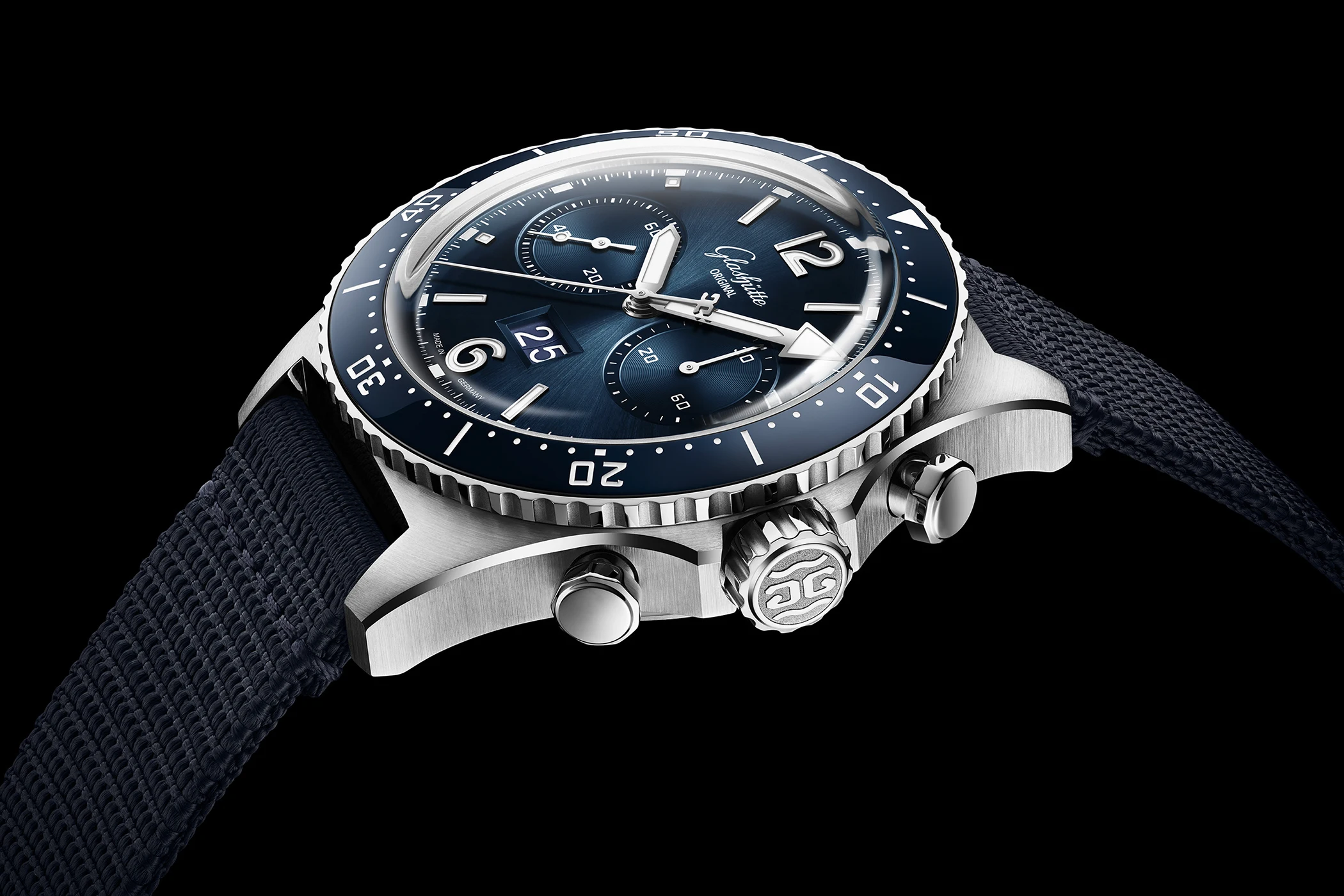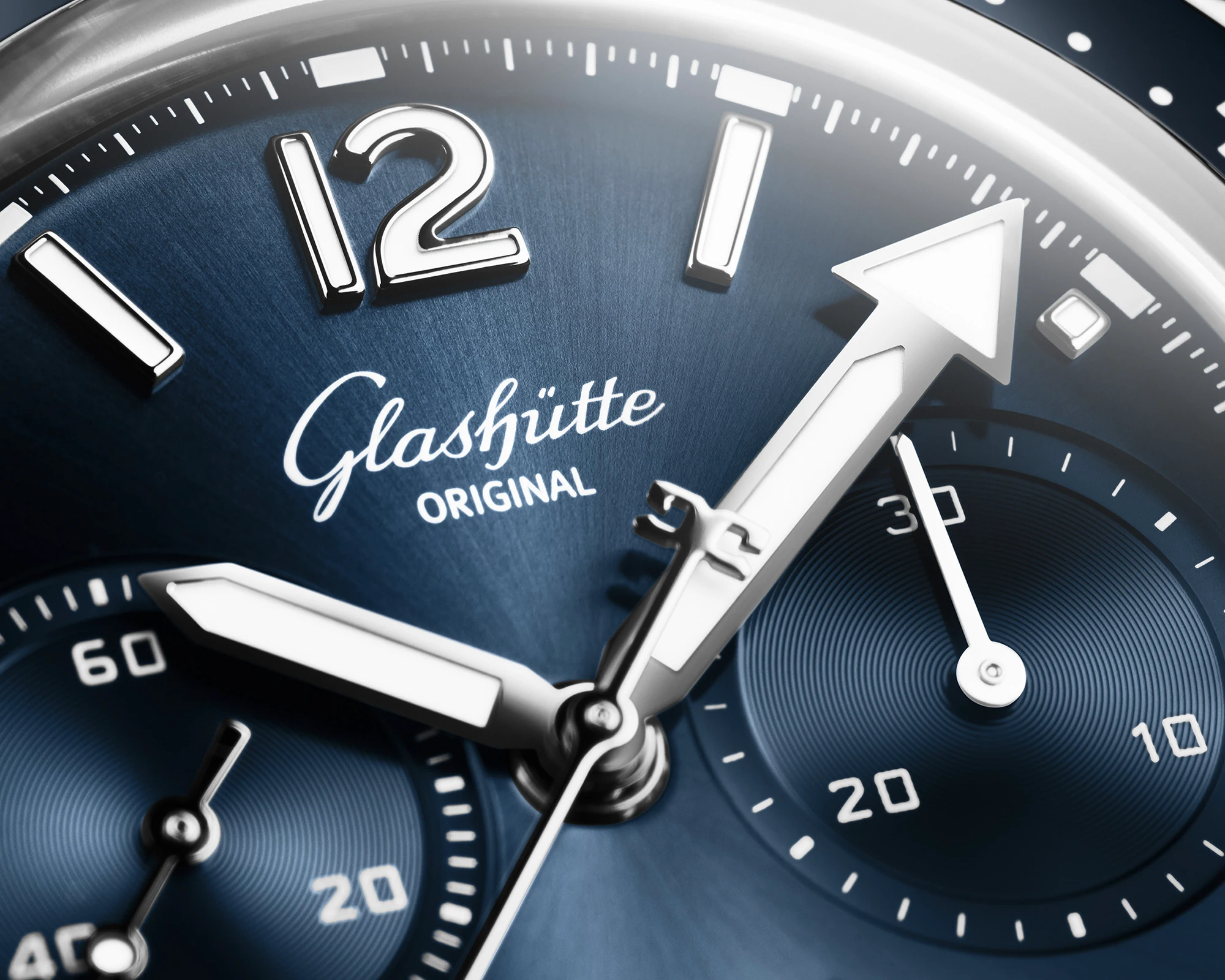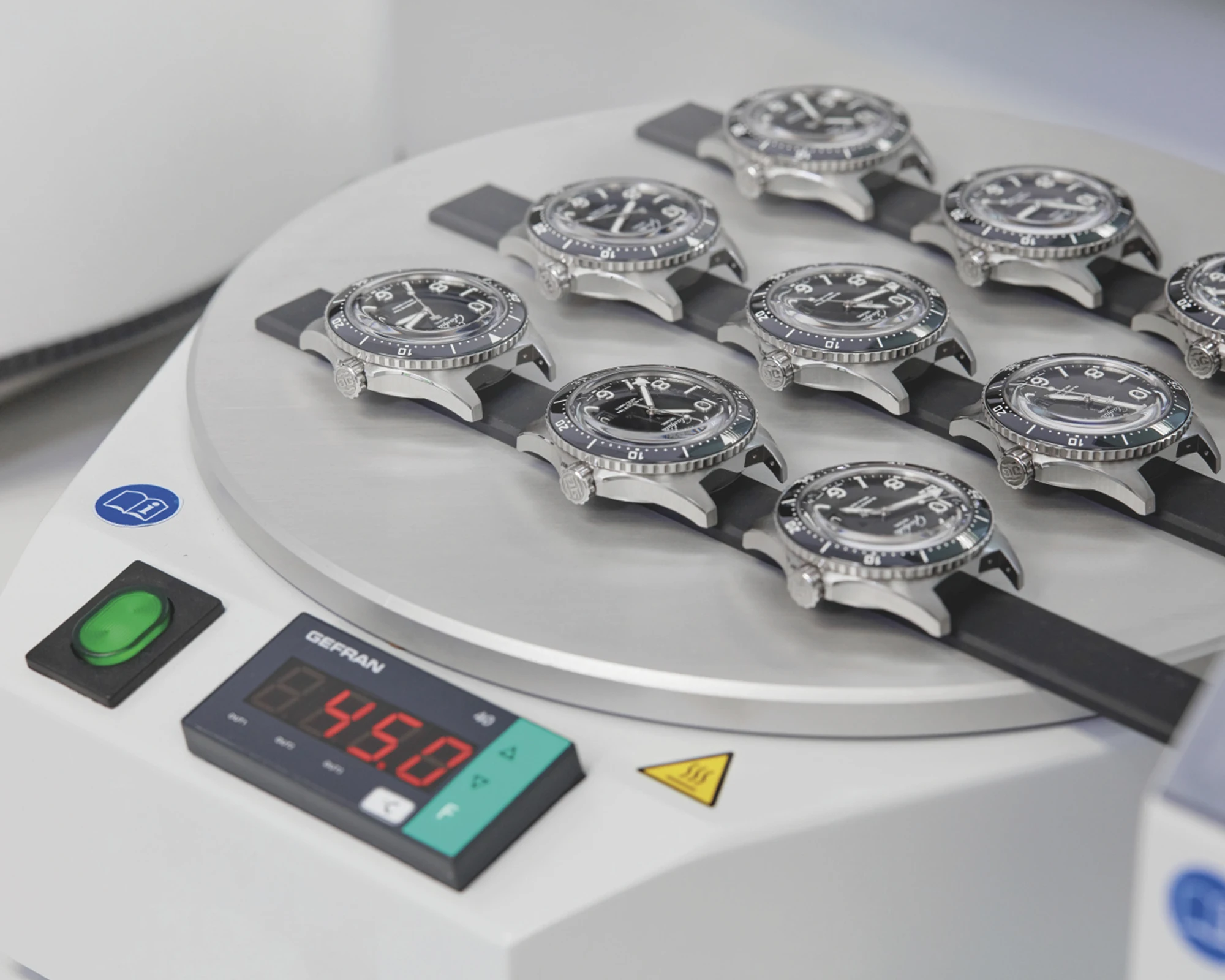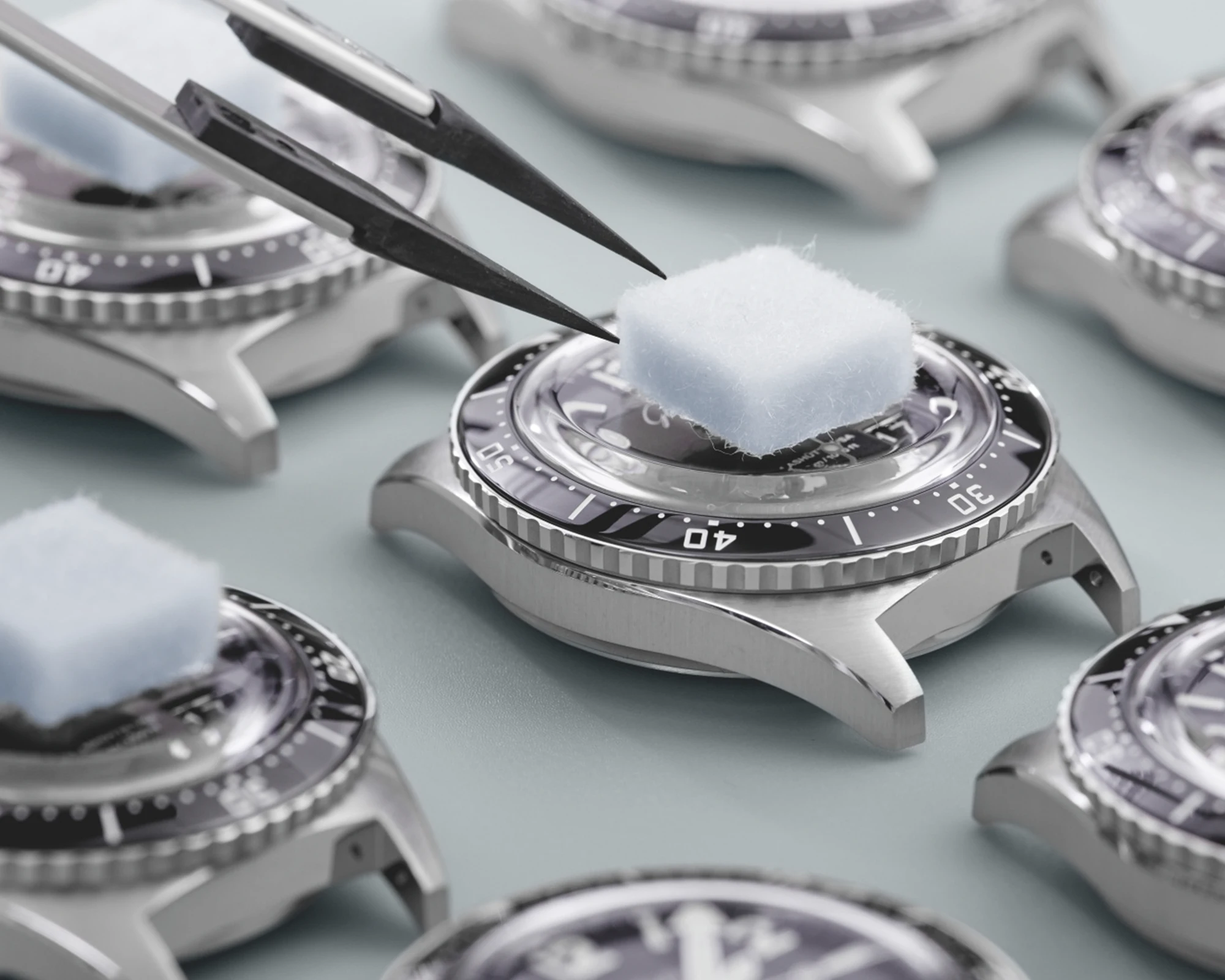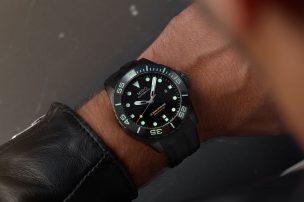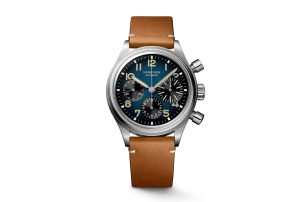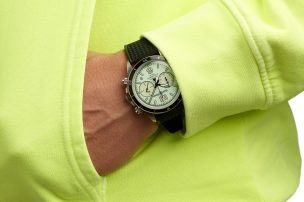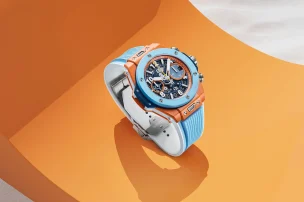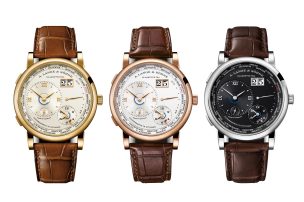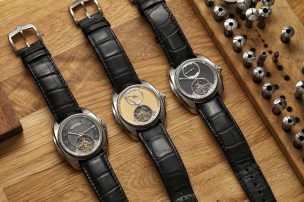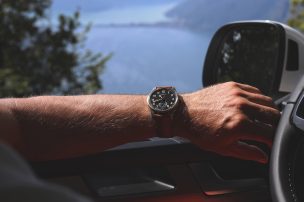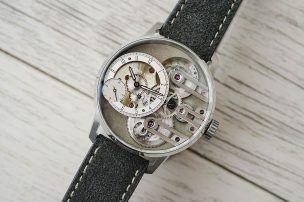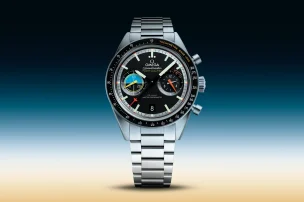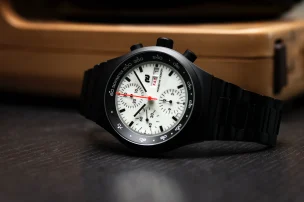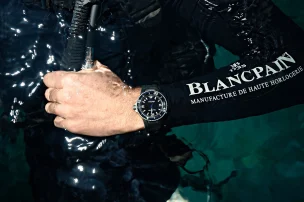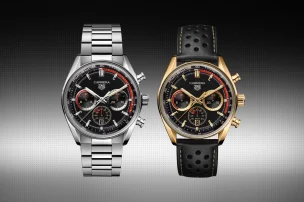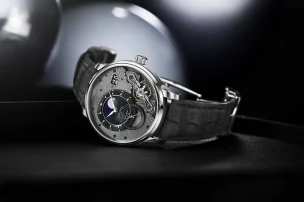
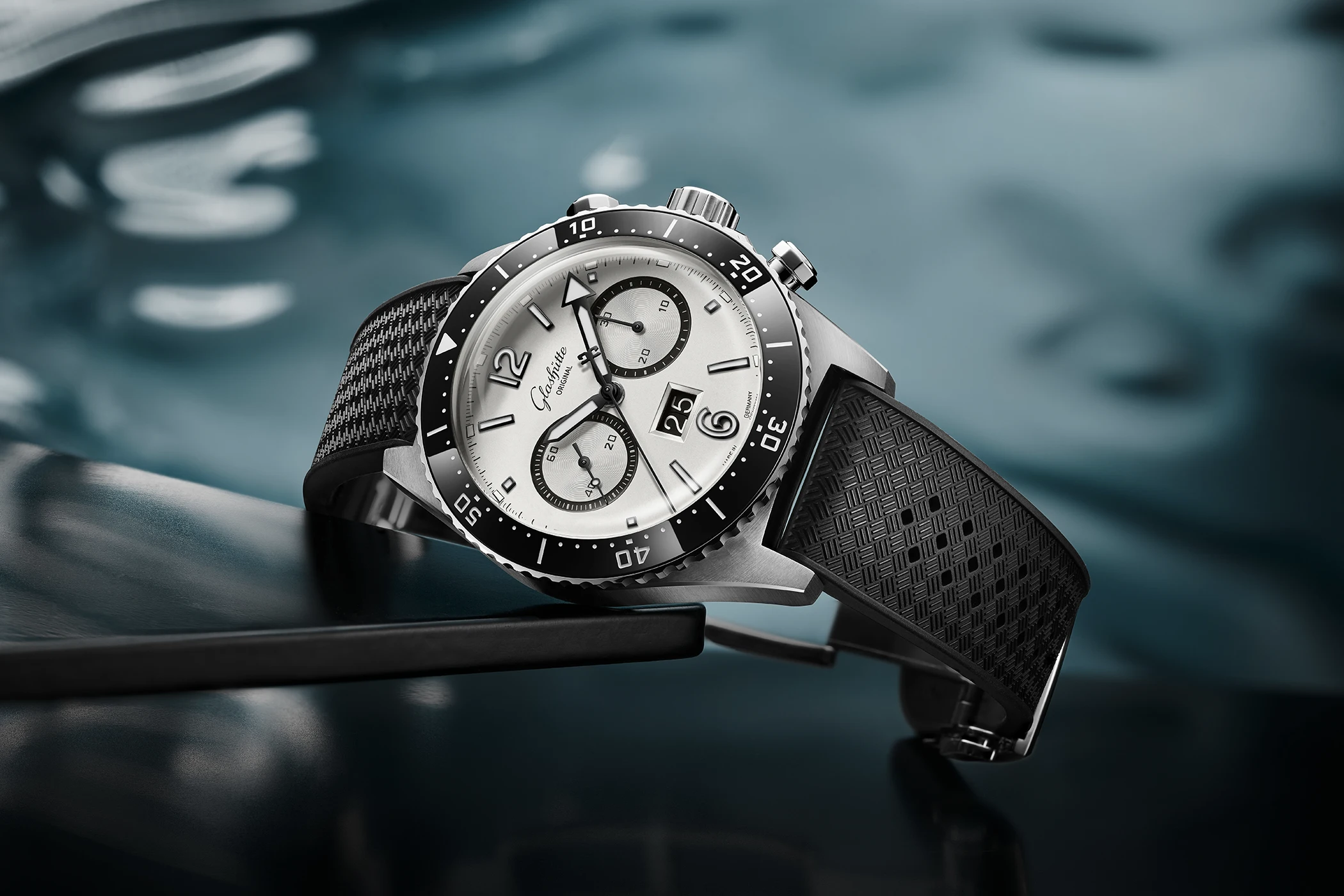
Diver’s Watches Made In Germany: An Overview Of The Glashütte Original SeaQ-Series
Timepieces promising the highest level of precision and craftsmanship are known to come from Switzerland. But horological precision can also be ‘made in Germany’, just as Glashütte Original proves in the diver’s watch category. Although diver’s watches do not centre around major complications, which are regarded as the pinnacle of watchmaking, they are nevertheless technically demanding as they must be able to withstand all elementary adversities. But what does a timepiece need in order to be a vital aid for divers in the dark blue depths of the sea and also a suitable accessory for a blazer on land? Glashütte Original provides an answer with its SeaQ models from its Spezialist collection. To mark the recent launch of the new SeaQ Chronograph in the colour ‘Silver Screen’, we will take a deep dive into the history of the SeaQ and its unique ‘Made in Germany’ features.
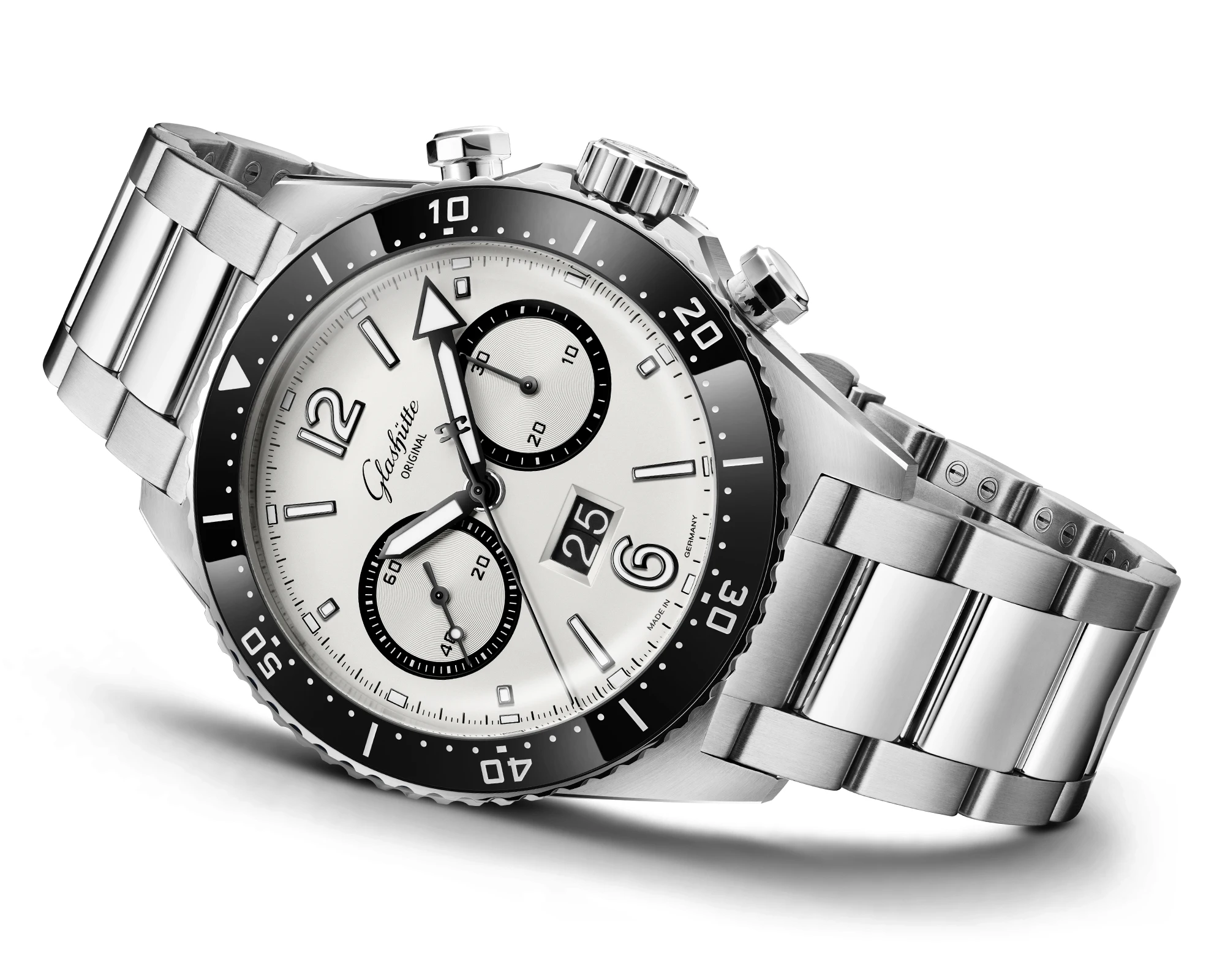
The new SeaQ Chronograph with a dial in the colour ‘Silver Screen’.
1969: The birth of the first diver’s watch made in Glashütte
Before we turn our attention to the Spezialist collection, we need to take a brief look at the inspiration behind the SeaQ models: the first diver’s watch from Glashütte, launched at the end of the 1960s and a timepiece of great importance to the brand.
While diver’s watches experienced a real boom in the West due to the growing popularity of sport diving in the 1960s, the diver’s watch made in Glashütte was initially developed for usage by the NVA. Only later was it made available to a small circle of non-professional divers. However, diving was not a particularly common sport in the German Democratic Republic. One reason for this was that trends from the West, such as the James Bond watches, did not cross the Iron Curtain that quickly. Another one was that the government wanted to restrict any means of escaping the republic. As a result, the first diver’s watch from Glashütte, launched in 1969 under the name Spezimatic Type RP TS 200, initially only had a limited user circle. The production of durable timepieces was not new territory for the experienced brand, whose origins date back to 1845. As early as the 19th century, marine chronometers were among the products manufactured in Glashütte in Saxony. The Spezimatic type RP TS 200 comprised all classic features of a diver’s watch: a graduated rotating bezel with triangular markings for setting the dive time, an hours, minutes and seconds hand on the black dial, luminous material for better readability and a water resistance of 200 metres.
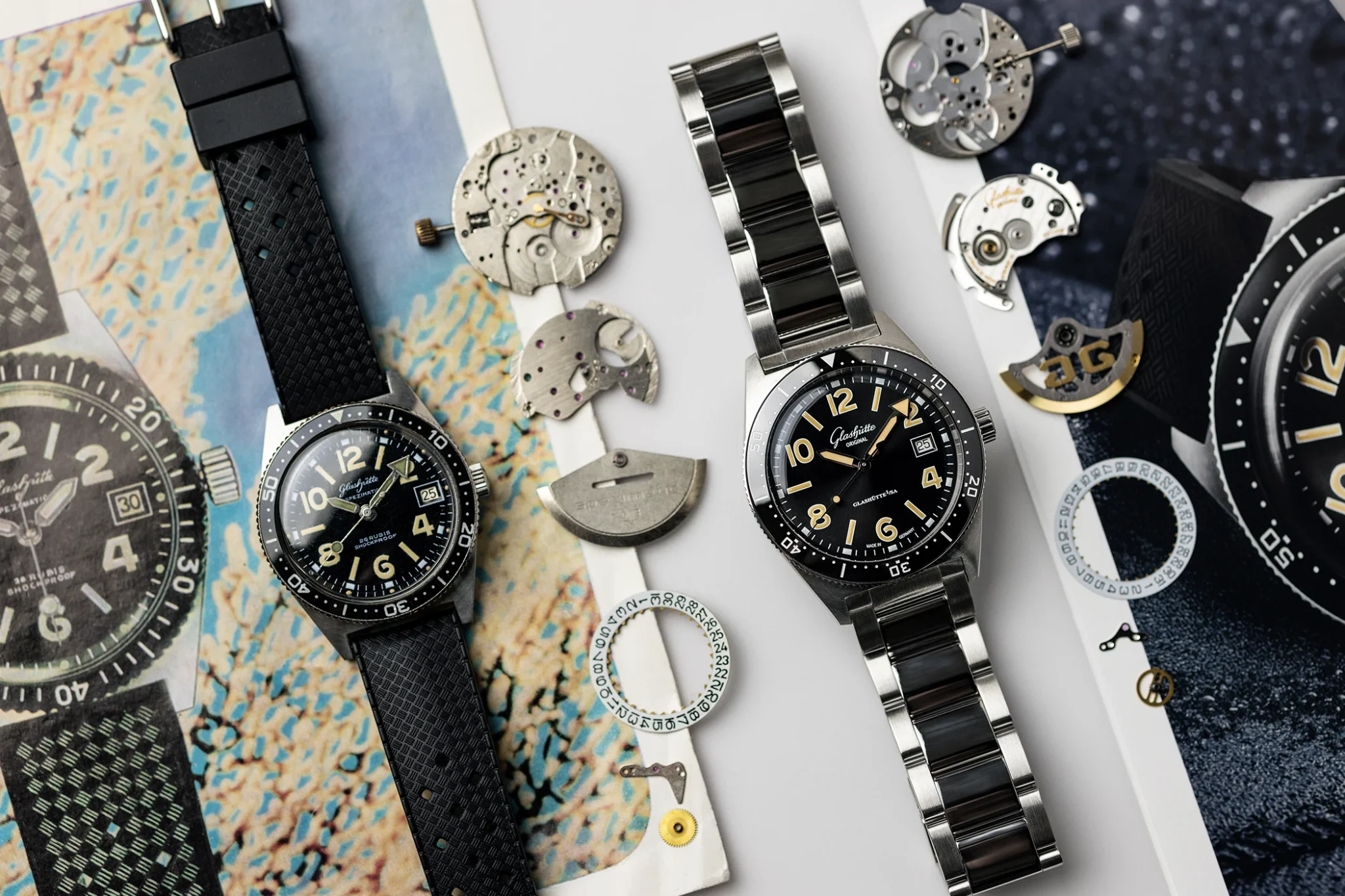
The Spezimatic Typ RP TS 200.
It was especially characterised by the calibre 75, a railway minute track, beige Arabic numerals, striking green arrow hands and a date display at 3 o’clock. In addition, the ‘26 Rubis’ lettering on the dial indicated the number of jewels and ‘Shockproof’ signalled the high durability of the watch at the time. All these qualities were later taken up again by Glashütte Original as the basis for a contemporary diver’s watch collection.
2019: The Spezialist collection
50 years after launching its first diver’s watch, Glashütte Original released the Spezimatic Type RP TS 200-inspired Spezialist collection. It is the brand’s fifth collection and its name refers to the performance of its models as they allow the wearer to accurately determine the time and their position – whether on water, land, or up in the air. Therefore, the collection is currently made up of the robust SeaQ models.
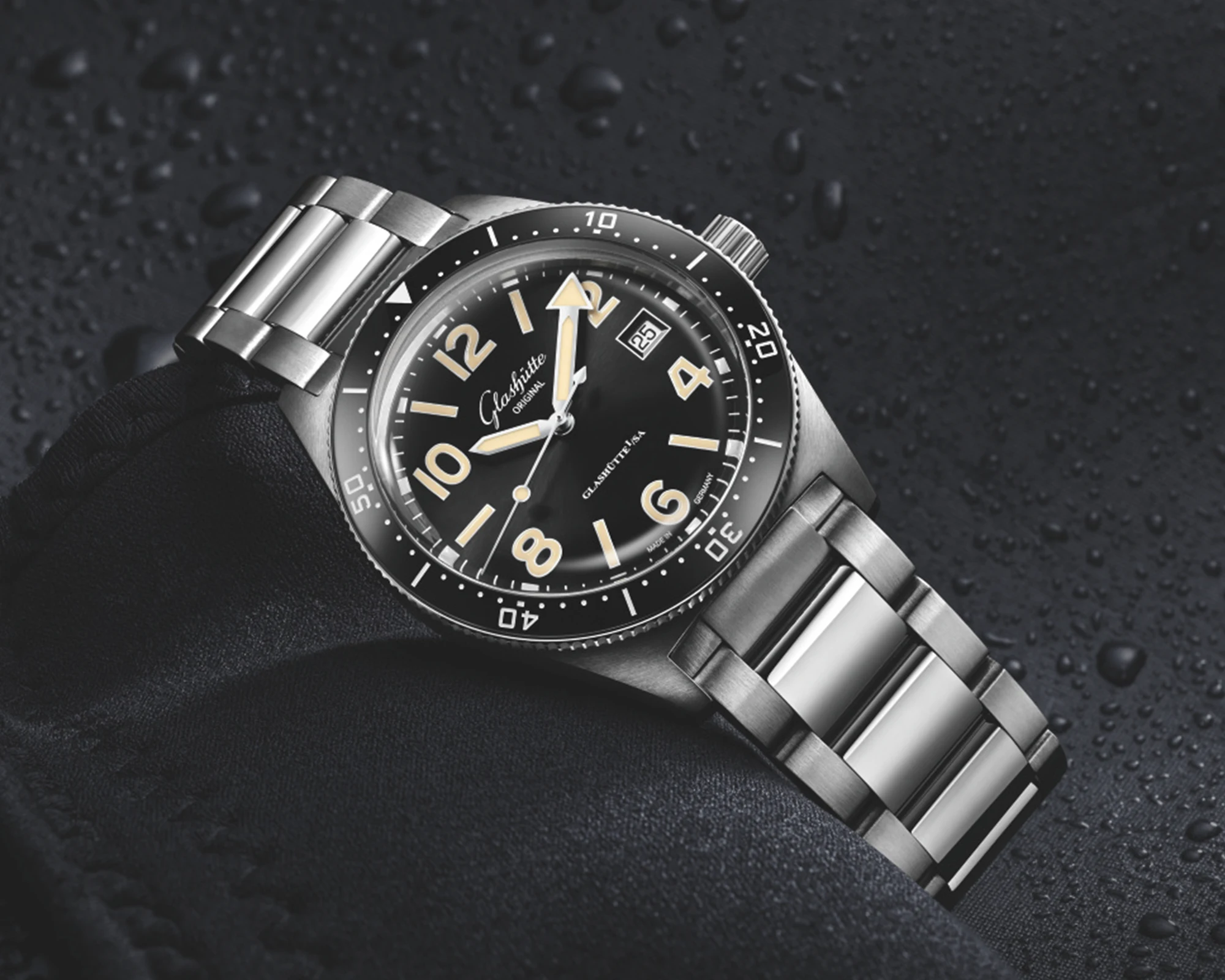
The first SeaQ-Modell Ref. 13911068070 from 2019.
First and foremost, these diver’s watches are equipped to withstand a wide range of external influences and fulfil the highest quality standards. In addition to their functionality, however, they are also designed to be a versatile everyday companion. After all, not everyone who wears a diver’s watch these days is a water sports enthusiast or dives as a hobby. In the following article, we will take a closer look at the individual SeaQ models to examine how Glashütte Original bridges the gap between functionality and a sophisticated design suited for everyday use.
Three lines: SeaQ, SeaQ Panoramadatum und SeaQ Chronograph
All good things come in threes, and thus the Spezialist collection is divided into three different SeaQ lines: SeaQ, SeaQ Panorama Date and SeaQ Chronograph. Although these three lines differ in terms of their functionality as well as their colours and materials, they have one thing in common: their design is based on that of the Spezimatic type RP TS 200. But before we explore the models released over the years, it is worth finding out more about how they are manufactured.
Manufactured in-house: The SeaQ dials
A certain purism is essential for diver’s watches to not distract from their vital functions for underwater use. For example, the readability of the dial is crucial. Therefore, it has become common practice to use dark colours for diver’s watch dials as they offer the greatest possible contrast by highlighting the hands and appliqués. However, this does not mean that there is no room for creativity when it comes to the dial’s design. Glashütte Original primarily works with different colour techniques and cuts.
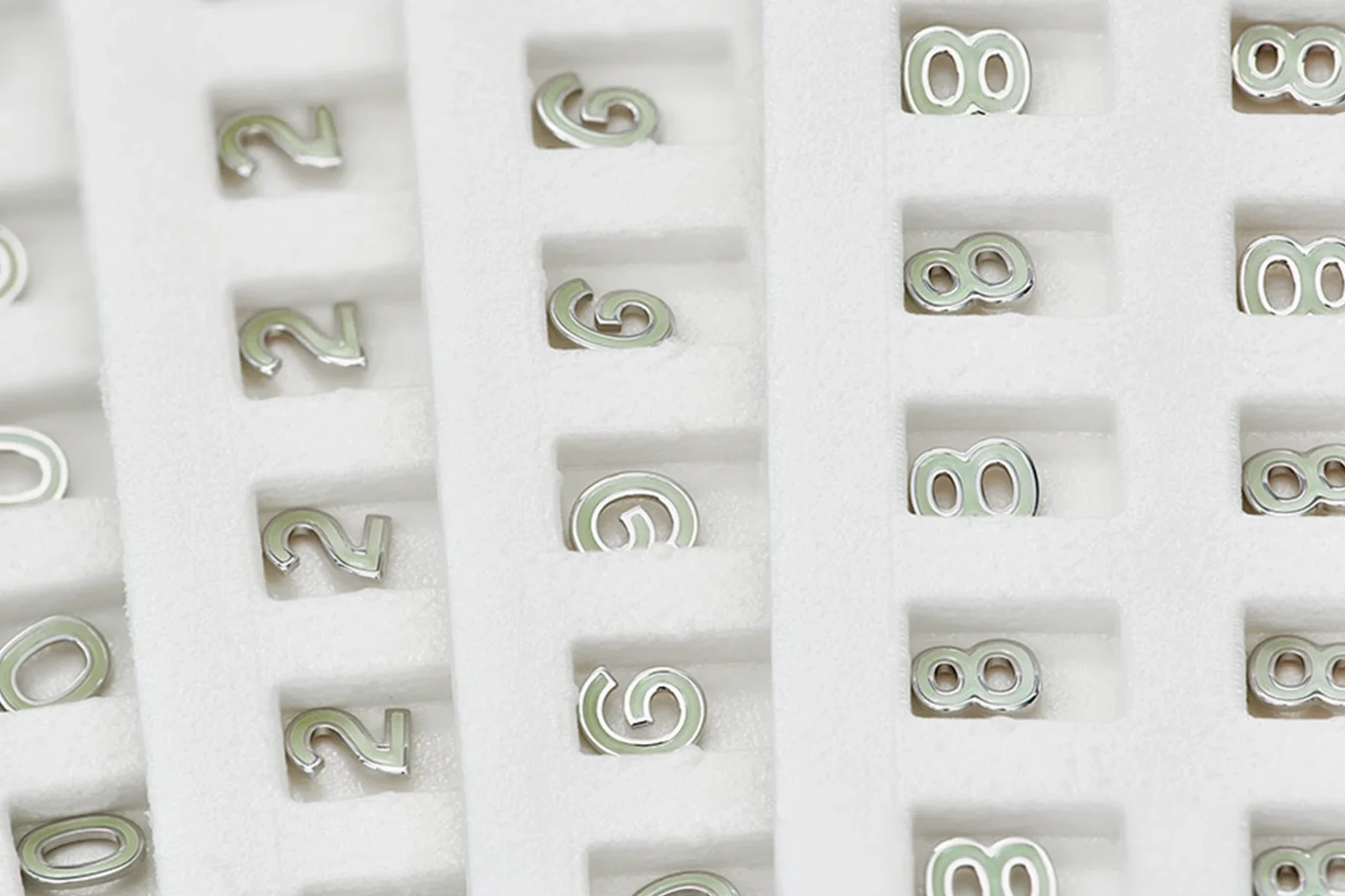
The brand produces the dials for all SeaQ models in its own dial manufacture– a rarity in the luxury watch industry these days. The different dial variants, such as the four variations for the premiere models, are meticulously handcrafted here. For example, there were two 30.5 mm dial versions for the SeaQ based on the historical model in black with a sunray finish, each with different lettering and a date window at 3 o’clock. The two dial variants in blue or black for the SeaQ Panorama Date, on the other hand, were larger with a diameter of 33.1 mm. But how were they created?
From blank to finished dial
A blank made from a brass strip is used to create and gradually give the dial its final shape. To facilitate processing during the various work steps, the edge of the blank is provided with two studs and later with four catch holes that are pressed into the material. The date window is then inserted and a decorative frame is embossed around the window, followed by the creation of a central hole to which the hands are attached.
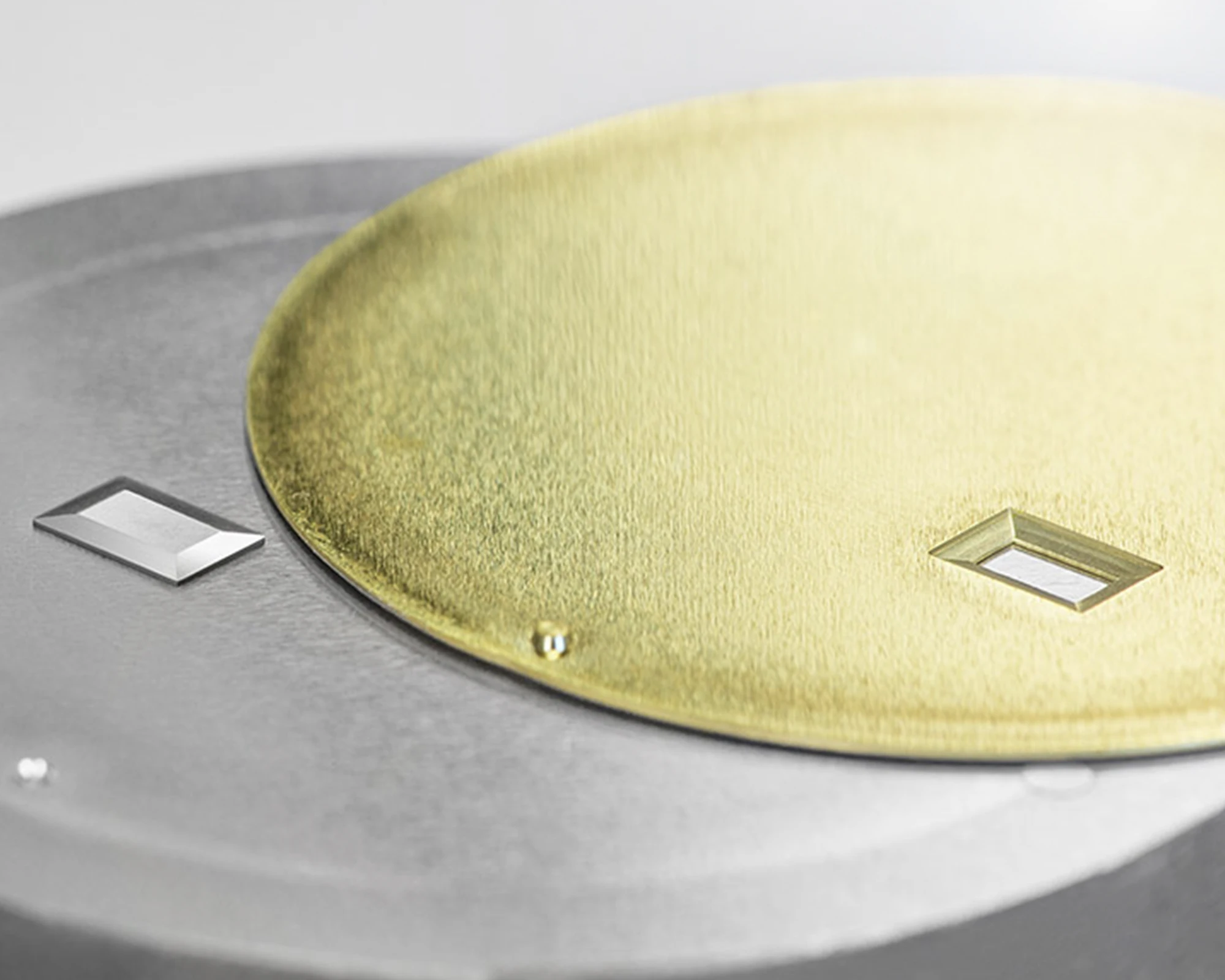
With the exception of the SeaQ with a black dial, delicate holes are drilled into the material to enable the subsequent attachment of the appliqués. Their backs are later welded to the small appliqué feet. At last, the dial is punched out of the brass strip with its final diameter.
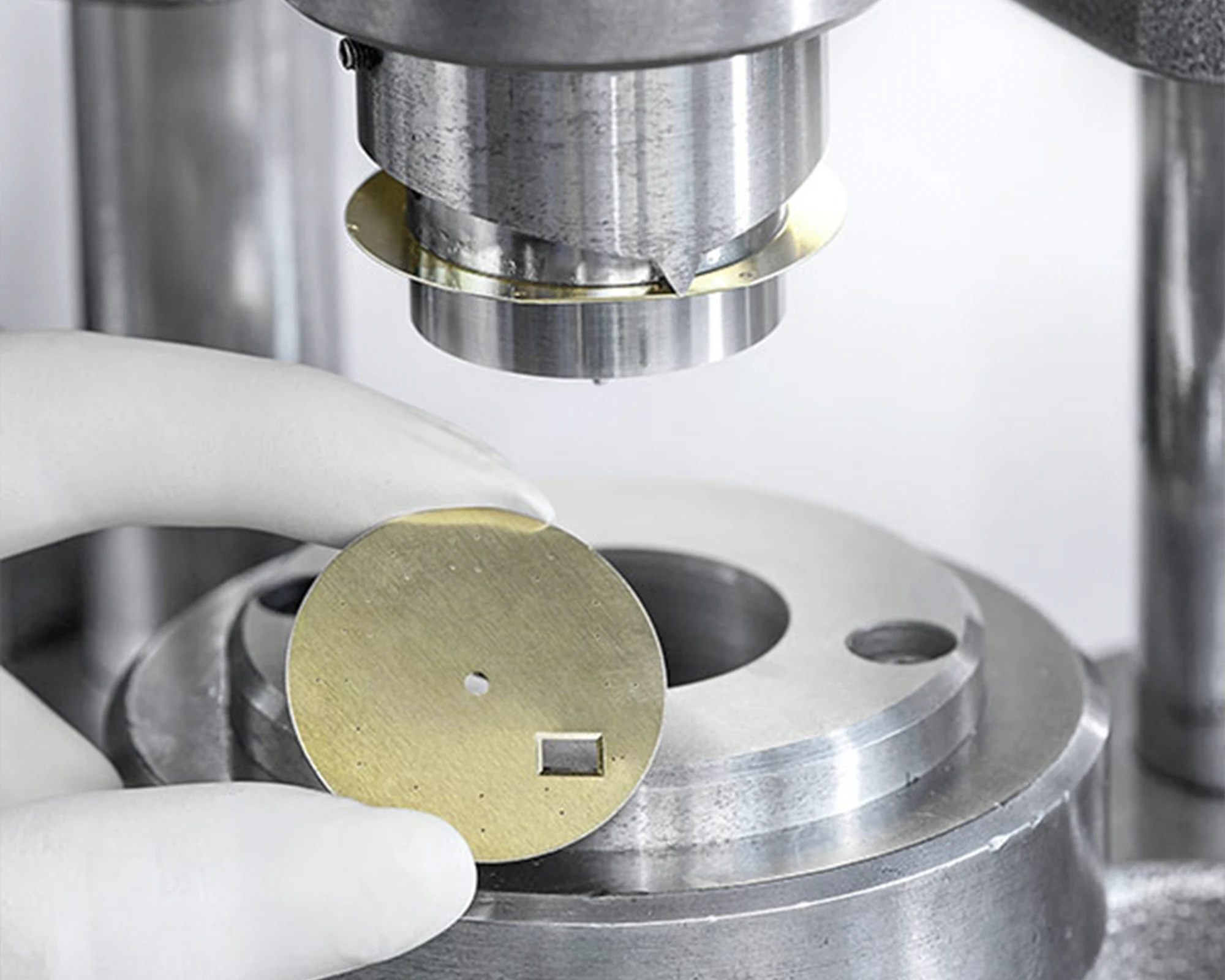
The punched-out dial of a SeaQ Panorama Date.
Subtile Details: Sunray decoration
After treating the dial using a grinding and polishing machine with an emulsion, the sunray decoration is applied manually using a vertically rotating brass brush, giving the dial its subtle yet expressive appearance.
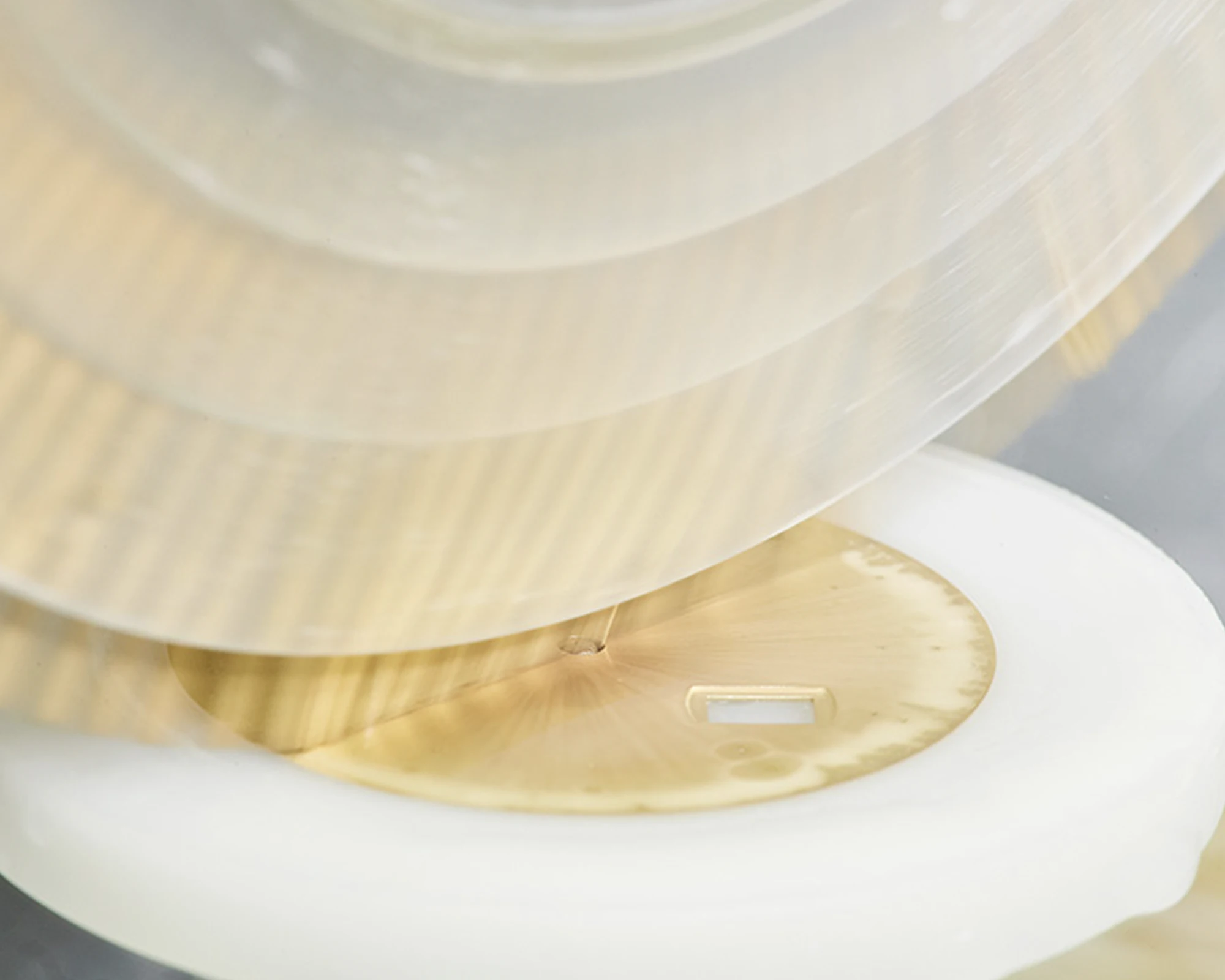
Moreover, this look is enhanced through galvanisation, a technique that gives the dials their colour using electrolysis. Once the process is complete, the dial is rinsed with water and dried.
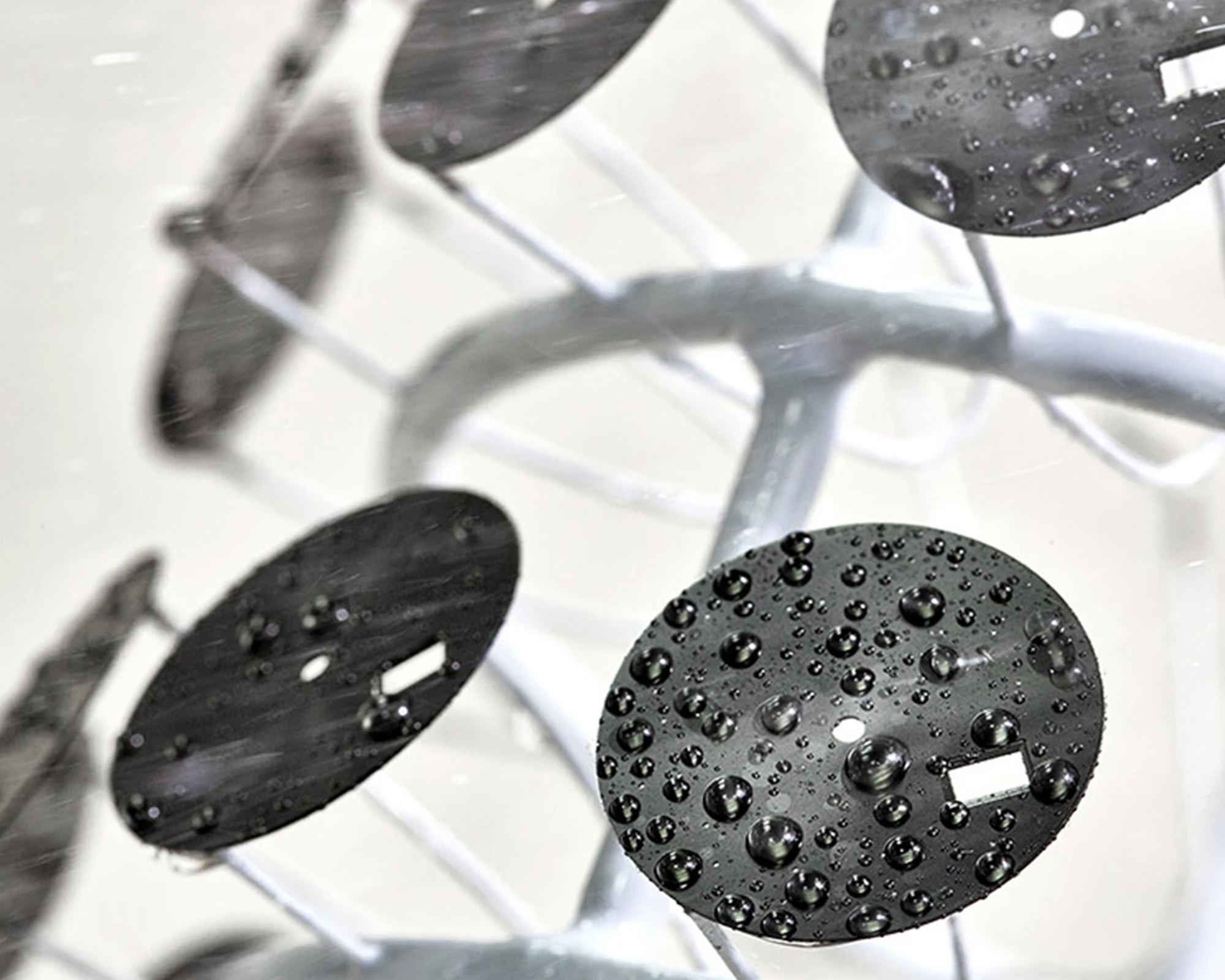
However, not all SeaQ models are galvanised and embellished with a sunray decoration. For example, the 2021 SeaQ in reed green is an exception. To create its aesthetic, the green colour is hand-sprayed onto the dial which is then placed in an oven for drying.
Application and printing
All other details are then added to the dial. The logo, lettering, and minute track of the SeaQ, SeaQ Panorama Date, and SeaQ Chronograph dials are all pad-printed. For this printing process, white ink is taken up from a printing plate by a soft silicone balloon (pad) and printed onto the dial like a stamp with the accuracy of a hundredth of a millimetre. The numerals and indexes are then applied and filled with Super-LumiNova.
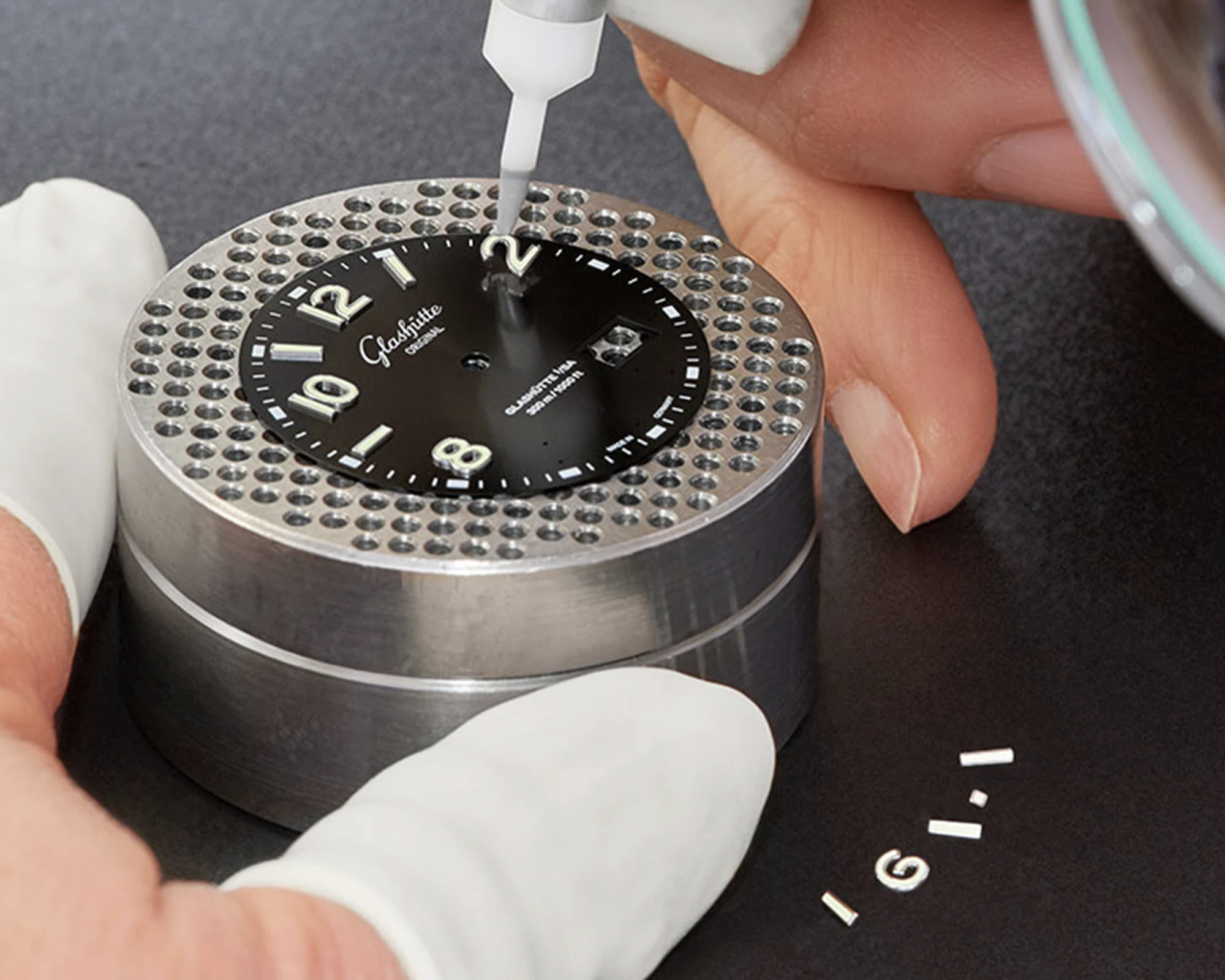

The only exception is the SeaQ from 2019 with its black dial. In order to closely resemble its historical reference model, the index lines and numerals are not applied. Instead, they are also transferred to the dial using a pad printing process with a light-coloured primer. All the other details are then added in a second step, as with the other models.
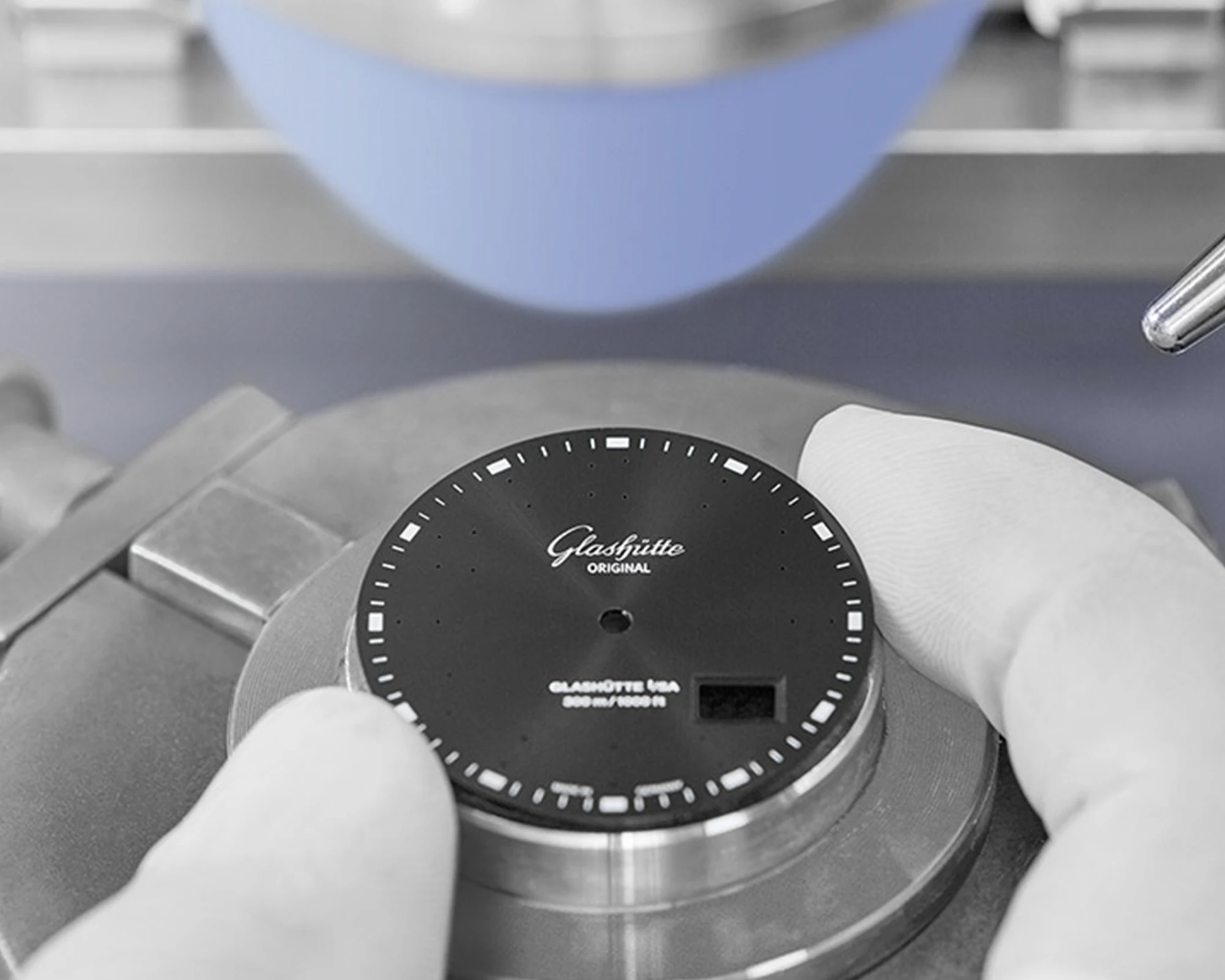
To improve their legibility, the base-coated numerals and indexes are hand-coated in Super-LumiNova. After a rigorous quality control, the dials are finally assembled. Let’s take a closer look at the various outcomes.
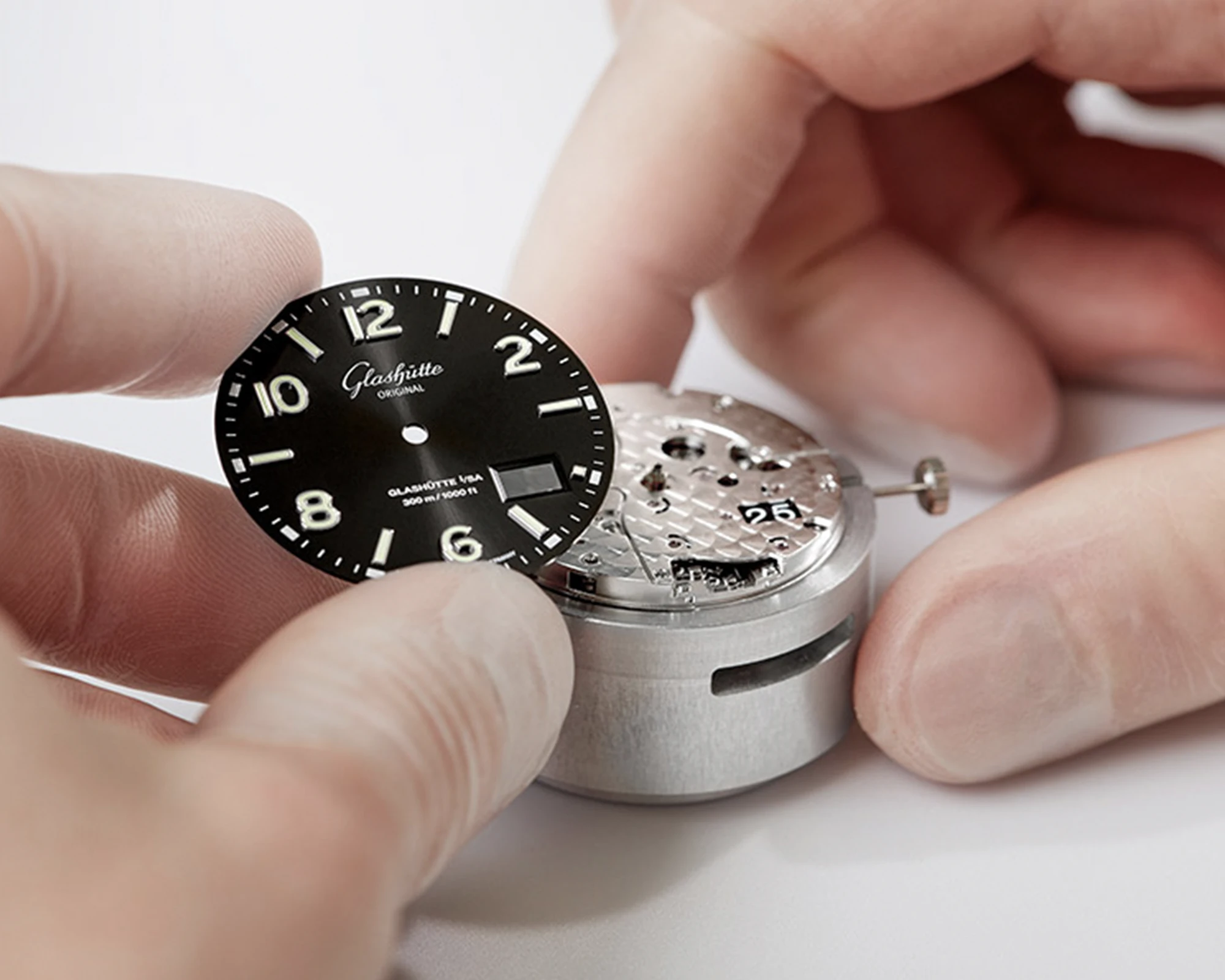
Launch of the SeaQ line
The line kicked off with the launch of the SeaQ, which is ‘simpler’ than the other models, in 2019. All models of this type have a case measuring up to 39.5 mm in diameter with a height of 12.15 mm, which is water-resistant to a depth of 200 metres. For greater durability and safety, their fluted bezel is fitted with a scratch-resistant ceramic insert and can only be turned anti-clockwise to prevent accidental adjustment.
On the dial, hour, minute and second hands indicate the time using a railway minute track and applied Arabic numerals and baton indices. The date display is at 3 o’clock. Furthermore, the SeaQ models are powered by the automatic manufacture calibre 39-11 with a heavy metal oscillating weight and a frequency of 4 Hz. The movement has a stop-seconds function and a solid power reserve of 40 hours.
SeaQ 2019
Two SeaQ models were launched in 2019: the series-produced SeaQ and the limited-edition SeaQ 1969. The series version of the SeaQ features a combination of a polished and satin-finished stainless steel case, a black bezel with a ceramic insert, and a matching galvanic black dial.

Arabic numerals, index markers and hands in the historic beige hue ‘Old Radium’ indicate the time on the sunray-finished dial. Like the minute track and triangular markings on the unidirectional rotating bezel, they also glow blue in low lighting thanks to Super-LumiNova.
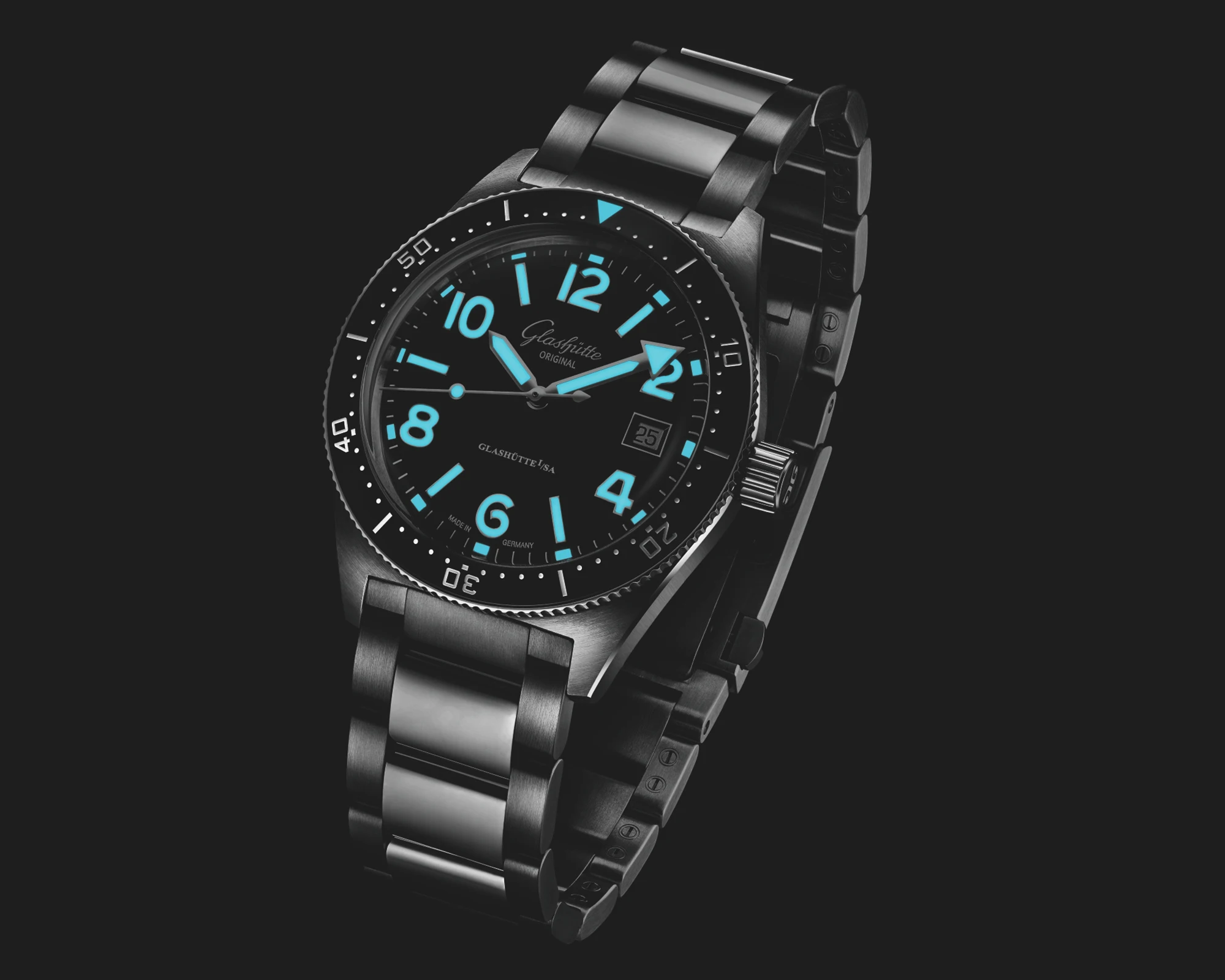
When turning the timepiece over, viewers are greeted by the sight of a maritime engraving. The caseback features a trident symbol with the brand’s double G emblem on its handle and 20 waves in the background, which symbolise the watch’s water resistance of 20 bar. Additionally, there is a consecutive serial number on the baseplate, which is aligned and fixed in this position by a threaded base ring.
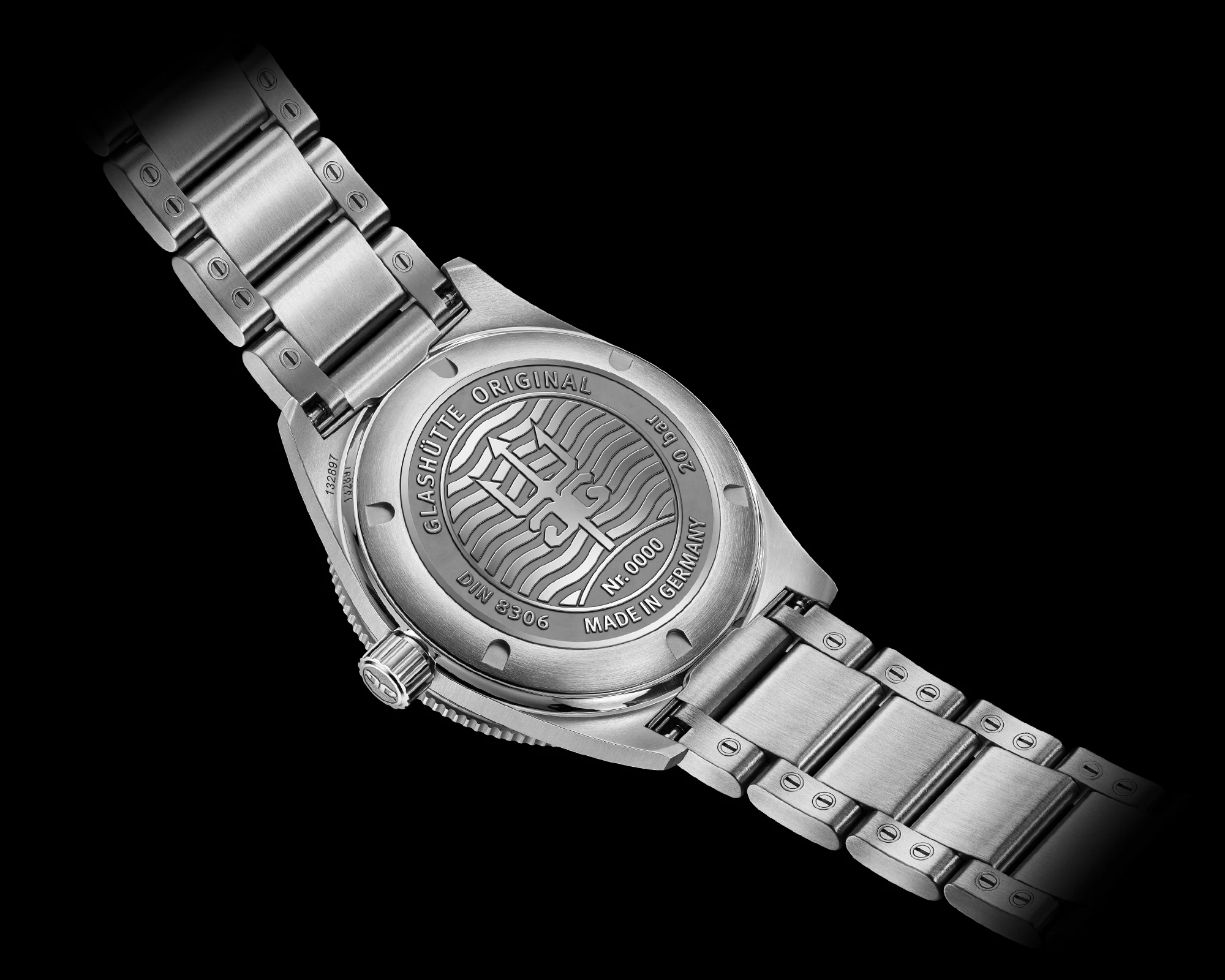
For collectors: SeaQ 1969
With the limited SeaQ 1969, Glashütte Original introduced a tribute to the 50th anniversary of its first diver’s watch. Its design has a strong resemblance to the original design of the Spezimatic Type RP TS 200. The limited edition’s dial is galvanised black with a sunray finish, just like the series-produced version. In contrast to the latter, however, the ‘25 Rubis’ and ‘shockproof’ letterings – based on the historical model – are found below the hands. The first lettering indicates the number of jewels, while ‘shockproof’ emphasises the brand’s promise of quality regarding the watch’s shock resistance. Unlike the SeaQ, the hands here are green. The indexes and Arabic numerals are also in the colour ‘Old Radium’. Here too, Super-LumiNova serves as a luminous reading aid.
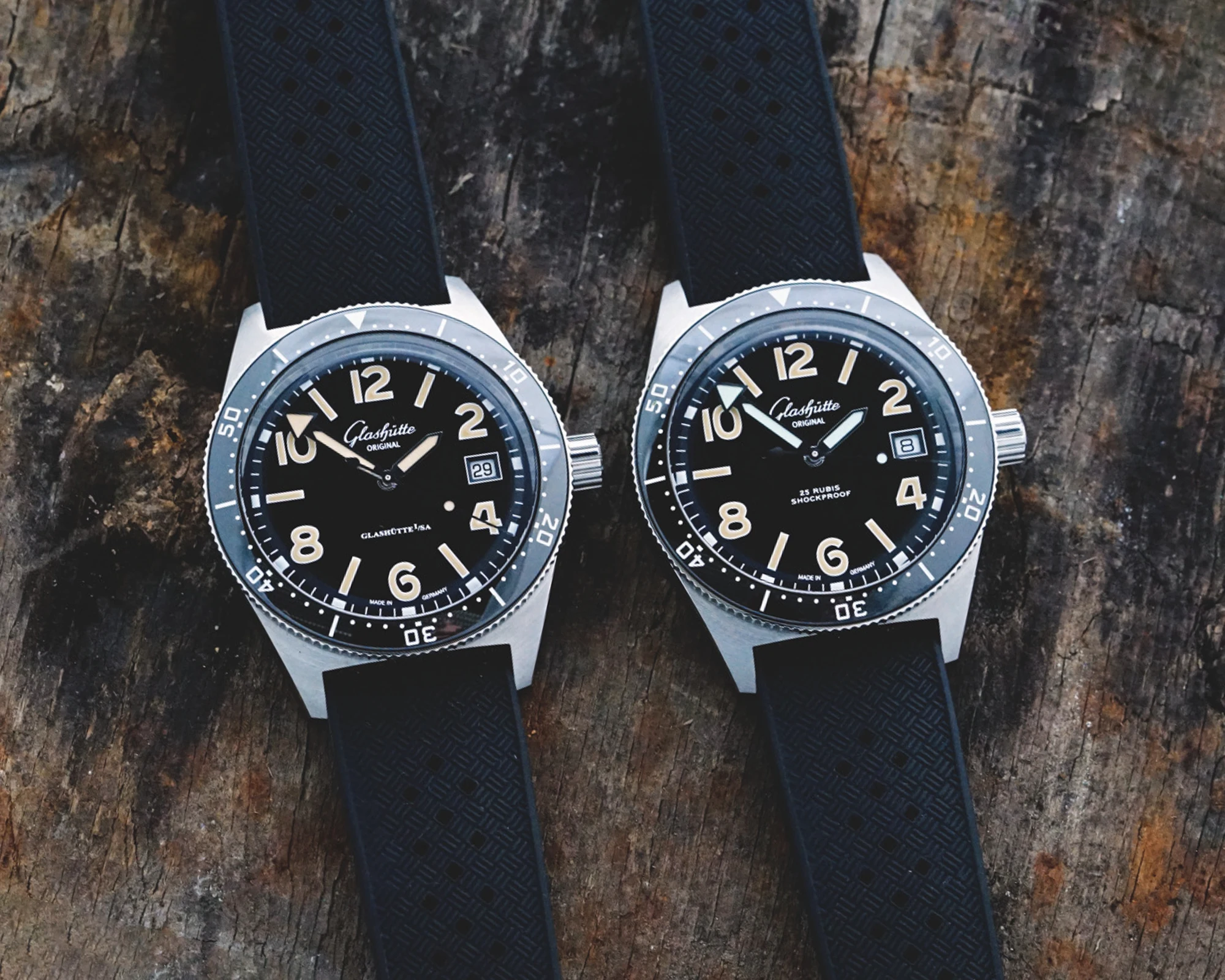
The SeaQ (left) und the limited-edition SeaQ 1969 (right) from 2019.
In contrast to the regular SeaQ, the engraved number on the caseback plate shows the limitation number of 69 pieces instead of a serial number. The number 69 serves as a further allusion to the launch year of the Spezimatic Type RP TS 200.
To safely secure them to the wrist, both the SeaQ and the SeaQ 1969 are complemented by a black rubber strap with a tropico pattern and a water-resistant nylon woven strap with a pin or folding clasp specially developed for the SeaQ. The standard model can also be worn on a flat stainless-steel bracelet with an eight-step fine adjustment mechanism and folding clasp.
Bright blue and sparkling elements for the SeaQ
The following year, Glashütte Original added two new SeaQ versions with a polished satin-finished stainless steel case to the collection. The basic design and functions are similar to the previous model, including a maritime engraving on the caseback. However, there are also a few differences. For example, the sunray dial of the first 2020 version is galvanised blue this time and thus also represents the deep blue of the sea to a certain extent. For a harmonious aesthetic, the ceramic inlay of the rotating bezel is also in the same shade of blue.
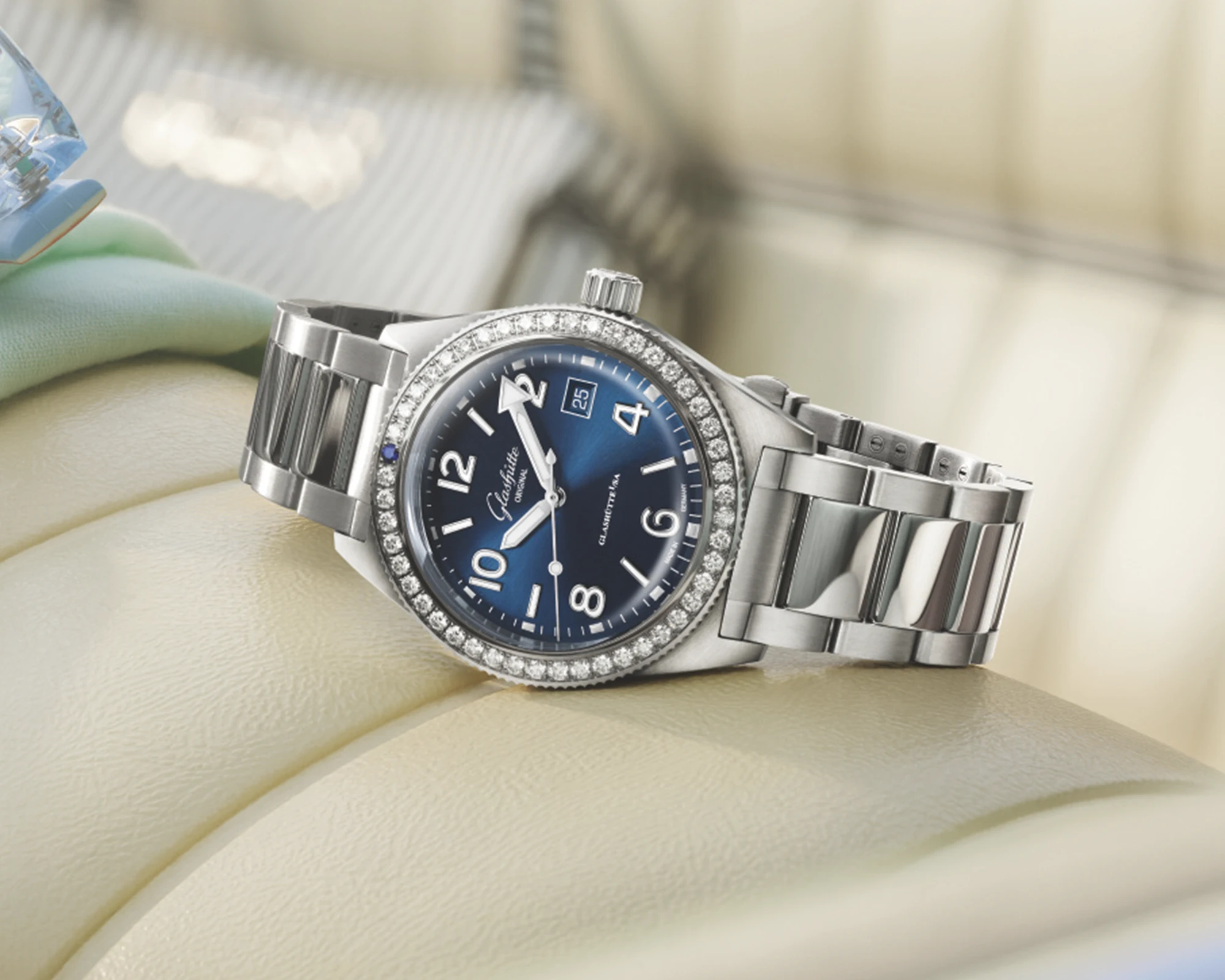
The SeaQ Ref. 13911098270 with a diamond-set bezel and steel bracelet.
For the first time in the collection, there is also a version that takes the diver’s watch in the direction of a dress watch. The second stainless-steel model from 2020, Ref. 13911098270, has an elegant rotating bezel set with 47 brilliant-cut diamonds and a sapphire. The latter adorns the bezel instead of a triangular marking, creating a colourful connection to the deep blue dial. The colouring of the sparkling gemstones gives the timepiece a more elegant appearance than its sibling model without distracting too much from the watch’s functionality.
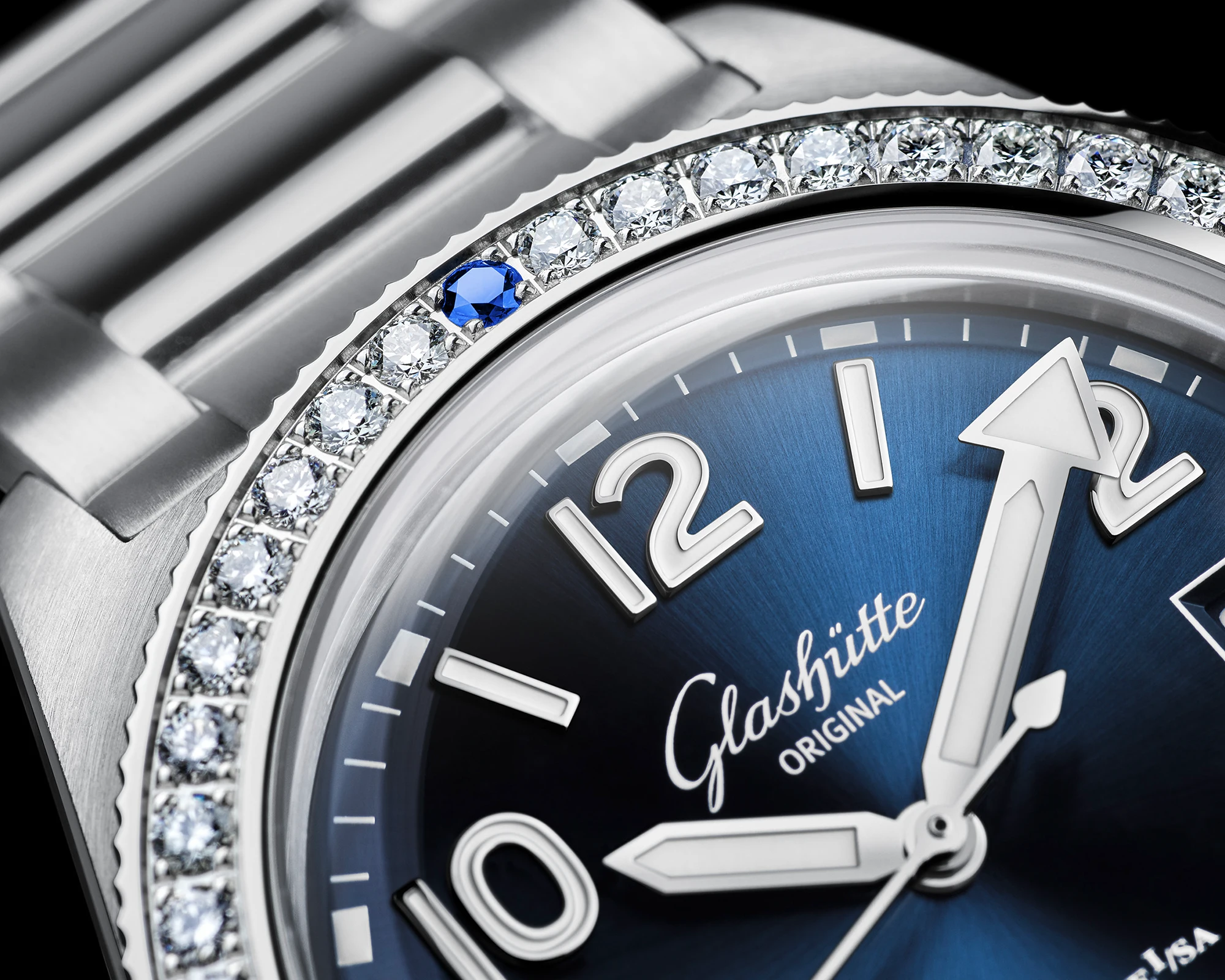
However, there is one small disadvantage: according to DIN and ISO standards, the triangular marking must be luminous so that divers can set their dive time correctly. As this is not the case with a sapphire marking, this is the only criterion that this SeaQ does not fulfil as a diver’s watch. Aside from this exception, it meets the standards just like all other SeaQ models. In addition, both SeaQs from that year can be worn with a stainless steel bracelet with a fine adjustment mechanism or a blue nylon woven strap. For the SeaQ without a diamond bezel, a black rubber strap also offers another sporty wearing option.
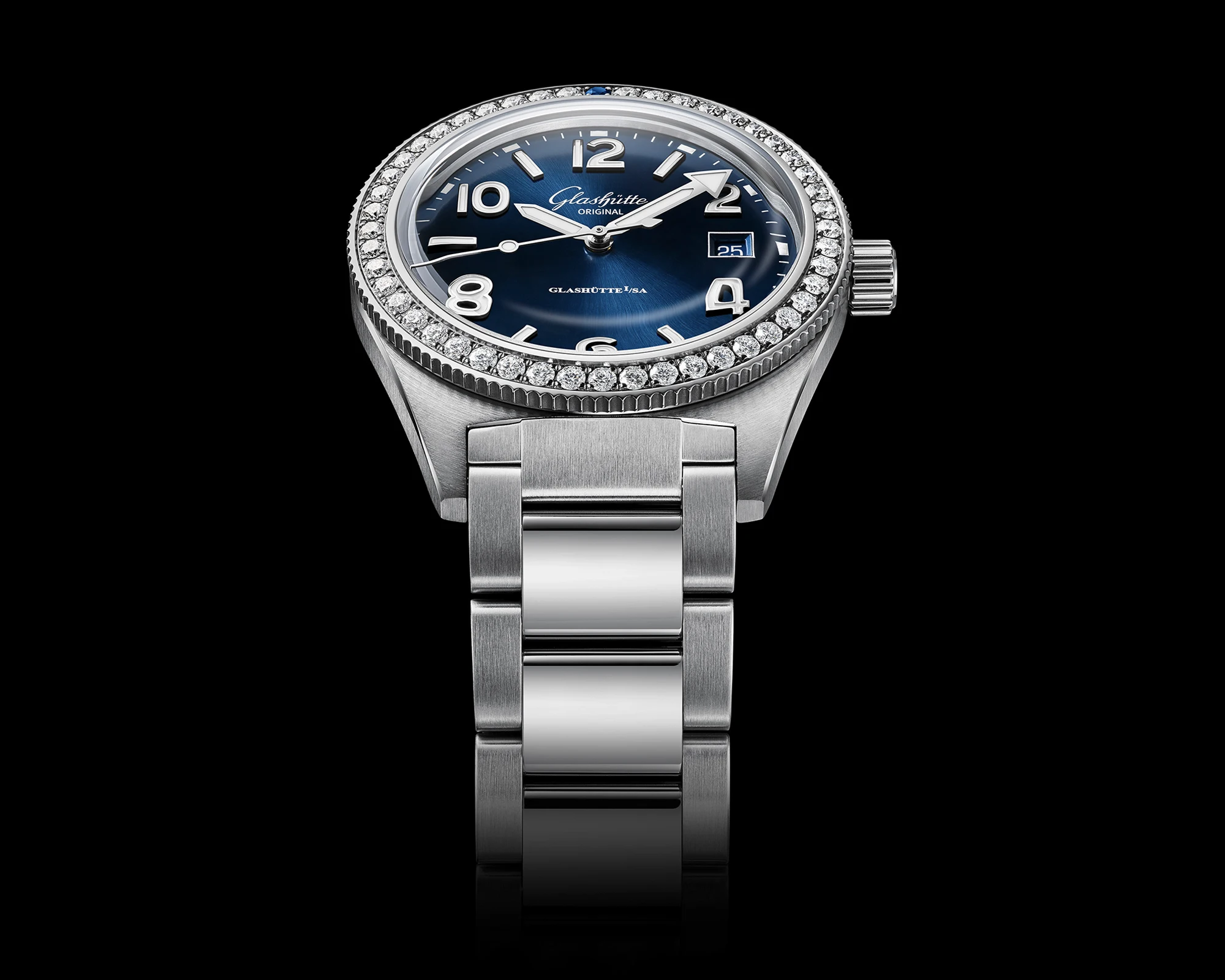
Trending: Green dials
As already described in our editorial on green dials, 2021 was the year that heralded the era of this refreshingly elegant dial colour. That same year, Glashütte Original also jumped on the bandwagon and launched a stainless steel SeaQ with a reed green lacquered dial and matching ceramic bezel inlay.
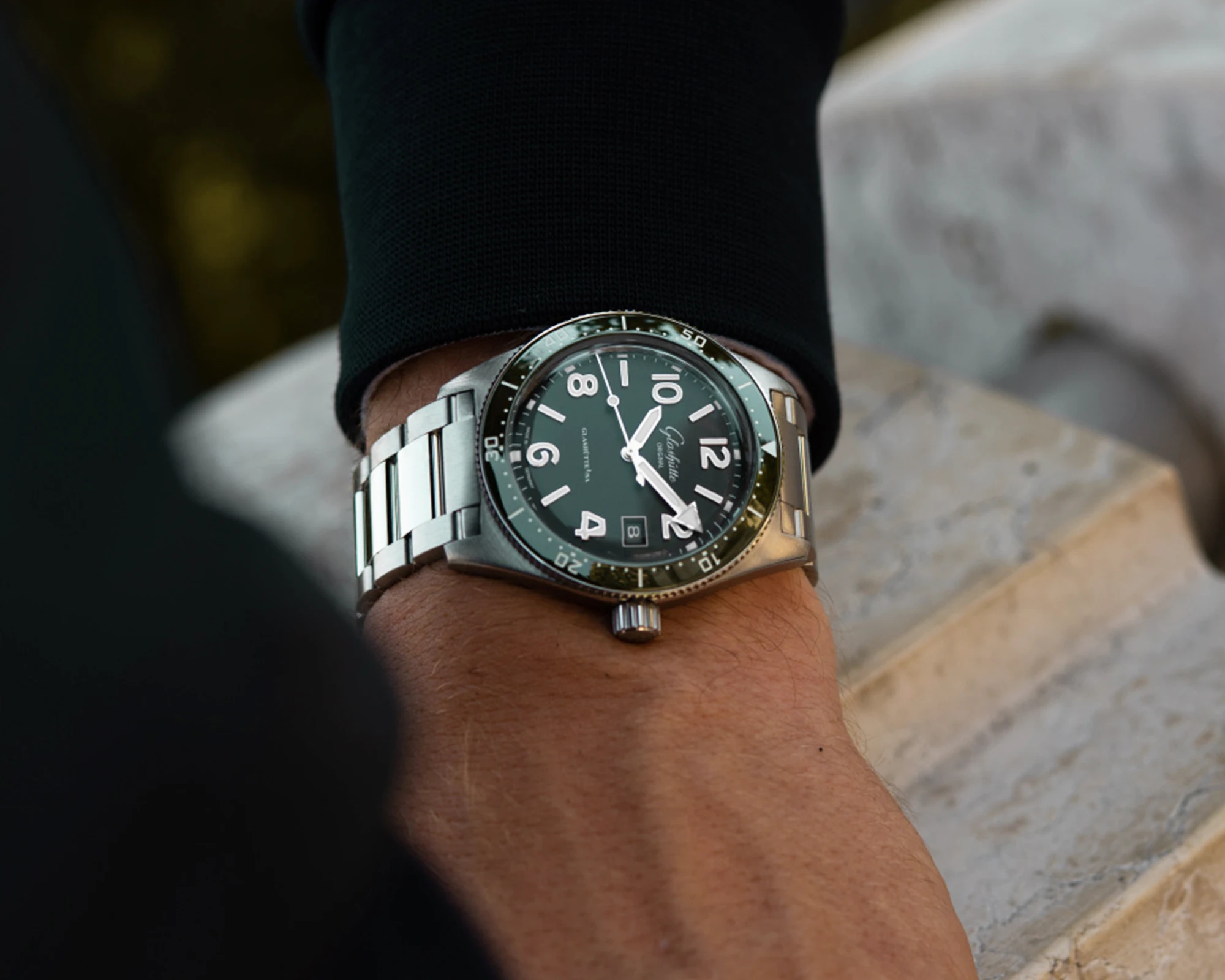
To accentuate the rich, shimmery green, the straps are kept in muted colours. A black rubber strap or grey synthetic strap with a pin buckle or folding clasp as well as a stainless steel bracelet are available.
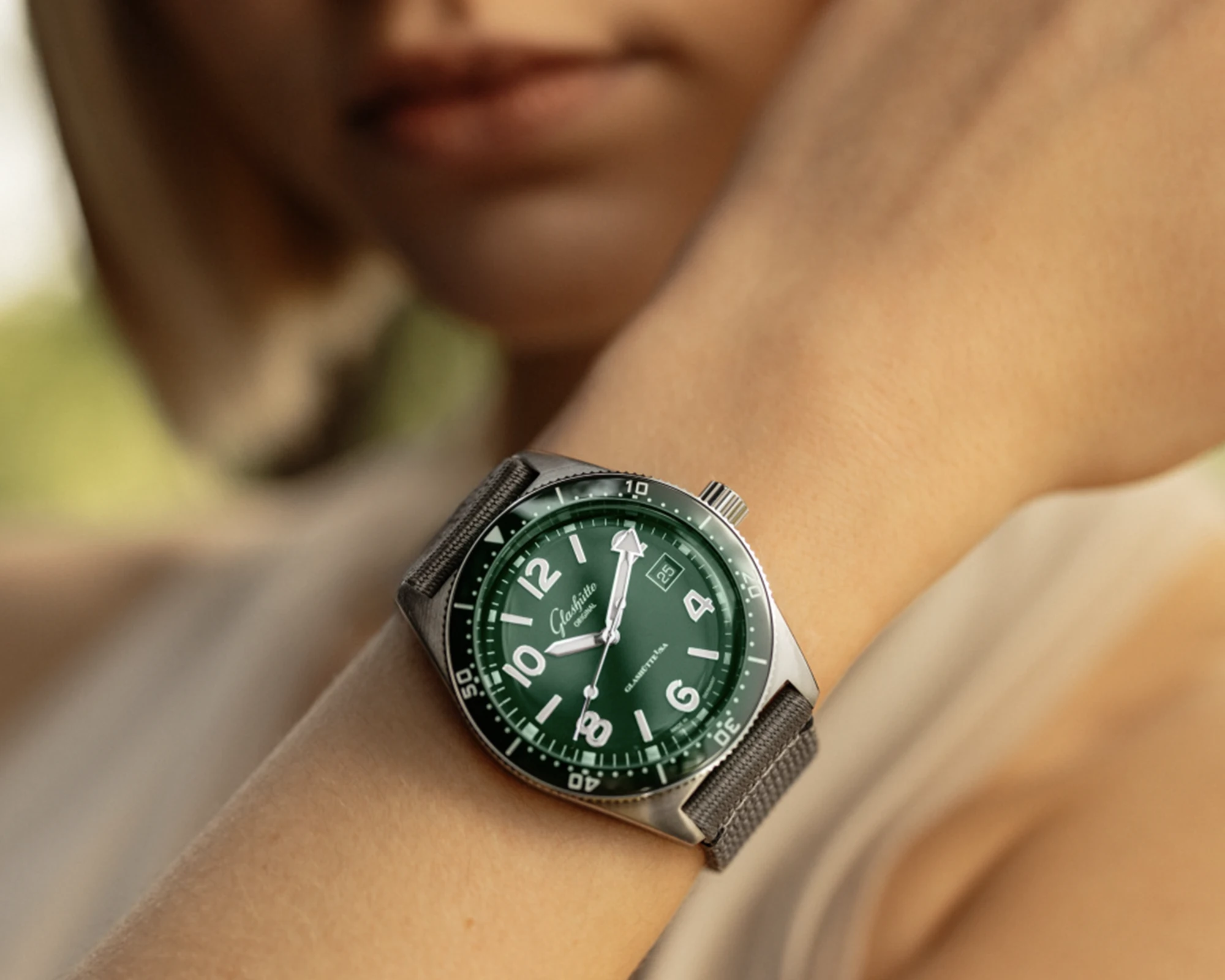
Another trend that Glashütte Original picked up on in the same year was a bicolour version made of stainless steel and yellow gold with a galvanic blue dial with a sunray finish (Ref. 13911109034).
Time to shine: The red-gold SeaQ
In May 2022, Glashütte Original expanded its SeaQ product range by introducing a variant in 5N red gold. For the first time, the SeaQ case was available in a material other than stainless steel and featured a sapphire crystal caseback.
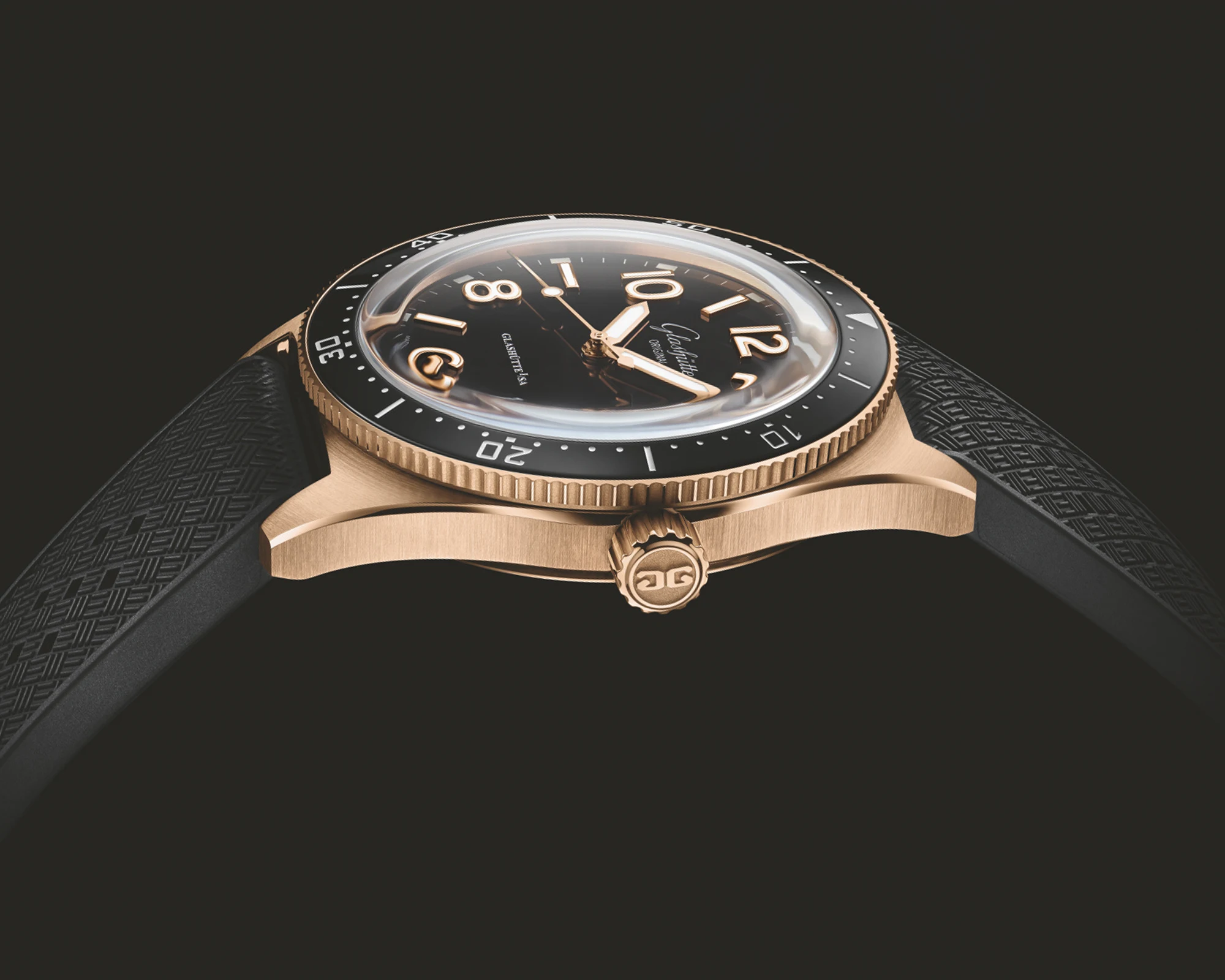
The rest of the timepiece is kept in a dark colour to provide the greatest possible contrast highlighting the red-gold colour of the case and the outline of the applied numerals, indices, and hands. As a result, both the galvanised, sunray dial and the bezel’s ceramic inlay are black.
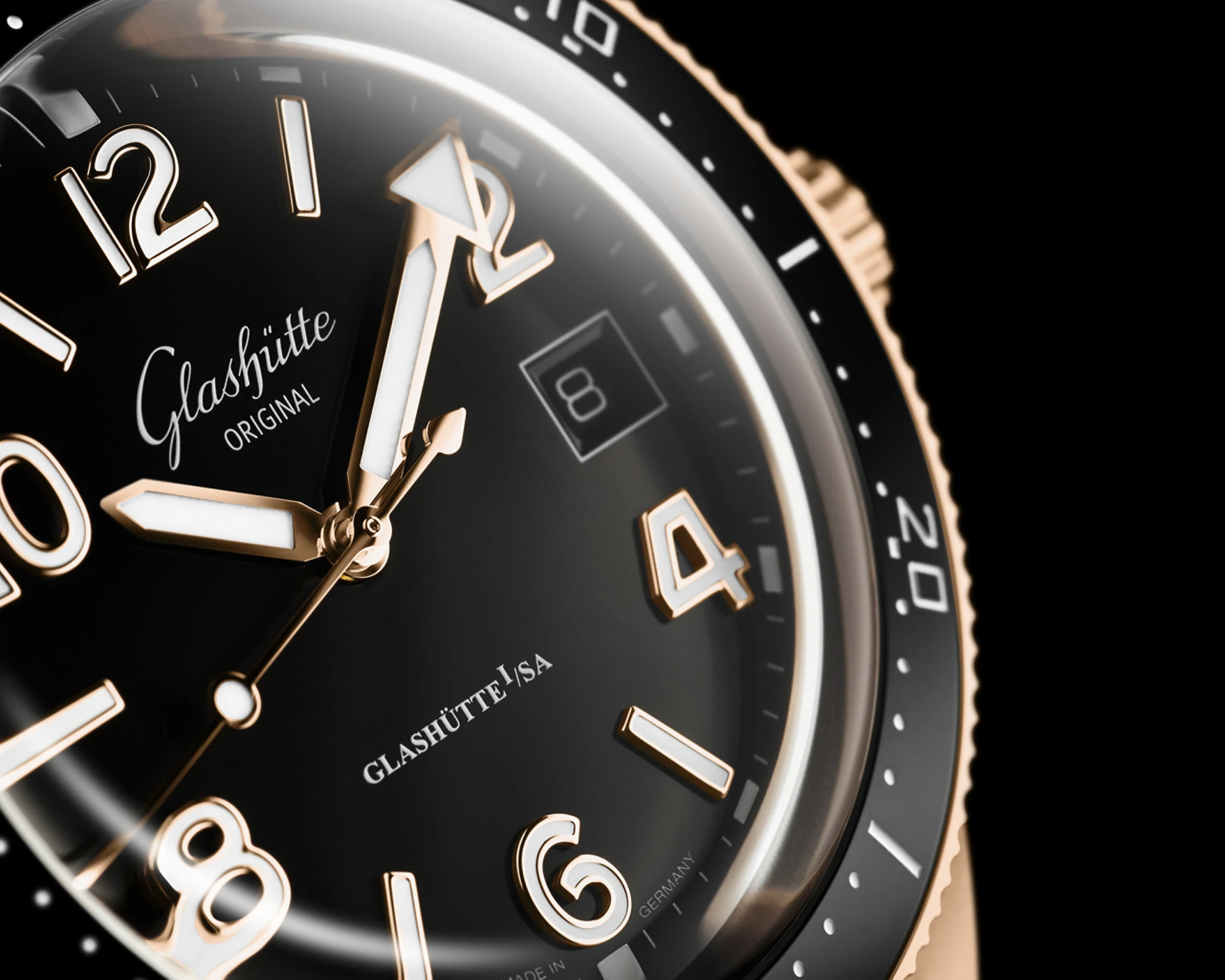
The combination of red gold with a dark colour is also reflected in the straps: a black rubber strap or a grey synthetic strap are complemented by a red-gold double folding clasp.
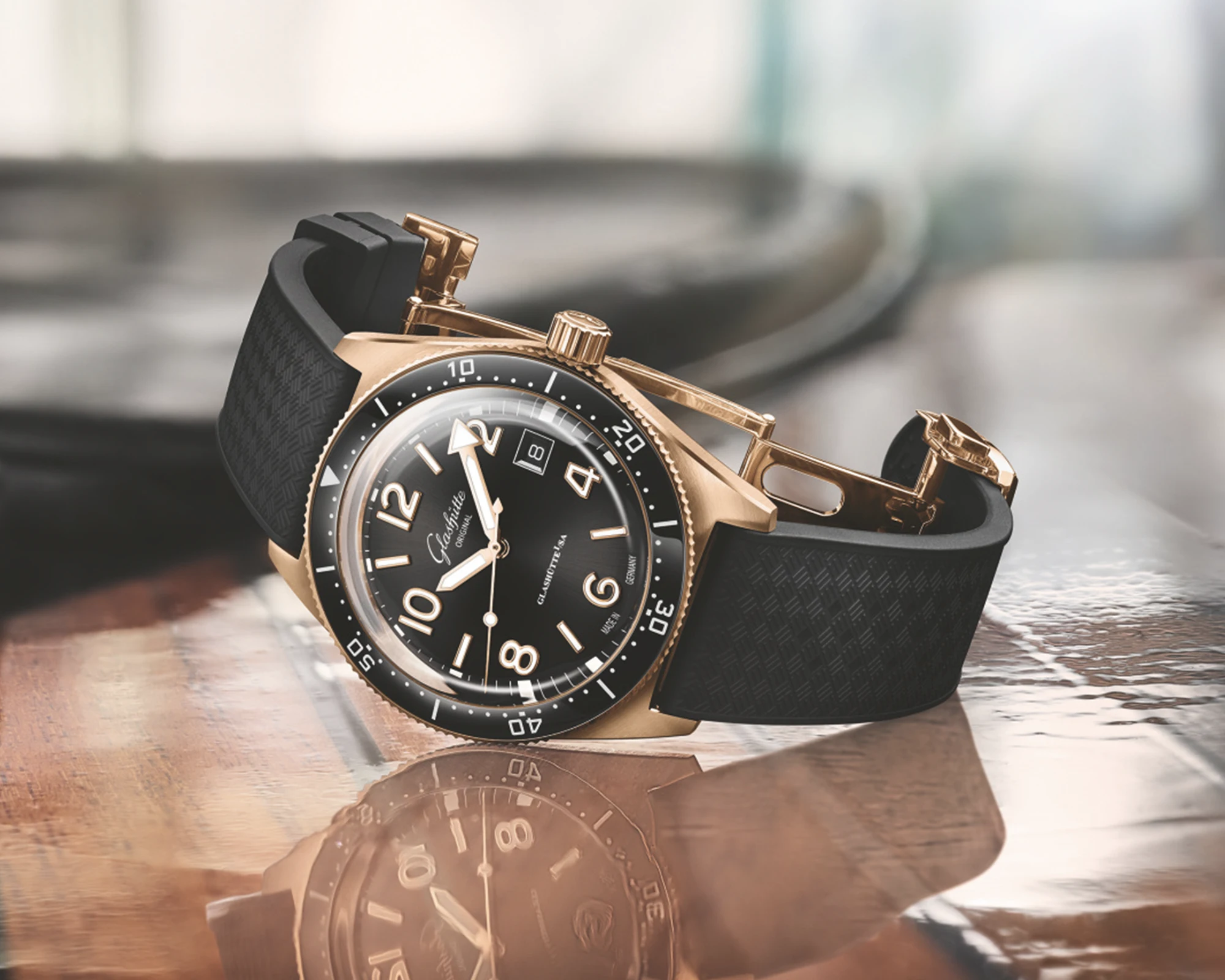
Another novelty is the open sapphire crystal caseback, which provides a view of the decorated automatic calibre 39-11. Like the skeletonised rotor with the brand’s double-G emblem, the three-quarter plate is also adorned with the Glashütte stripe finish. The latter are both specialities of the Glashütte manufactory and could be considered hallmarks of watches ‘made in Germany’. Three-quarter plates have been used in the Glashütte watch workshops since 1864, as virtually all bearing positions are integrated into a single wheel bridge, thus ensuring greater stability.
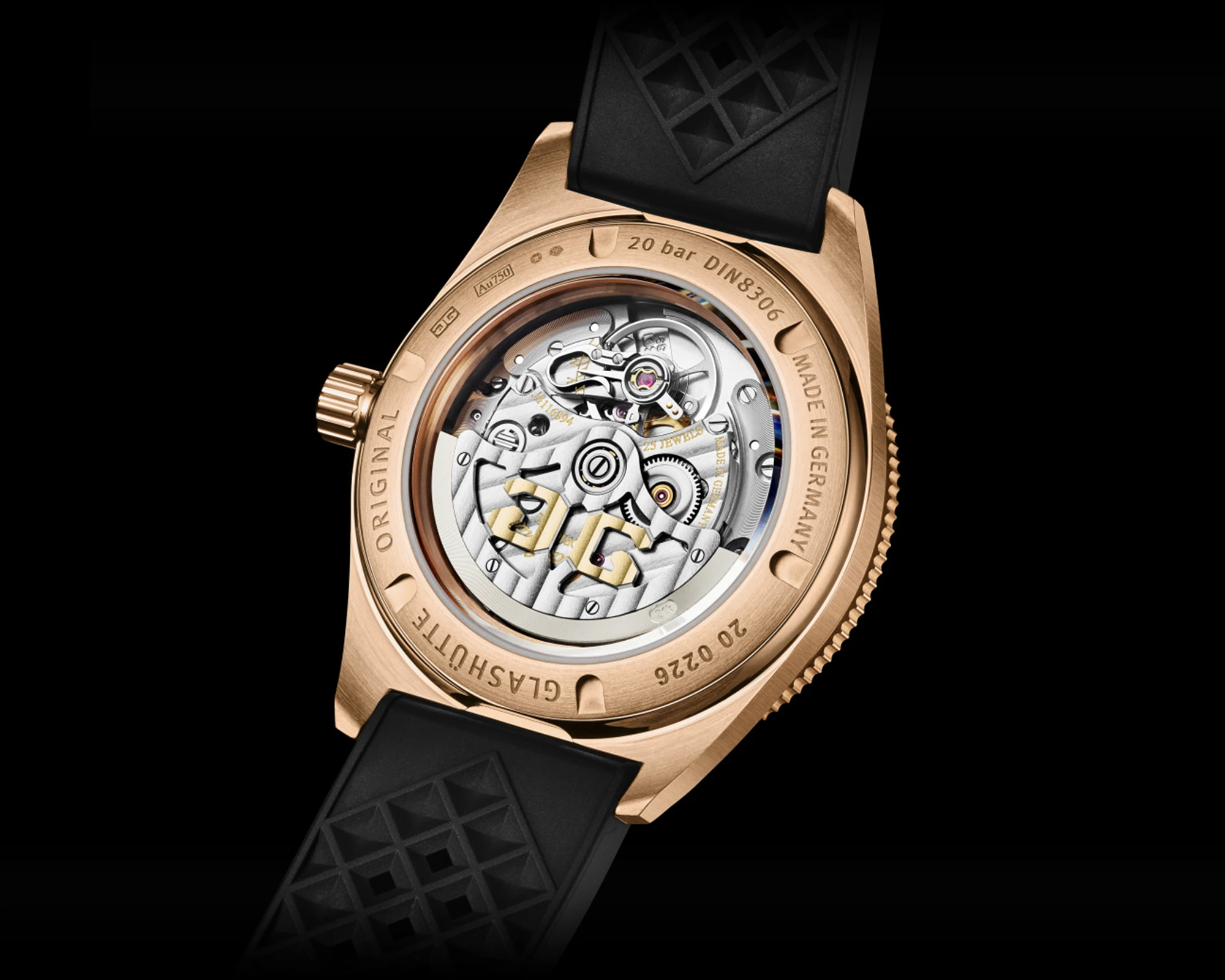
The stripe finish which consists of parallel stripes is also characteristic of Glashütte craftsmanship. This is a cut consisting of parallel stripes. At Glashütte Original, they can typically be seen on the gear train bridge, the winding rotor and the balance cock.
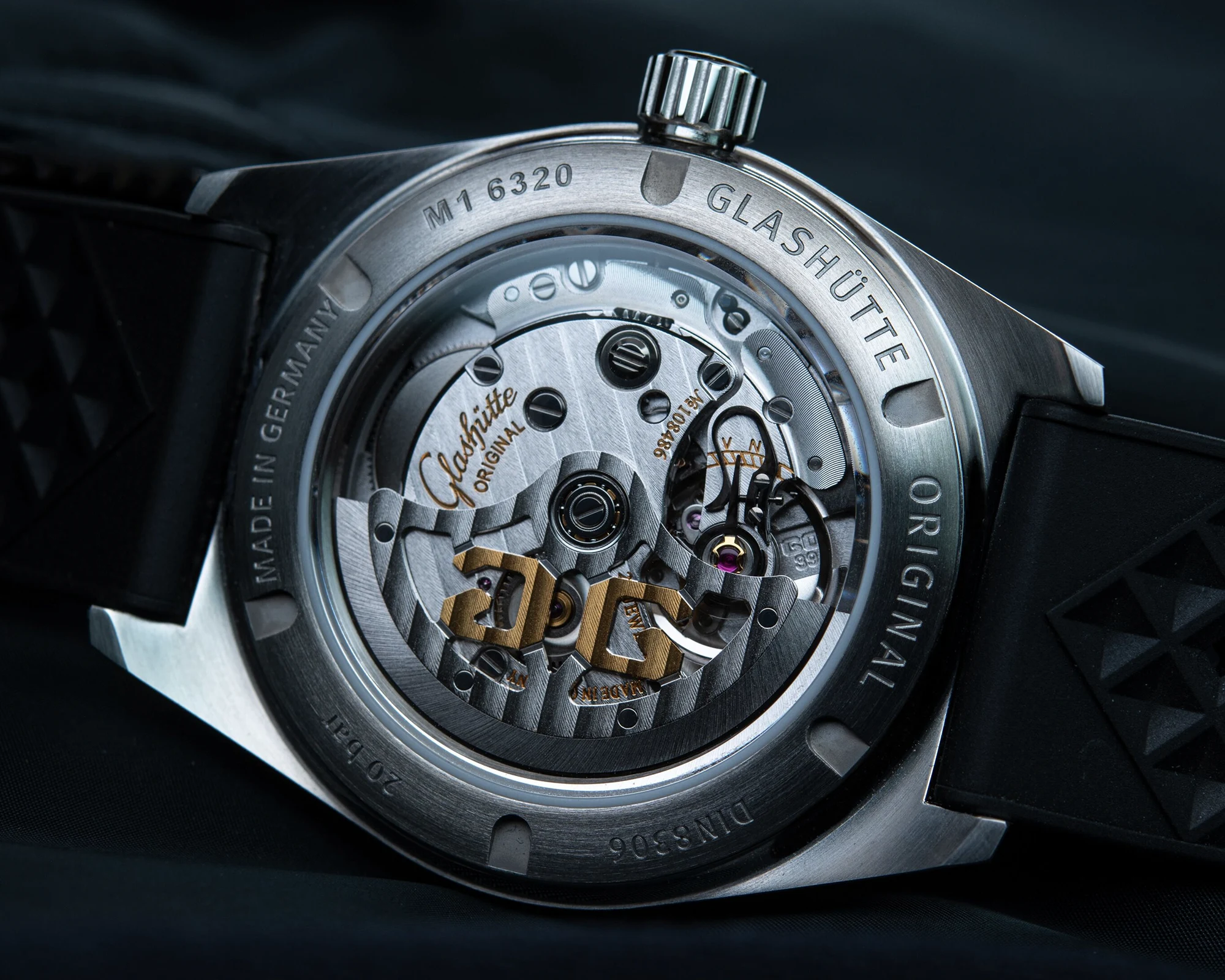
Until recently, the red-gold version was the only regular SeaQ variant with a sapphire crystal caseback. But from December 2024, there will be a sapphire crystal caseback option for both the stainless steel SeaQ models and the SeaQ bicolour version with a 39.5 mm case. It will be available at all official Glashütte Original retailers. From January 2025, owners of a SeaQ can have their timepiece’s steel caseback replaced with a sapphire crystal caseback through the Glashütte Original Customer Service for a fee.
It’s all about the date: SeaQ Panorama Date
When the Spezialist collection was launched in 2019, Glashütte Original also introduced a model with a 43.2 mm case alongside the SeaQ: the SeaQ Panorama Date. Thanks to their significantly larger diameter, these models feature the brand’s characteristic large date, the so-called Panorama Date, at 4 o’clock.
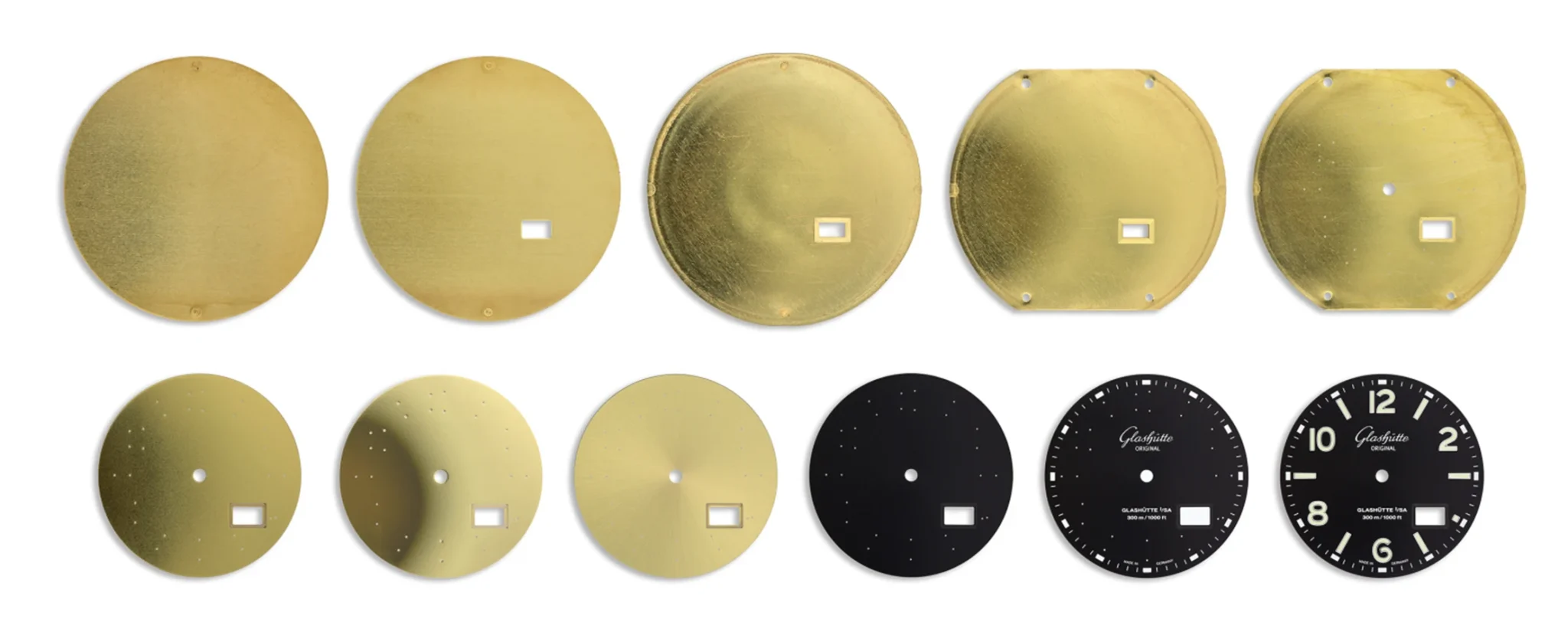
It consists of two tiny, in-house manufactured display discs whose colours either harmonise or contrast with the colour of the dial. This kind of date display does not require a centre bar, as the display discs are concentrically arranged on one level and, as the name suggests, their size makes the date even more visible. Apart from this, the SeaQ Panorama Date has the same features as the SeaQ, with three hands for the hours, minutes and seconds and a stop-second function.
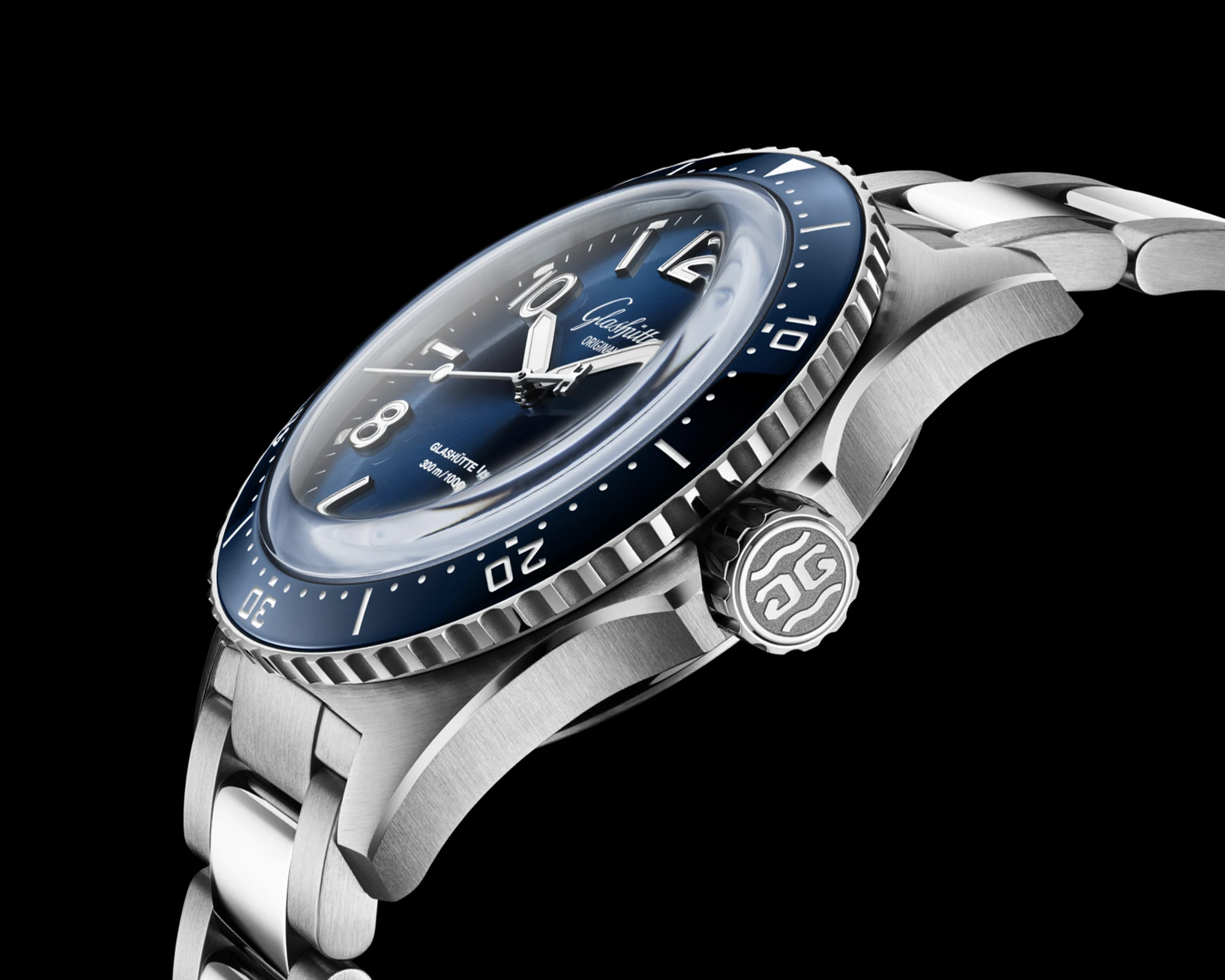
The first SeaQ Panorama Date with a blue dial Ref. 13613028134.
Another difference between this model and the regular SeaQ models is the higher water resistance of 300 metres instead of the SeaQ’s 200 metres. Thanks to the ornate calibre 36-13 with bayonet mounting, the power reserve of 100 hours is also considerably longer than that of the SeaQ models. This mounting also ensures the shock-resistant integration of the movement, which oscillates at 4 Hz, within the case. The silicon balance spring guarantees accuracy under any condition. The movement, decorated in the Glashütte style, can be admired through an open caseback.
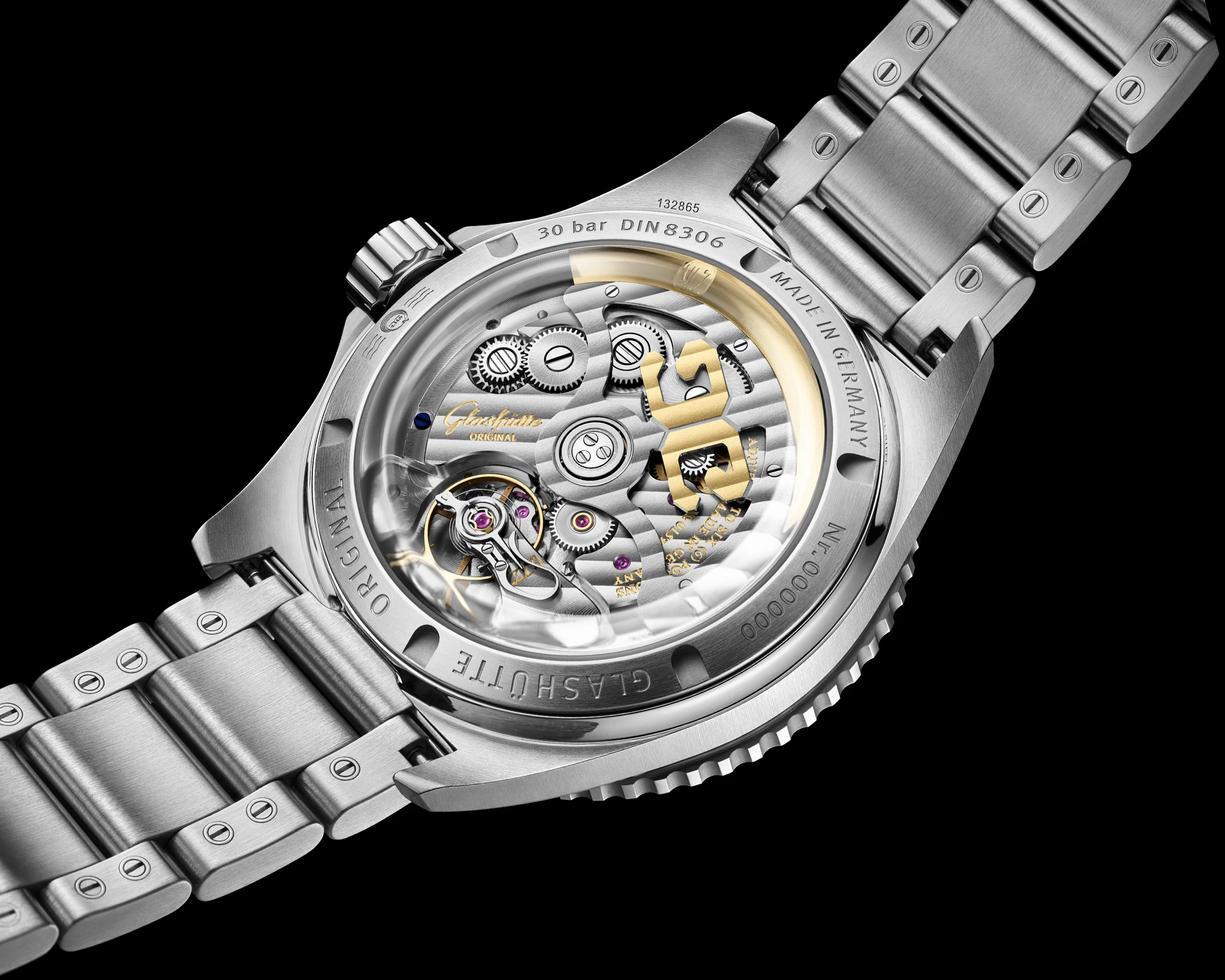
The decorated calibre 36-13 of the SeaQ Panorama Date Ref. 13613018070.
Diving requirements such as a unidirectional rotating bezel and luminous markings for orientation are also met here in accordance with DIN and ISO standards. But that’s not all: Glashütte Original takes it one step further for every calibre 36 movement and has developed its own 24-day in-house test procedure. Once it has been passed, an individual certificate is issued for each watch.
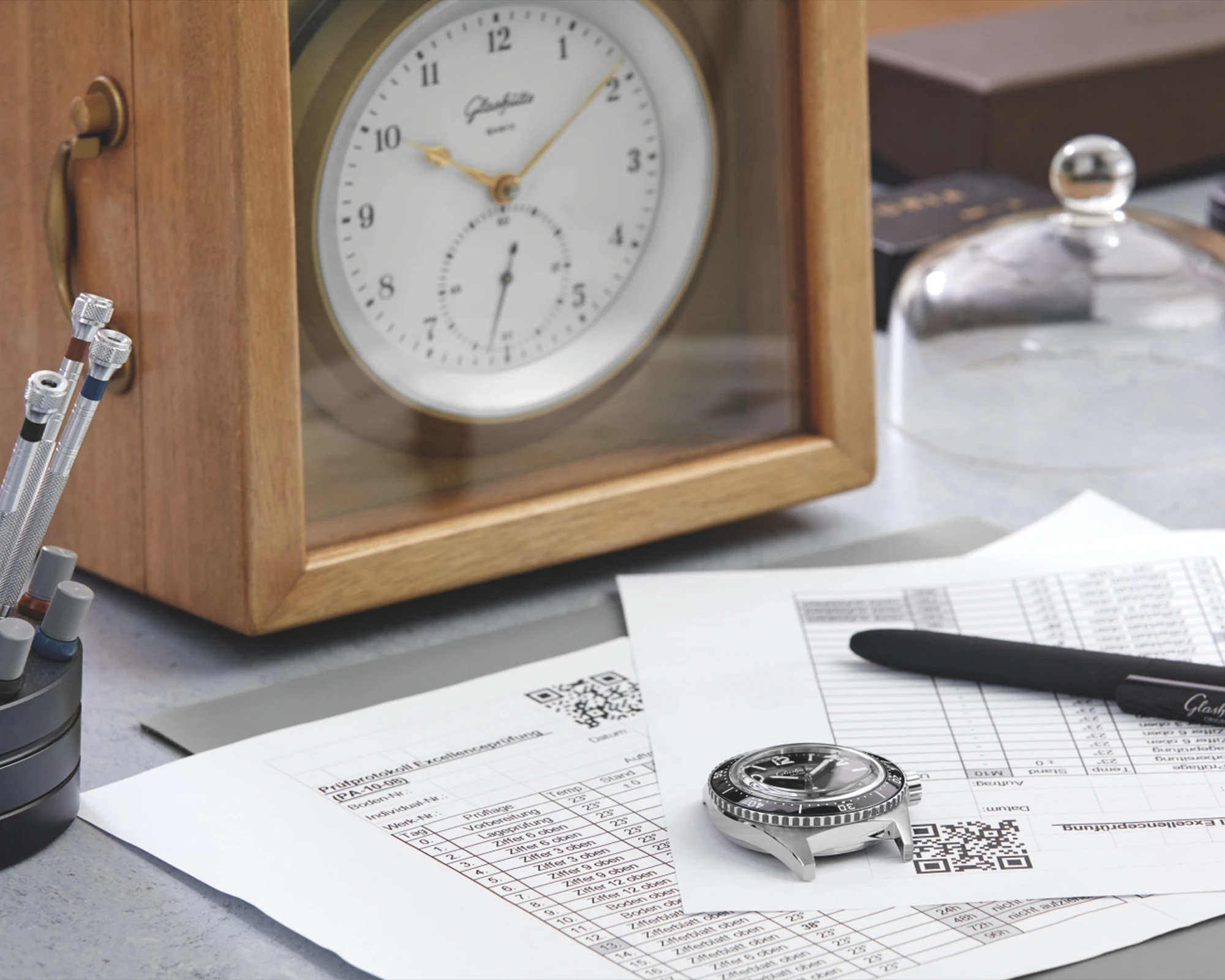
2019: SeaQ Panorama Date
The first version of the SeaQ Panorama Date was available with a galvanised black or blue dial, which was set in a 15.65 mm high, polished and satin-finished stainless steel case. On the black sunray-finished dial, the applied numerals and indices as well as the hands are green. On the blue dial, however, they are white. As with the SeaQ from the same year, the models come with either a stainless steel bracelet, a grey nylon woven strap, or a black rubber strap with a relief pattern.
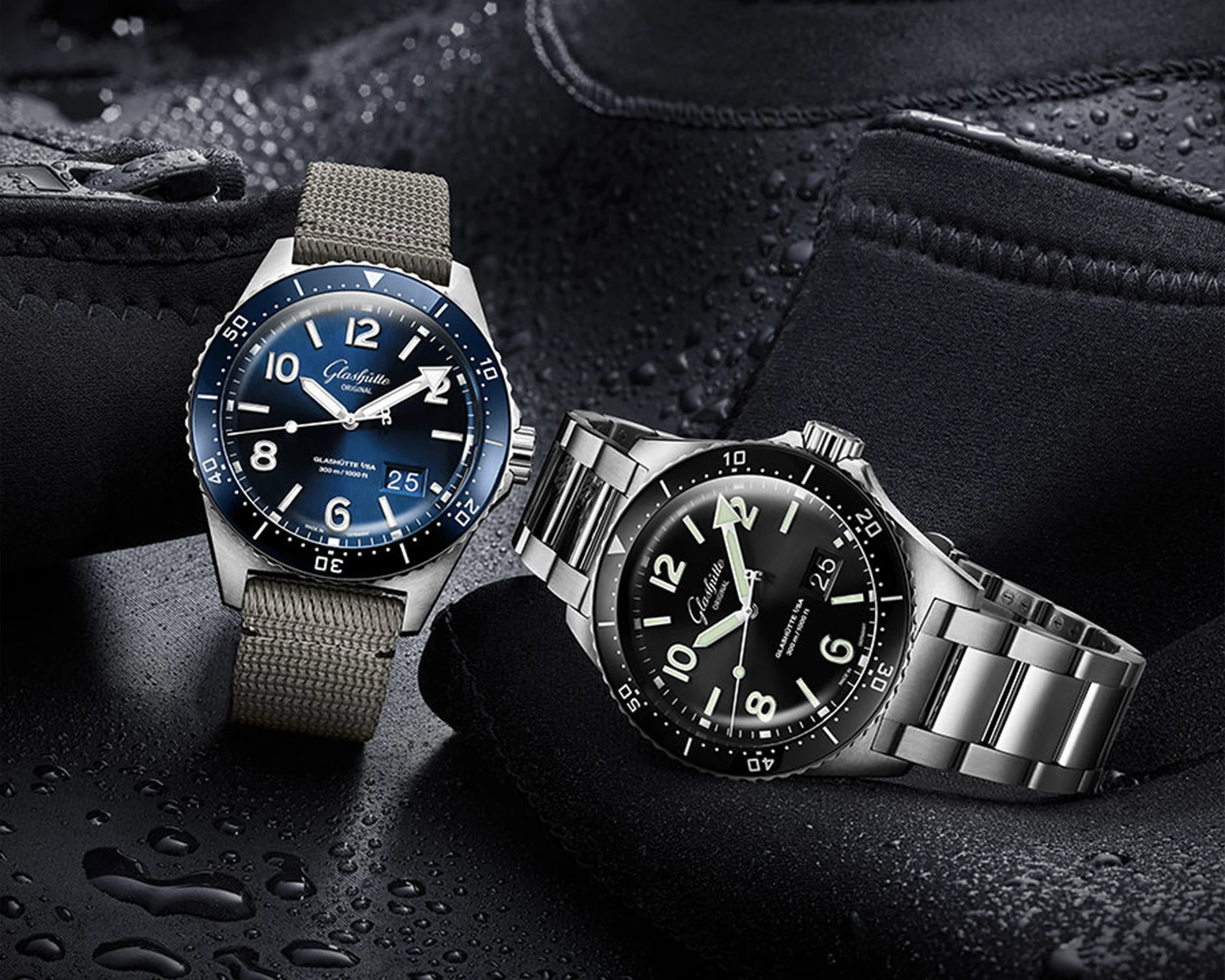
2020: Two new SeaQ Panorama Date
Two new versions of the SeaQ Panorama Date were released at the start of the new decade in 2020. The 5N red-gold model has a red-gold rotating bezel whose ceramic ring inlet’s graduations are white lacquered. The rotating bezel and crown of the bicolour version are also made of 4N red gold and create a subtle contrast to the stainless steel case.
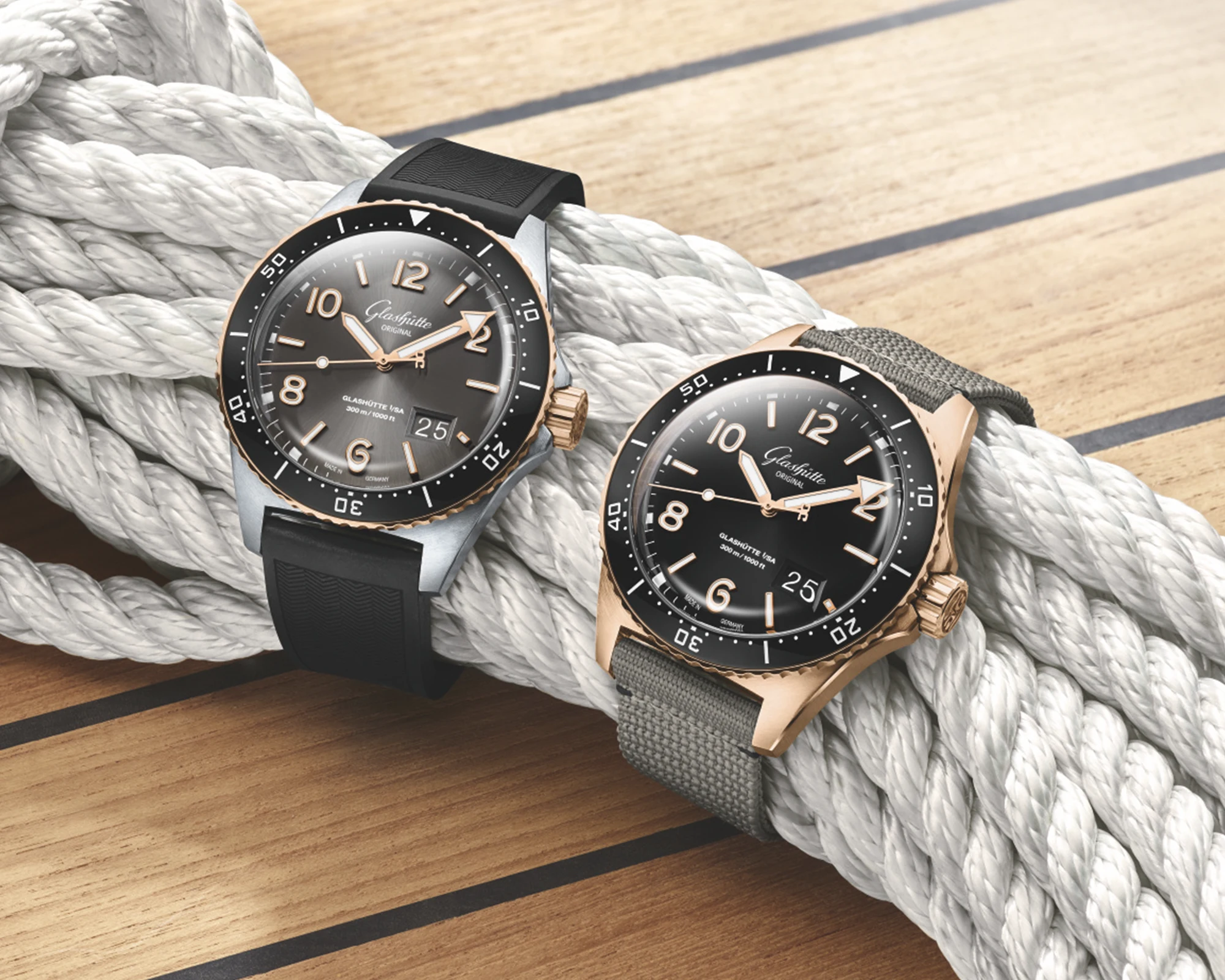
The SeaQ Panorama Date Ref. 136130491 in bicolour with a rubber strap (left) and the red-gold version Ref. 13613039034 with a grey synthetic strap (right).
While the Panorama Date on the red gold version is set in black to match the dial colour, the display discs on the bicolour version are grey. A black rubber strap or a grey synthetic strap with a folding clasp are also available for both models. On both models’ sunray-finished dial, the Arabic numerals, applied hour-markers and arrow-shaped hands are gold-plated and coated in white Super-LumiNova.
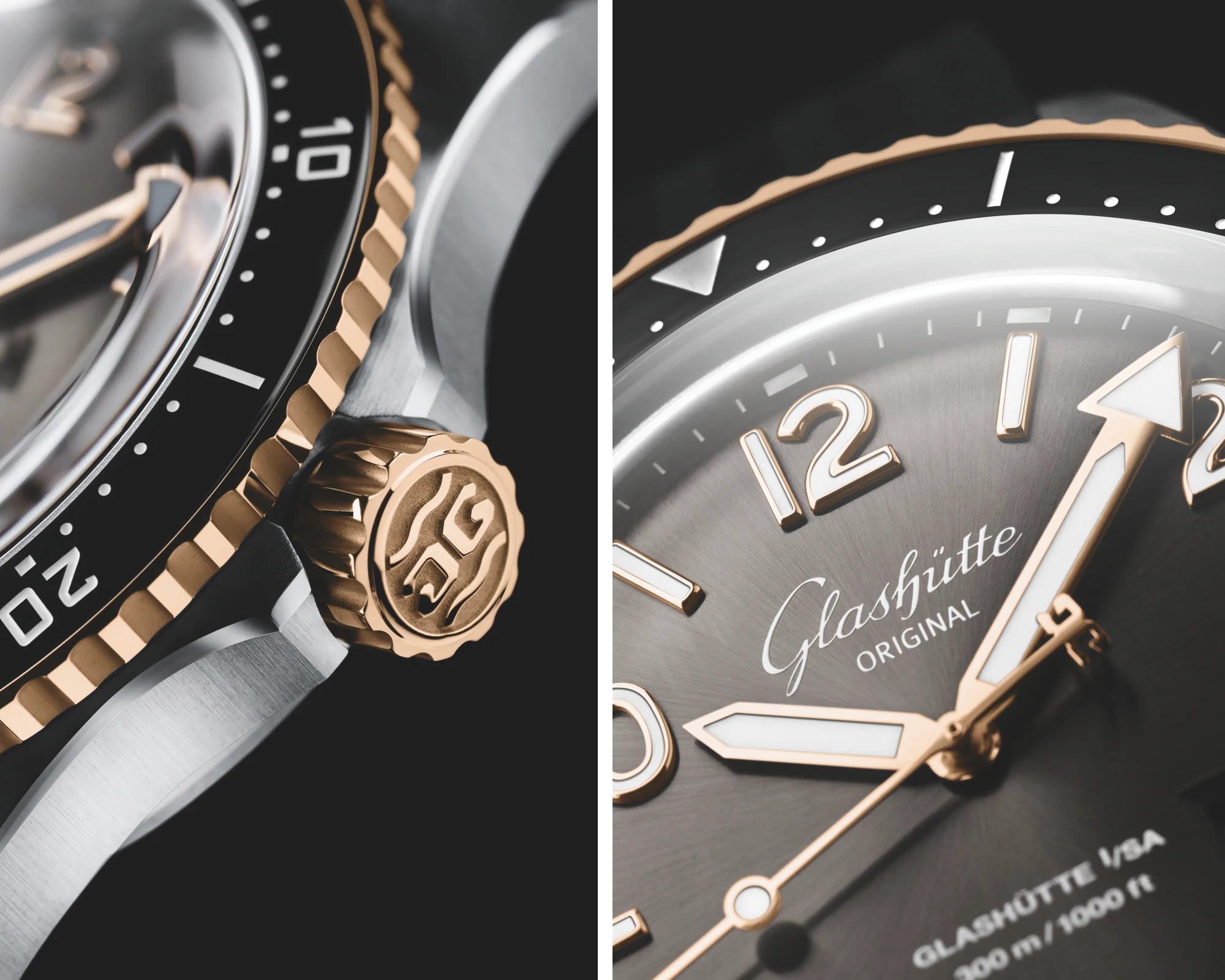
As is usual for the SeaQ Panorama Date, the sapphire crystal caseback reveals the automatic 36-13 movement with its refined Glashütte watchmaking details. The skeletonised rotor bears the golden double-G symbol, whose colour is echoed by the 21-carat gold oscillating weight. While the edges are bevelled and the steel components are polished, the blued and polished screws set specific colour accents on the striped movement.
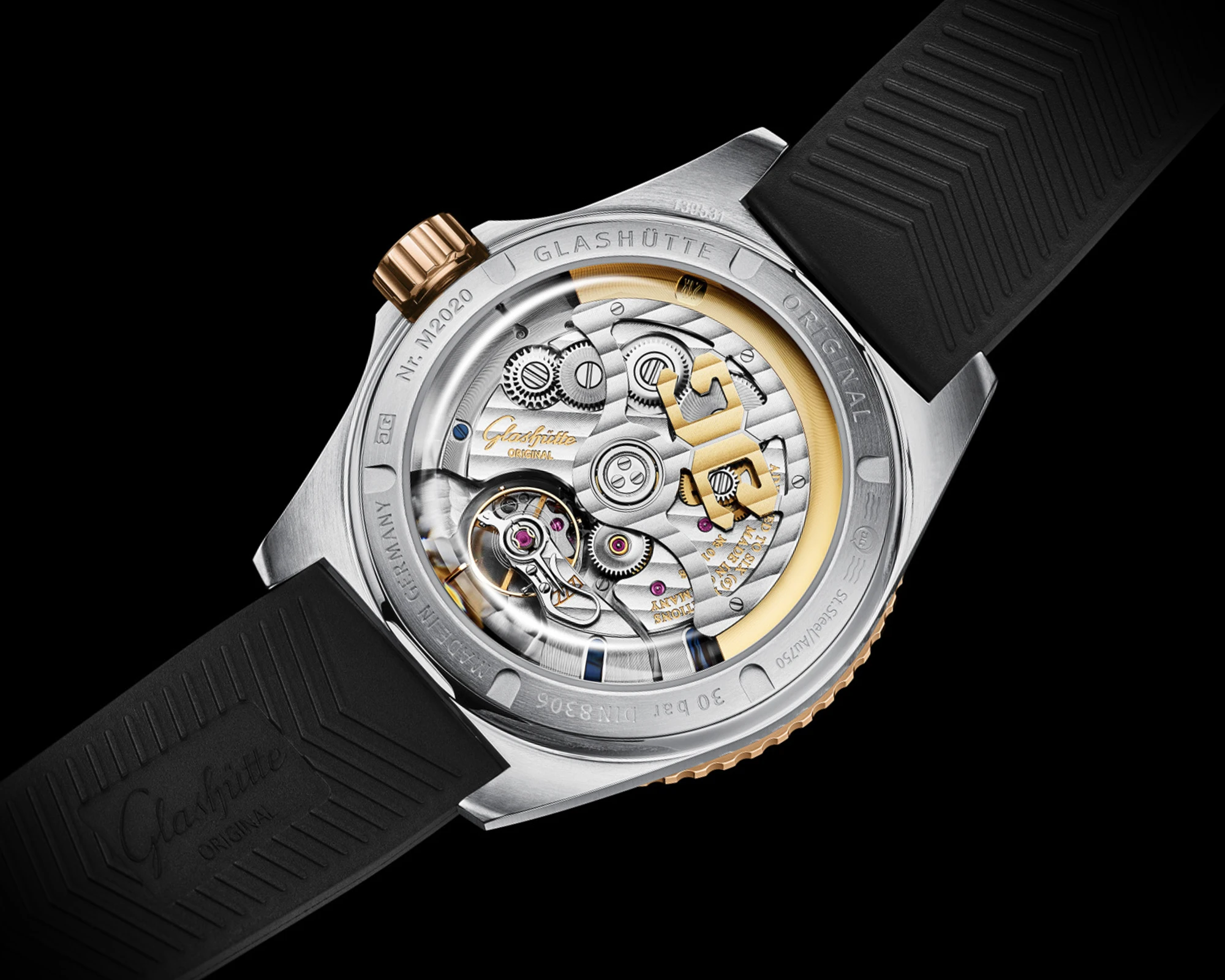
In the same reed-green colour as the SeaQ from 2021, a reed-green SeaQ Panorama Date with a stainless-steel case has been available as of this year.
For increased functionality: SeaQ Chronograph
After several years of development, the SeaQ Chronograph entered the market in October 2022. As Glashütte Original’s first diver’s watch with a chronograph mechanism, it offers an increased technical functionality within the collection. In addition to a Panorama Date at 6 o’clock, the SeaQ Chronograph models are also equipped with a flyback chronograph with column-wheel switching and short-time measurement.
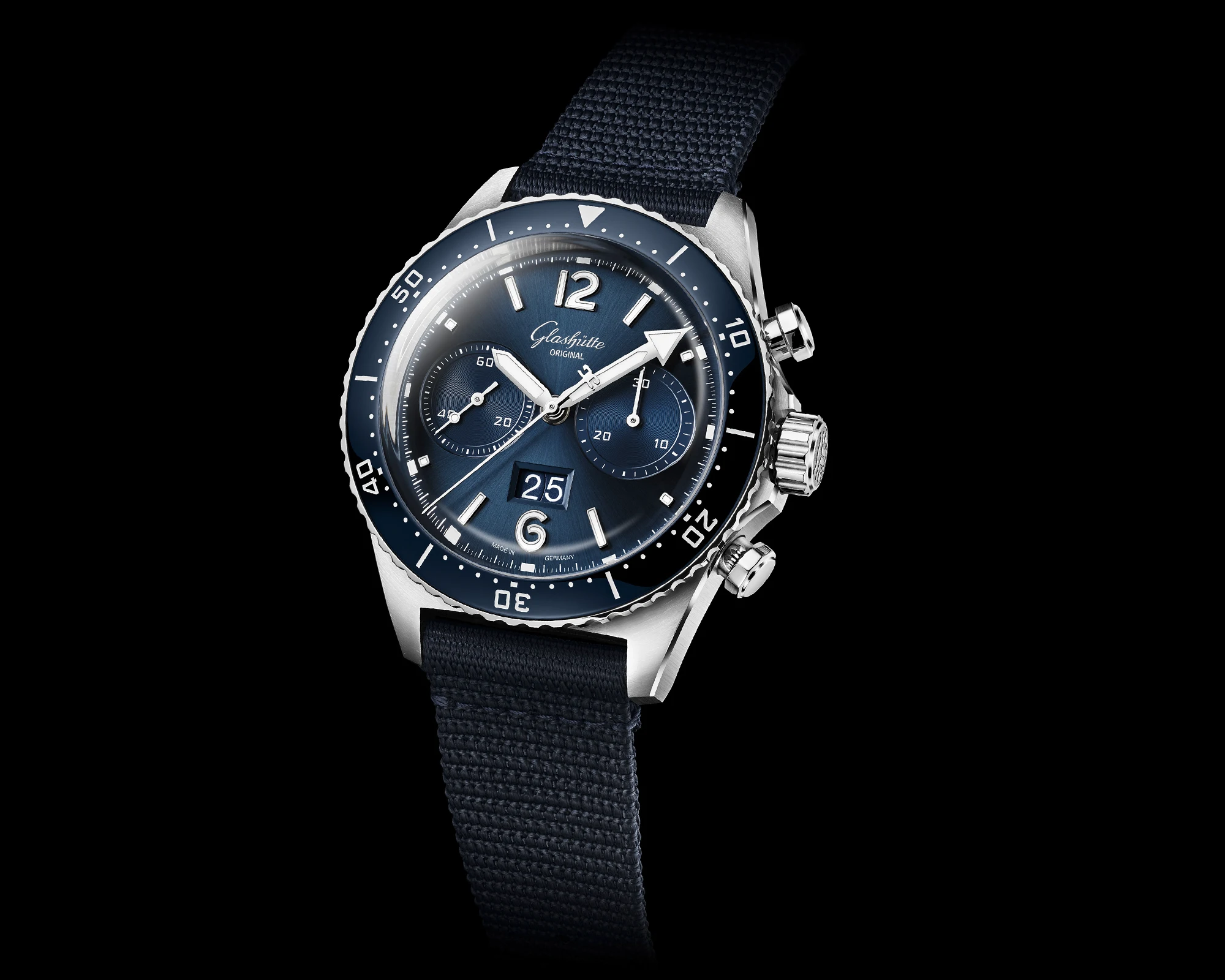
The first SeaQ Chronograph Ref. 13723028136.
Two push-buttons above and below the crown on the right case side can be used to seamlessly reset the hand of the central stop second and the small second with stop second as well as the 30-minute counter. All of the timepiece’s displays can be set via the screw-down crown with its wave decoration, which means that a separate date corrector is not required. Instead, the wearer can correct the date via the second crown position and adjust the time with stop seconds via the third position.
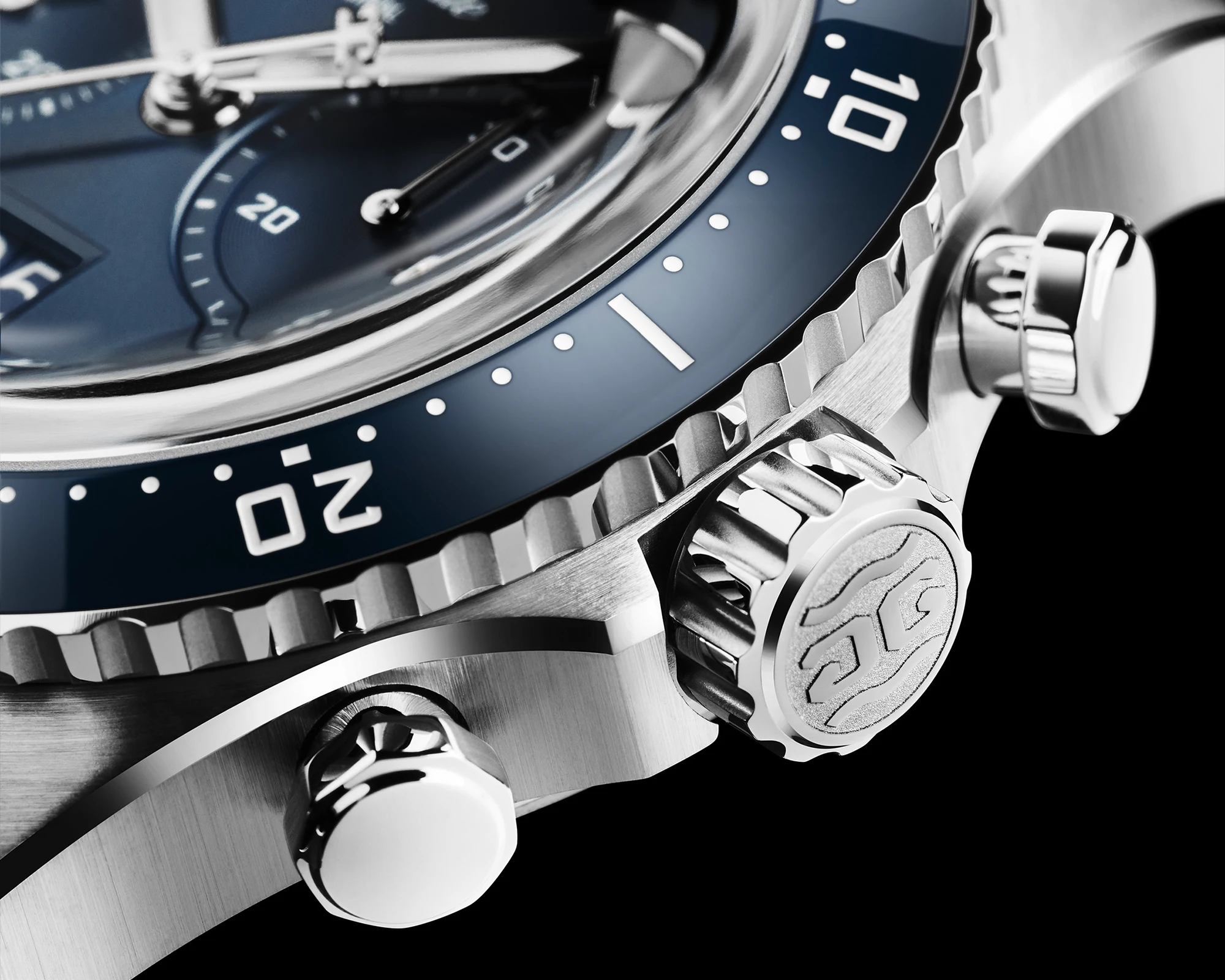
All SeaQ Chronograph models are powered by the hand-finished automatic calibre 37-23 with a power reserve of 70 hours, which is visible through the sapphire crystal caseback. The movement oscillates at a frequency of 4 Hz and, thanks to a silicon balance spring, is insensitive to magnetic impact and has a higher rate accuracy. Another special feature is that the movement has been modified to provide more space for the balance wheel and allow it to run at a higher amplitude. Like the other calibres in the Spezialist collection, this movement is equipped with a three-quarter plate with Glashütte stripes, edges that have been bevelled at a 45-degree angle and polished using a steel pin to compress the material, polished and blued screws and 14-carat gold regulating screws on the balance rim.
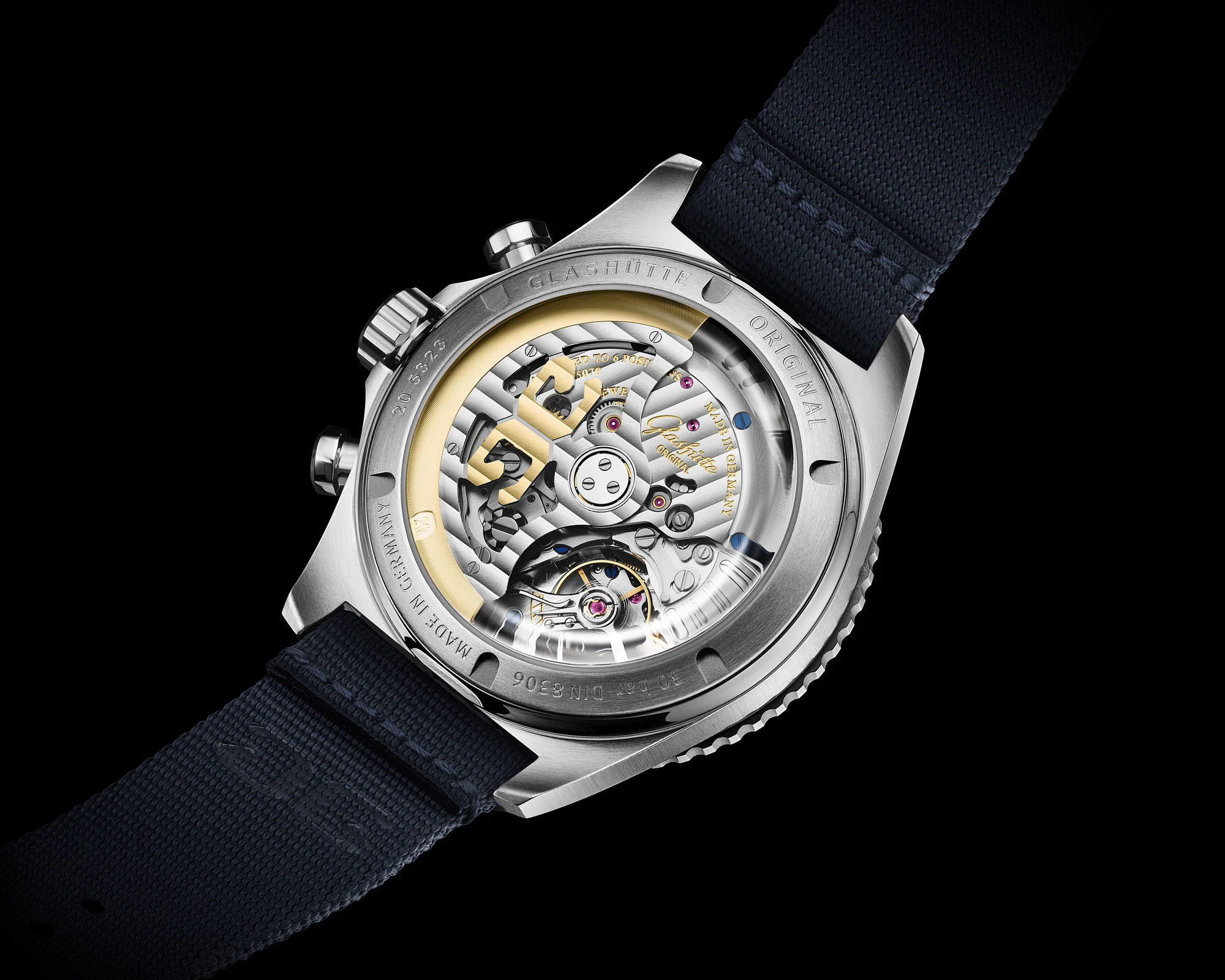
A look at the automatic calibre 37-23.
The first SeaQ Chronograph
The movement of the first SeaQ Chronograph from 2022 is encased in a 43.2 mm stainless steel case and is visible through the open caseback. As with the SeaQ Panorama Date, the case is water-resistant to a depth of 300 metres.
The dark blue dial is PVD-coated and harmonises with the bezel’s dark blue ceramic inlay and the matching rubber strap. Rhodium-plated, applied numerals and indices round off the overall look. For more variety, the chronograph can also be combined with a stainless steel link strap or two synthetic straps in grey or blue. Recycled fishing nets serve as the basis for the latter.
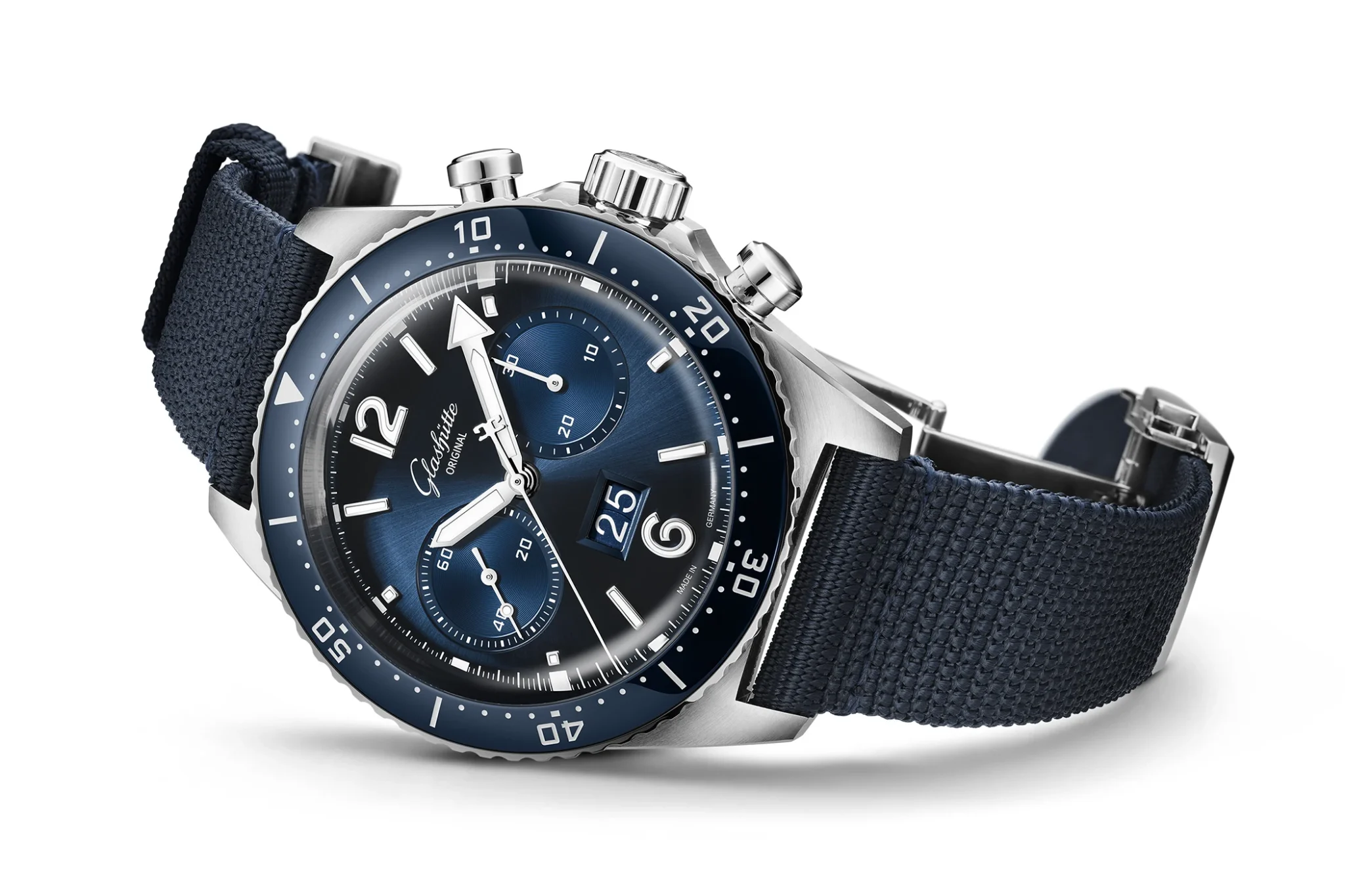
On the Silver Screen: SeaQ Chronograph 2024
The latest addition to the Spezialist collection was released just last week and presents itself in a very special hue that picks up on the monochromatic aesthetics of film noir. The stainless steel case with a rotating bezel with black ceramic inlay meets a silver galvanised dial in the colour ‘Silver Screen’. The galvanisation allows the dial to imitate the cinema screens of the past that were coated with a thin layer of silver lacquer to minimise light scattering and create greater contrast.
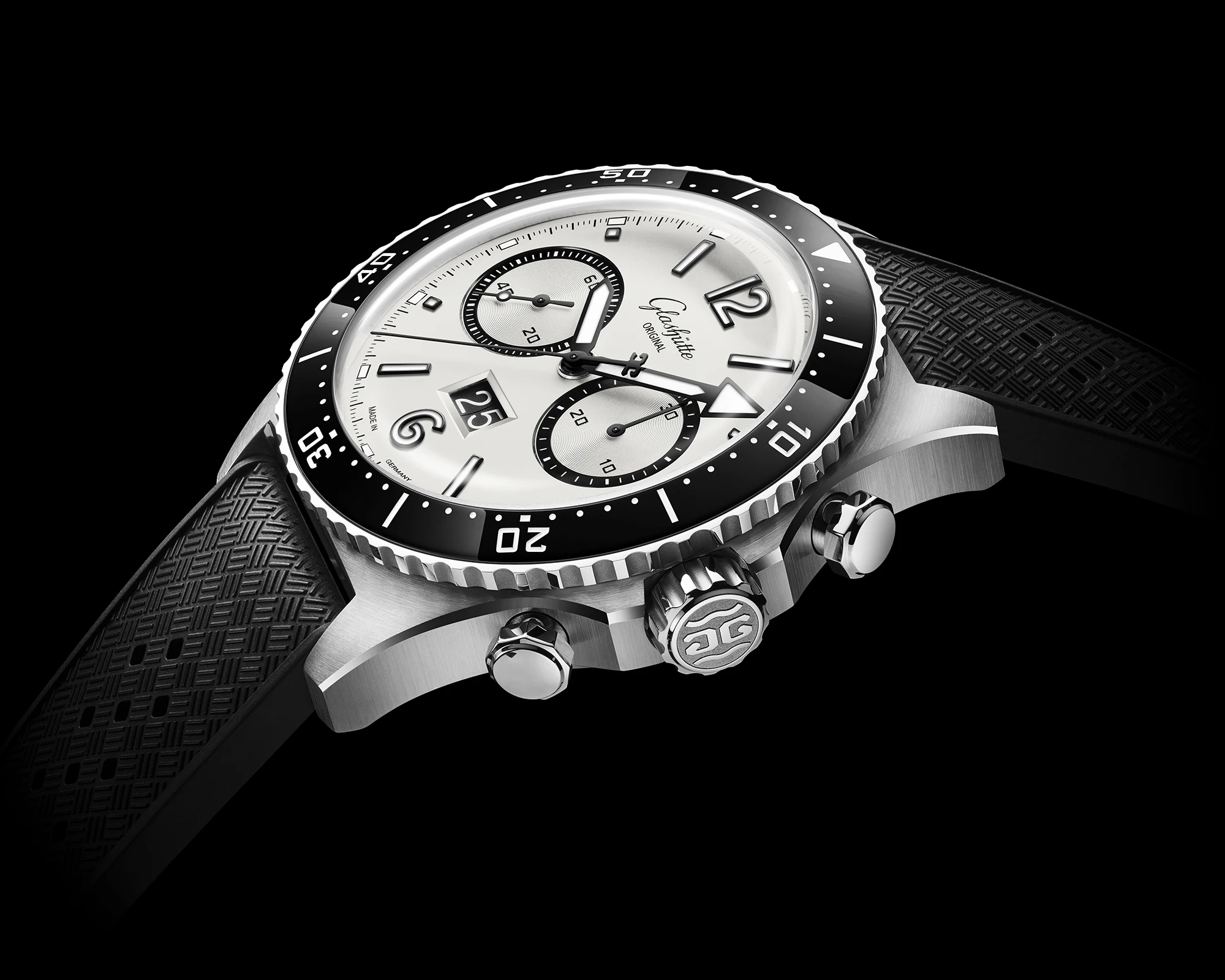
The dial indicates the time via contrasting black hands and Arabic numerals as well as applied indices with Super-LumiNova coating. The black minute track and lettering also stand out from the dial, thus aiding legibility.
Another homage to the retro aesthetic and a trademark of Glashütte Original is the ‘vinyl’ pattern of the 30-minute counter and the small seconds. This is a circular-cut pattern that is created using a lathe. With a turning tool a thin metal thread is removed from the rotating dial blank, resulting in the groove-like pattern. The subdial counters are framed by a black galvanised, narrow border with white markings. All these small details are created in the Glashütte manufacture. The Panorama Date at 6 o’clock is also monochromatic with white numerals on a black background.
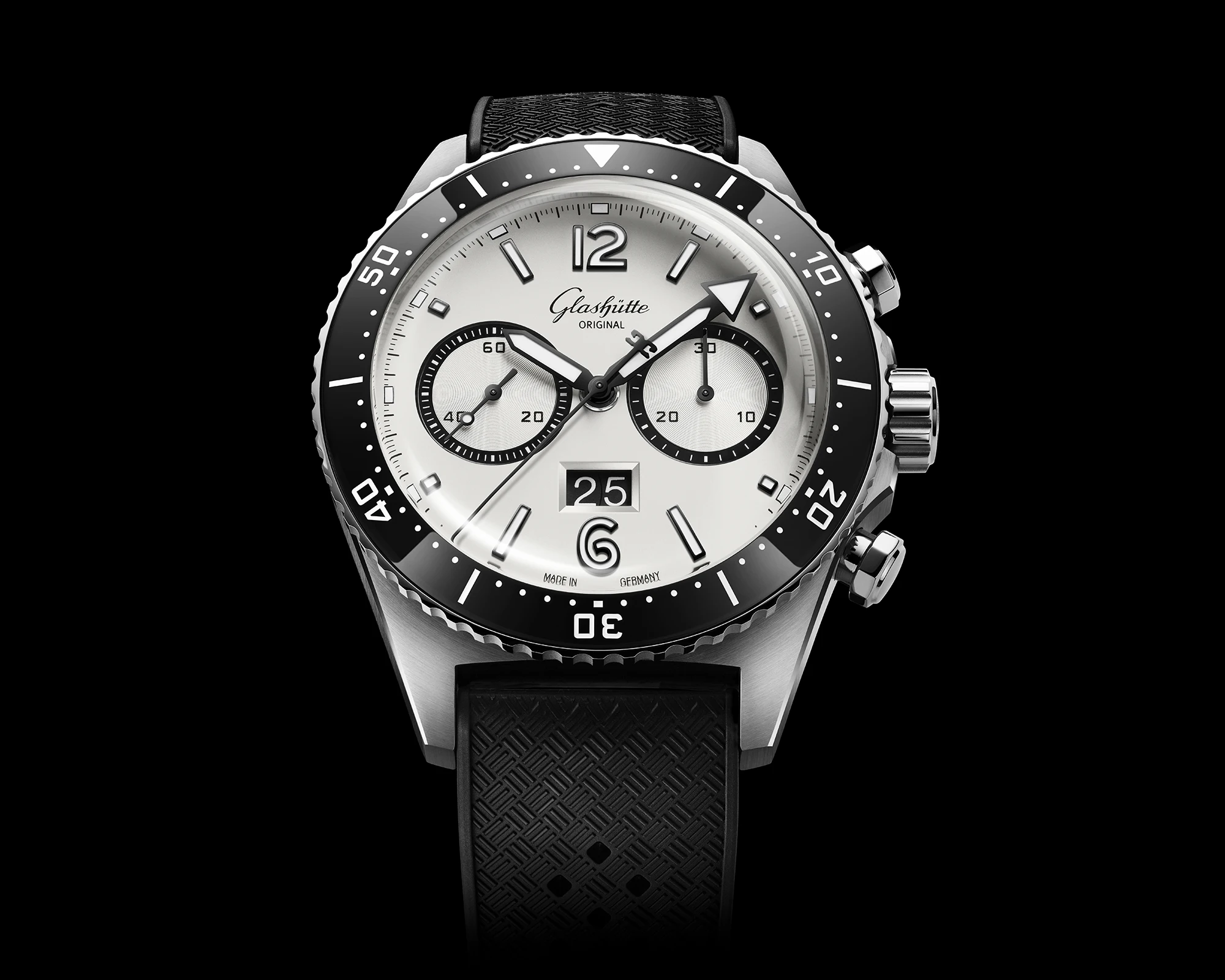
If you wish to emphasise the timepiece’s elegant features, you can wear the SeaQ Chronohraph with a simple, black rubber strap with a pin buckle or folding clasp or on a stainless steel bracelet with a fine adjustment mechanism. For a sporty look, the monochrome timepiece can also be worn on an eye-catching synthetic strap with a pin buckle or folding clasp in the new orange shade and in one of the muted synthetic strap colors.
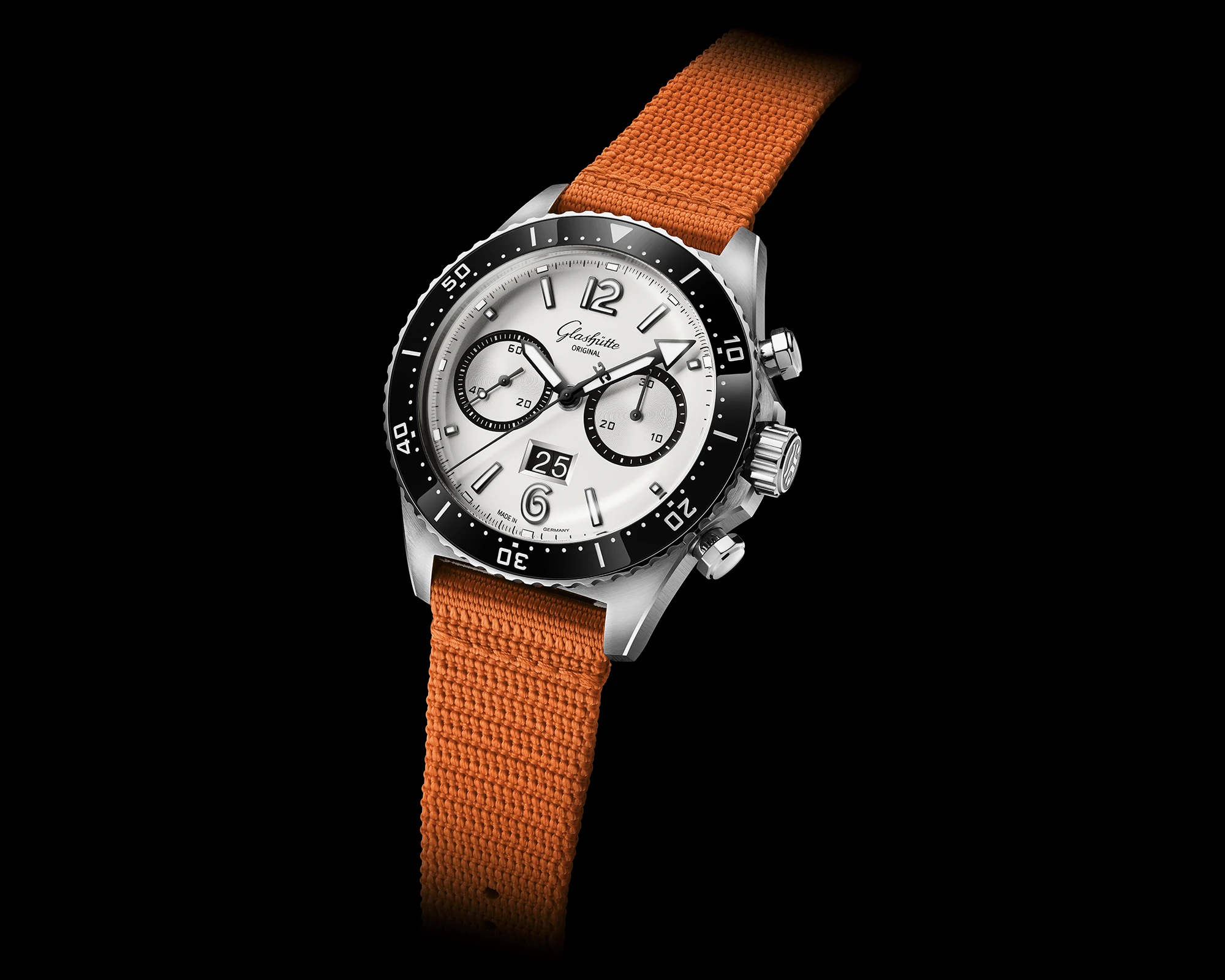
Put through their paces
All SeaQ models have one thing in common: before they go on sale, they are put through their paces as the wearer’s safety is always the top priority for diver’s watches. The formula is simple: if the diver’s watch is protected against all adversities and thus its precise function is guaranteed, it therefore also contributes to the diver’s safety.
To be considered reliable companions, the timepieces must comply with the DIN standard 8306 of the German Institute for Standardization (DIN) or the ISO standard 6425 of the International Standards Organization (ISO). Their water resistance is the most important factor here, but their resistance to salt water, performance in the event of temperature fluctuations, readability and shock resistance also play an important role. But how exactly does Glashütte Original verify that its SeaQ models meet these German and international quality standards?
Baptism of fire in the water: Water-resistance of the SeaQ models
Before the SeaQ models are tested for their water resistance, they are exposed to moisture. Therefore, the SeaQ is heated to 40-45 degrees for half an hour and then a piece of cold, wet felt is placed on the watch.
If there is any moisture in the watch afterwards, it becomes visible as condensed water on the inside of the sapphire crystal. After successfully completing all tests and before the timepiece is considered DIN or ISO-compliant, this test is carried out once again.
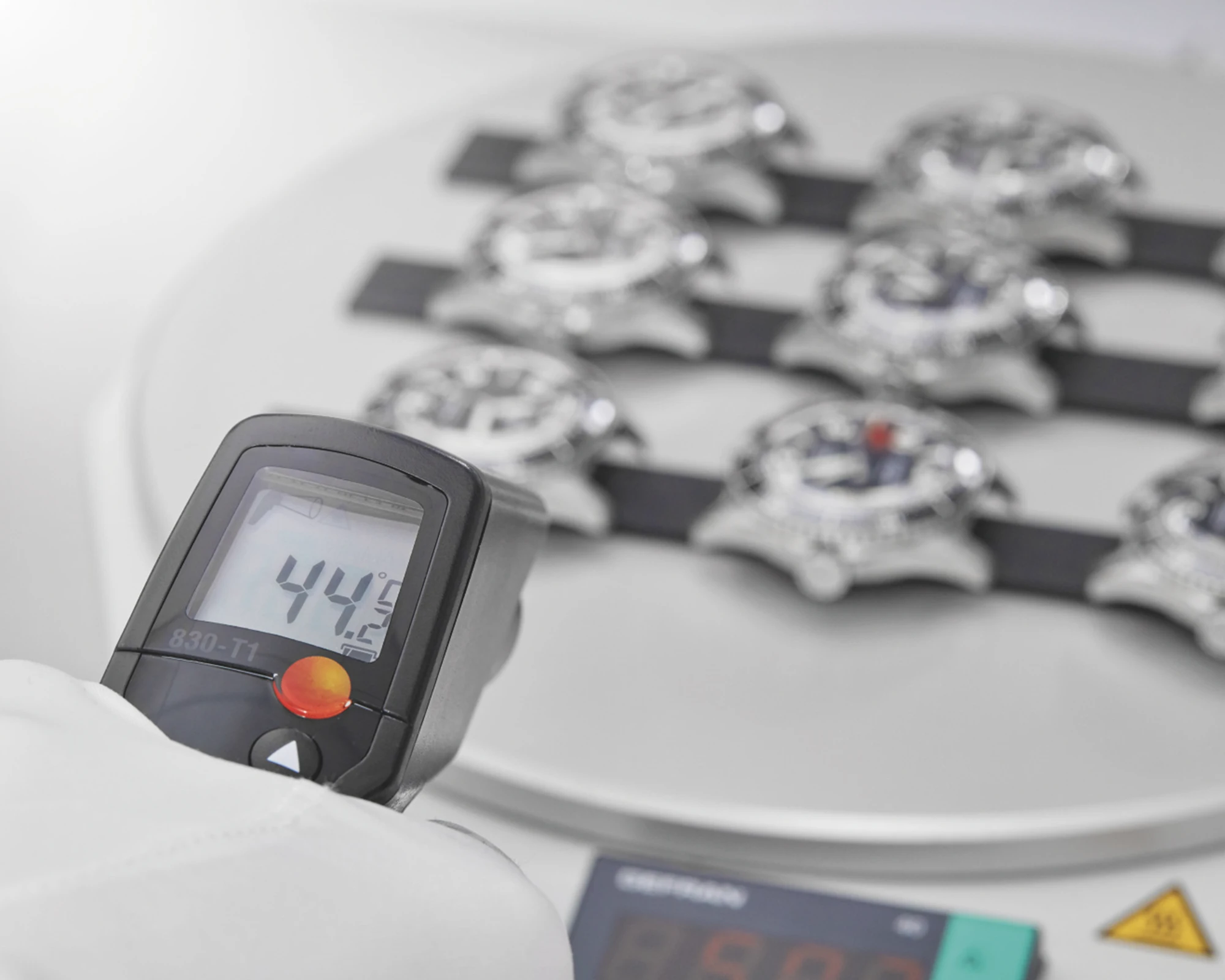
However, before we get there, the SeaQ has to pass a few more baptisms of fire. First, the watch is subjected to a pre-test at an air pressure of 5 bar. After that, a pressure test is carried out at maximum water pressure plus 25 percent, but not a single 5 millionth of a gram of water may enter the watch. This corresponds to approximately 25 bar for watches with a water resistance of up to 200 metres and 37.5 bar for watches with a water resistance of up to 300 metres. However, even the smallest amount of water ingress can be devastating for a timepiece.
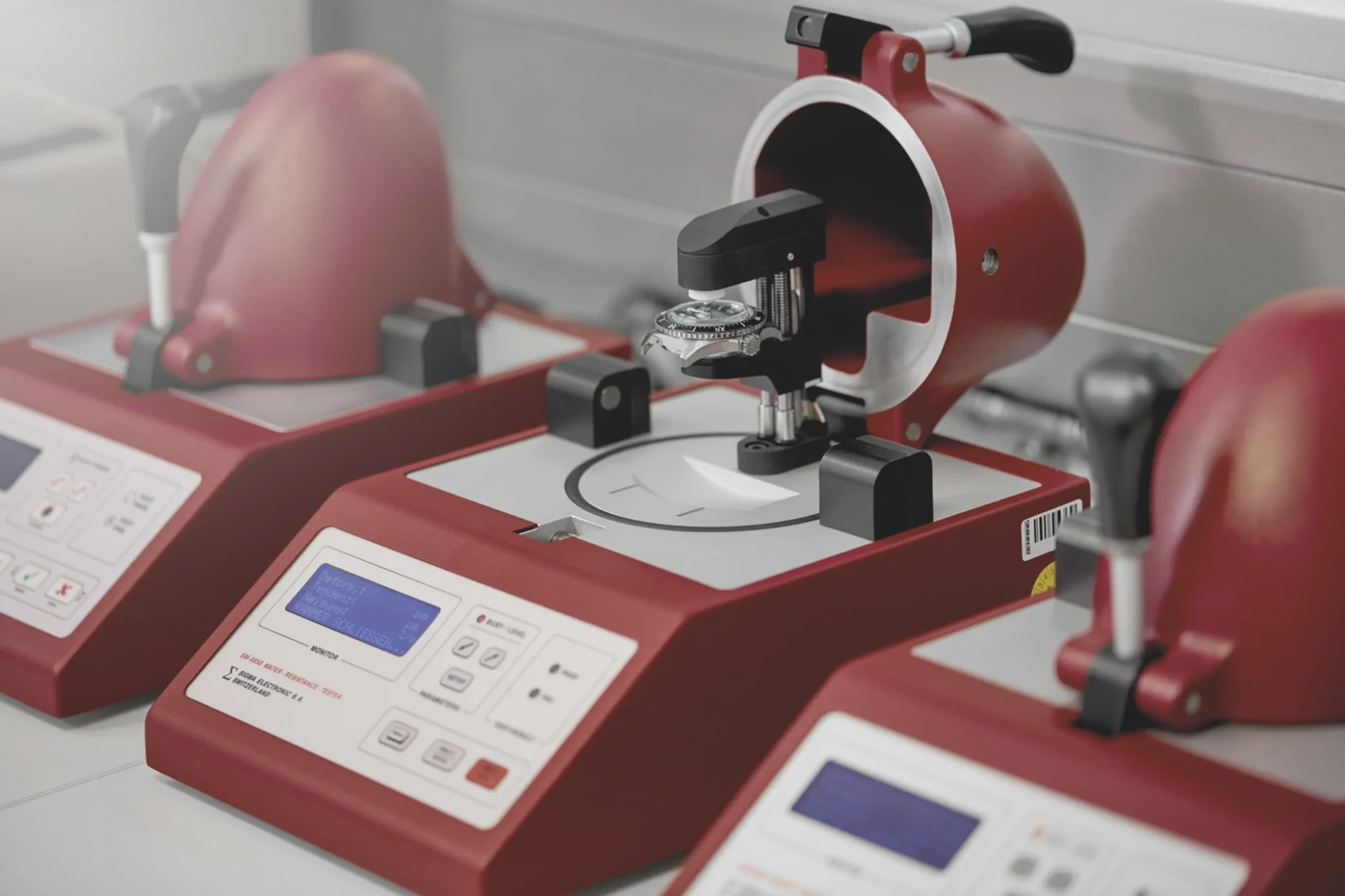
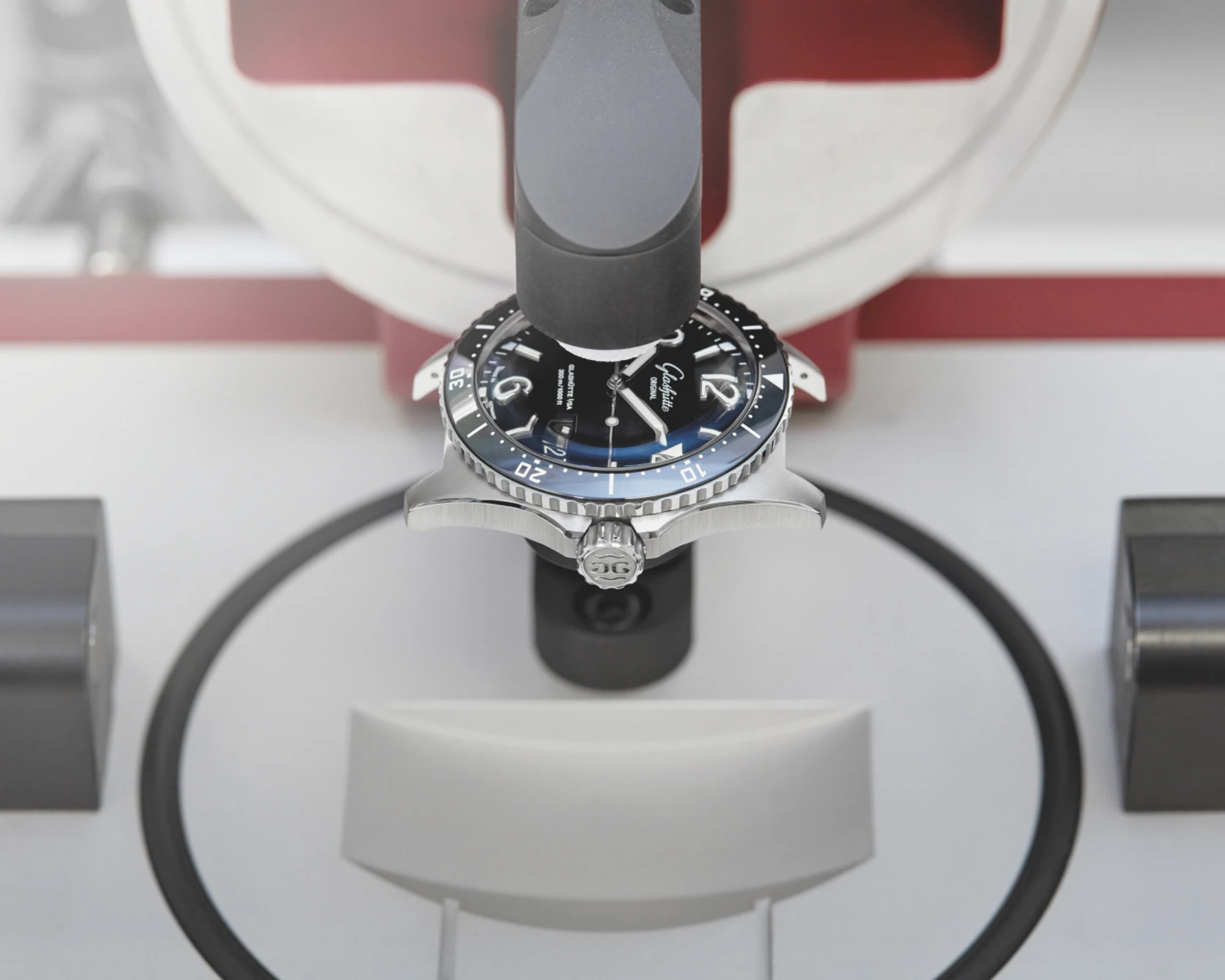
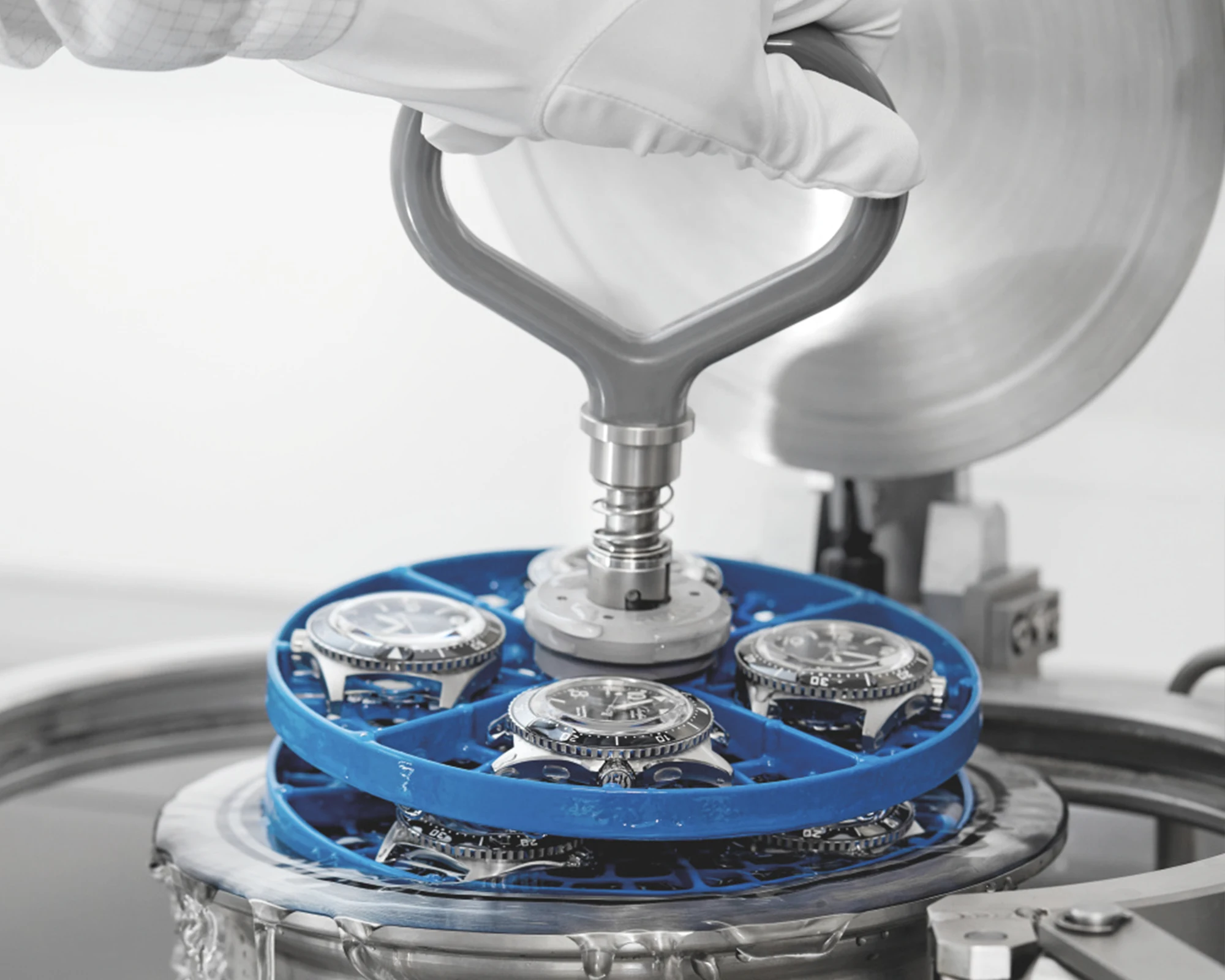
After the SeaQ has survived a plunge into the water, it is rotated under an air curtain to dry before undergoing a final condensation test.
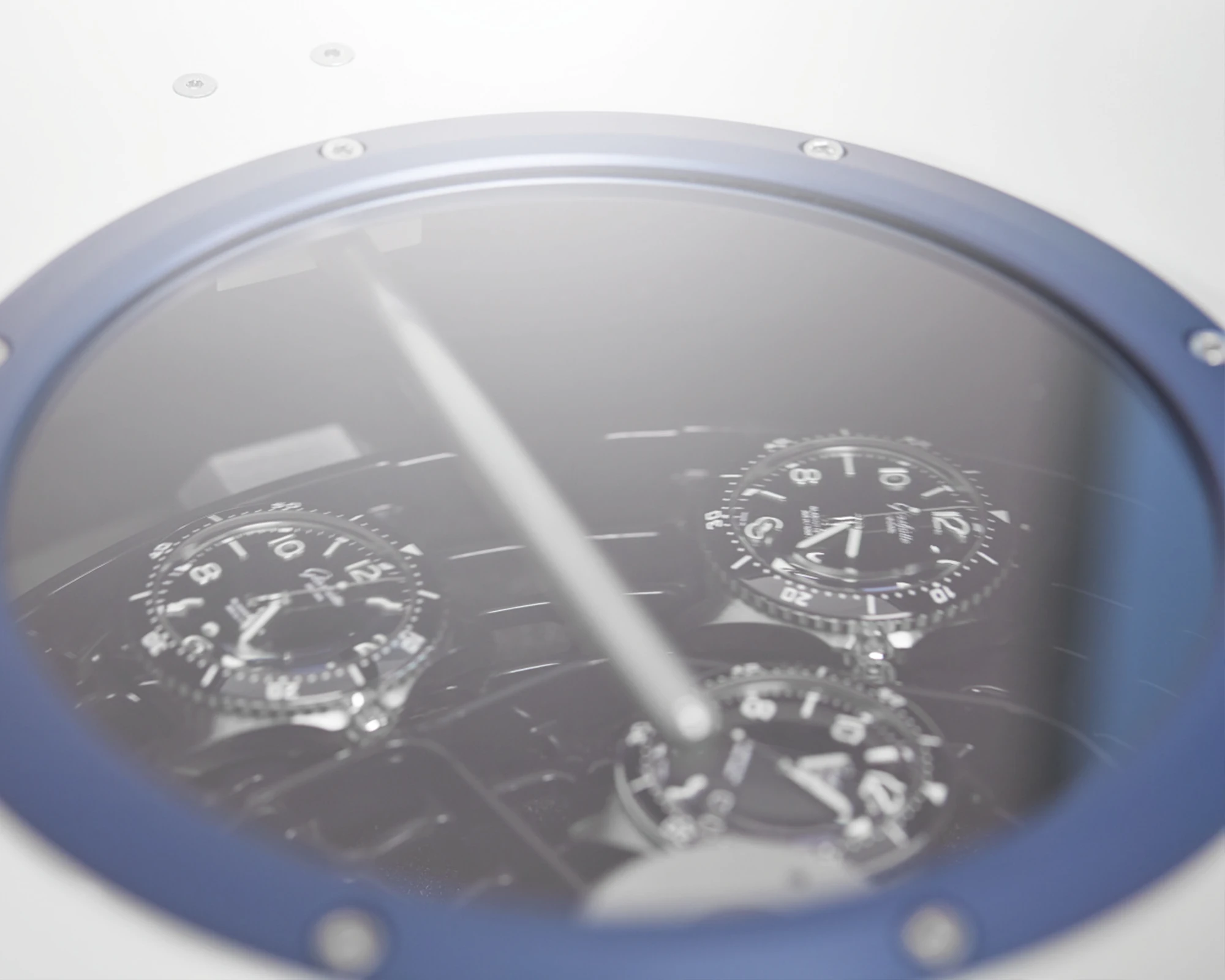
Shock resistance
Dropping a watch can happen to the best of us. A diver’s watch should also be able to withstand such an impact with little difficulty. When dropped from a height of one meter, a diver’s watch must be shock-resistant to be considered as such. Glashütte Original’s watchmakers use a special shock resistance testing device to ensure that the dials of the SeaQ models, for example, remain unbent and the hands intact. To protect it from corrosion, the dial of the SeaQ Chronograph, for example, is screwed to the plate using a high hexagon socket screw made of stainless steel.
24 days of testing
As already mentioned, the SeaQ Panorama Date models are subjected to additional and extended testing. Glashütte Original examinees all models with the Caliber 36 internally in a 24-day procedure but how exactly does this work?
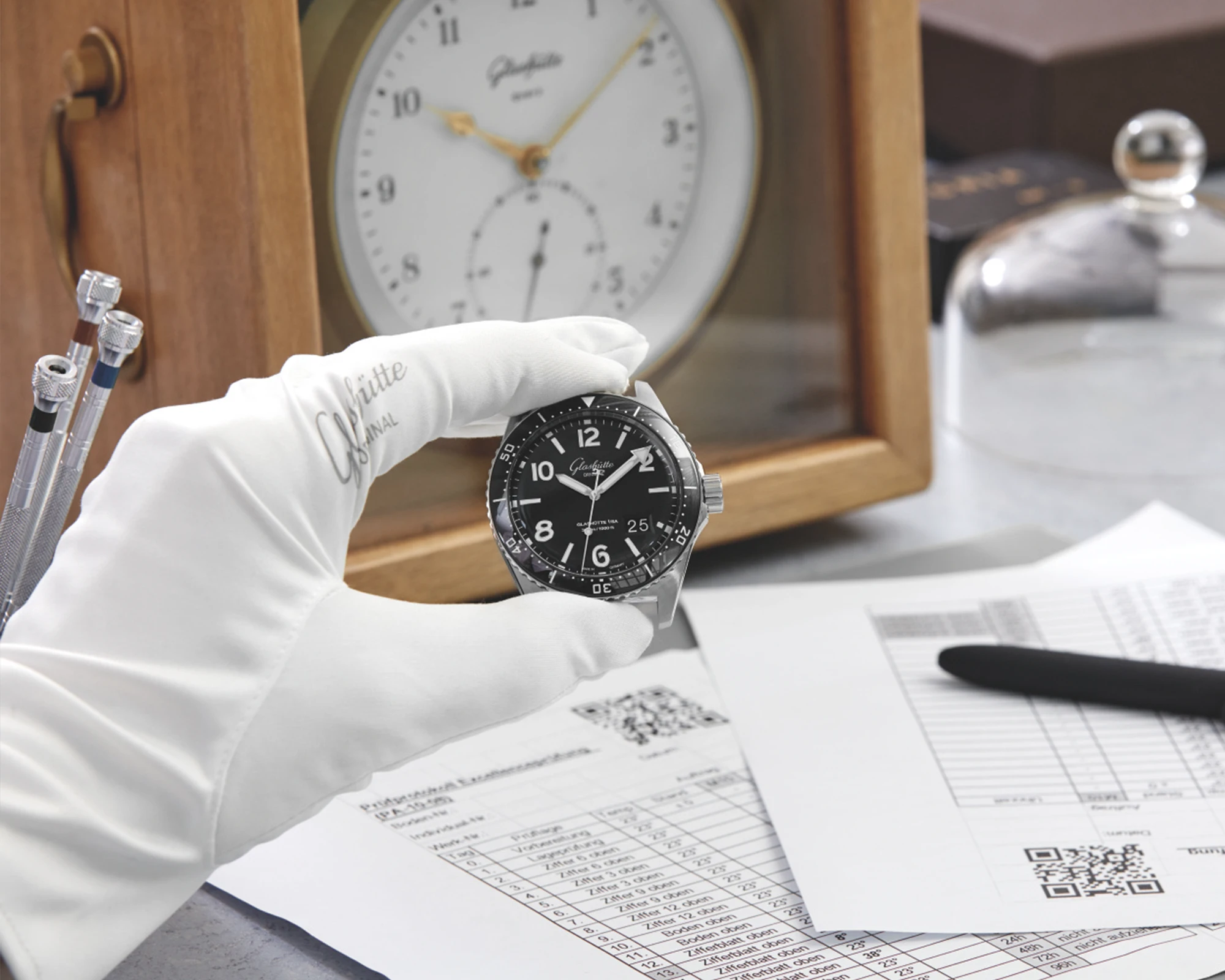
Once the exact time has been set, the first step is to check the rate deviation in six positions, with a tolerance range of between -2 and + 6 seconds per day. During this so-called position test, a rotating test device moves the models and thereby simulates various wearing conditions for 24 hours.
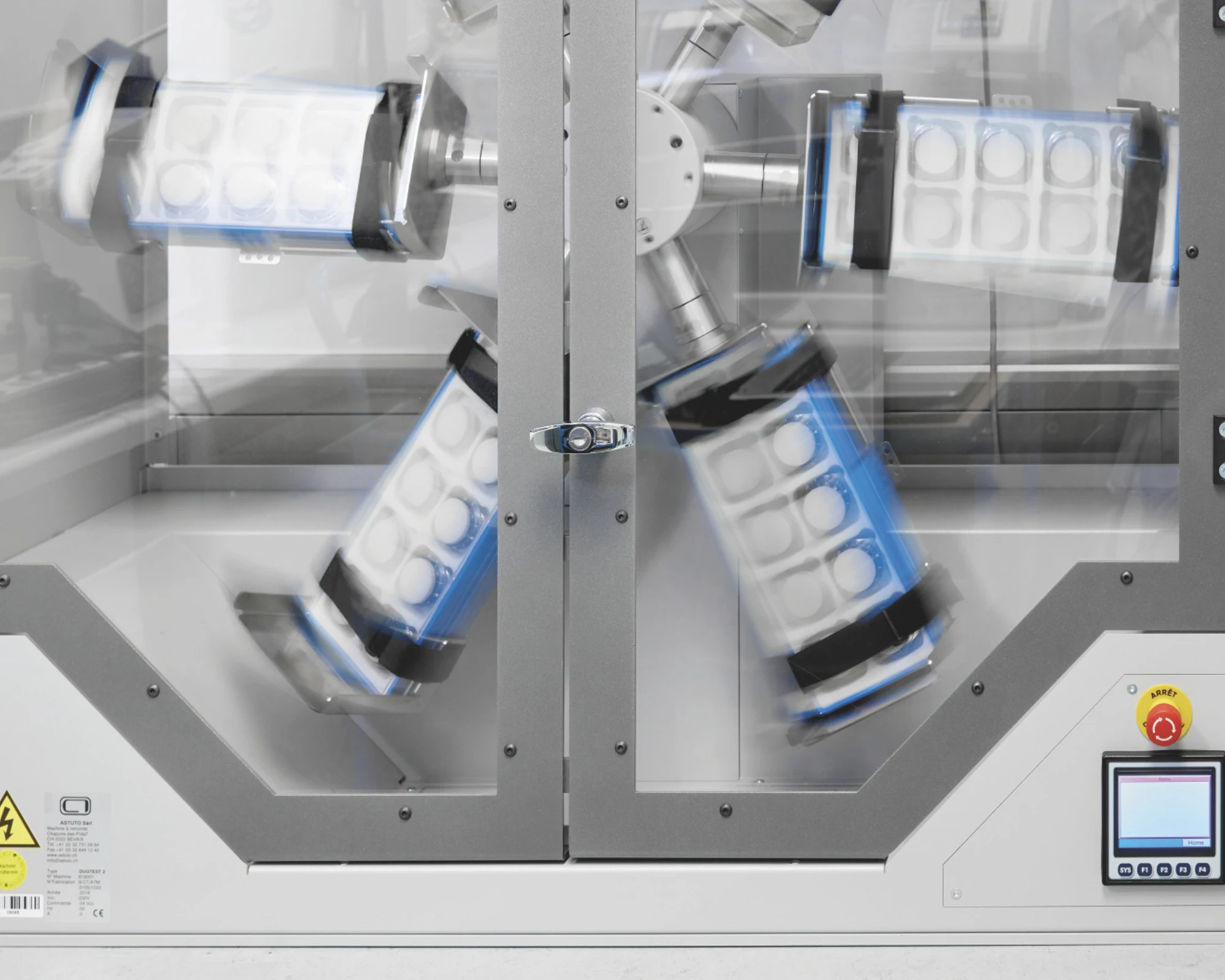
Passing these tests, which examine individual aspects in greater depth than the German chronometer test, is documented and confirmed by a certificate. From the second day onwards, the accuracy of the timepiece is put under the microscope for twelve days. Every two days, it takes up one of the six test positions. This means that Glashütte Original tests one more position than is usual for mechanical watches: the sixth position is the “numeral 12 up”.

The three-day temperature test takes place from the fourteenth day of the Excellence test.
Whether the movement can withstand temperature changes is tested from the fourteenth day in a three-day temperature test at 8, 23 and 38 degrees. To check the rate stability, the initial value at the beginning of the tests is compared with the value after the tests of the last 16 days. This is followed by a five-day check of the guaranteed total power reserve of 100 hours in the ‘dial up’ position.
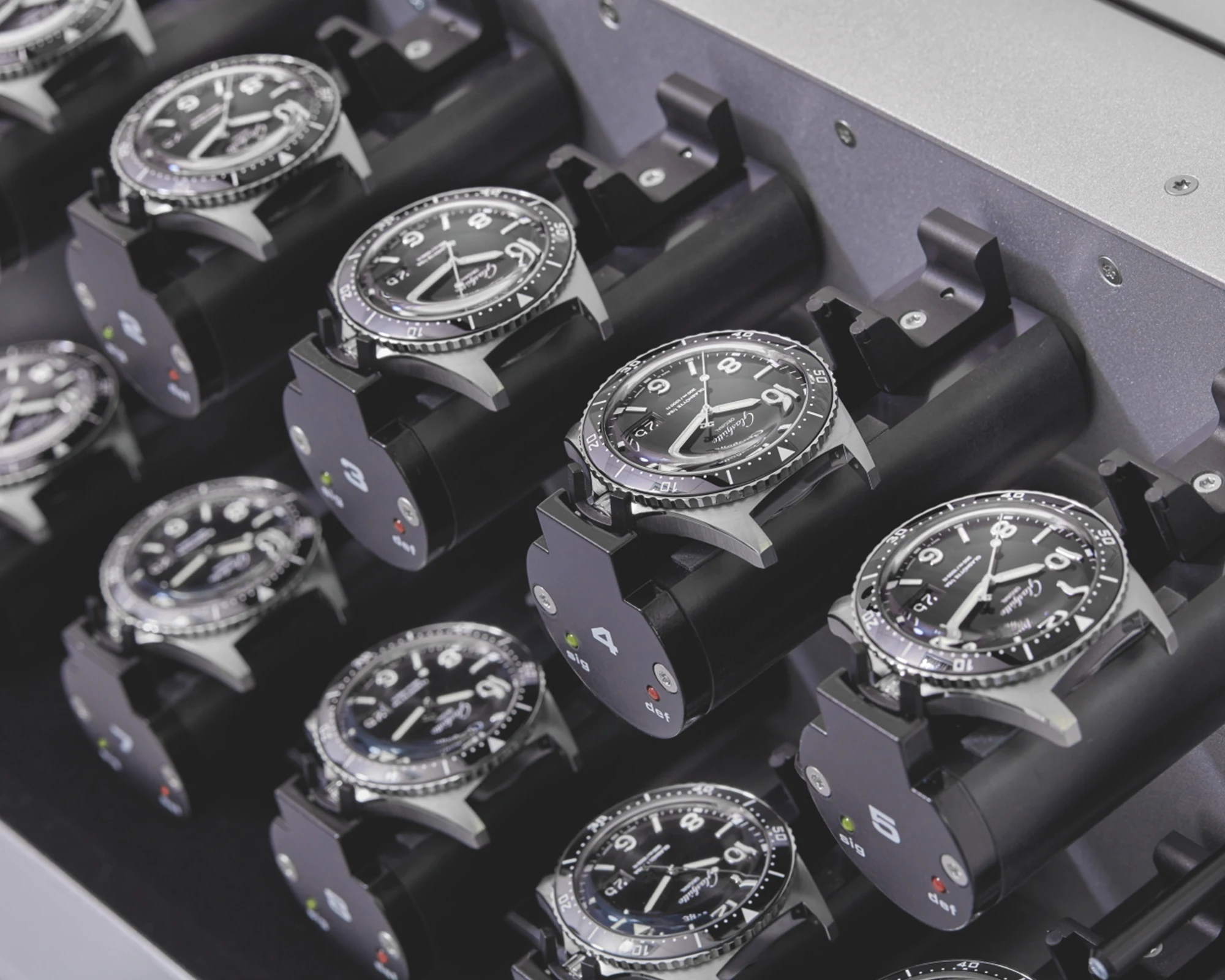
Checking the gait stability and total gait time.
On the penultimate day, the water resistance of 5 bar is tested using a vacuum bell jar and positive and negative pressure. Some models are then randomly sampled, heated to 40 to 45 degrees, and moistened with a drop of water to find out whether the watch contains moisture in the form of condensation. In a final step, an inspection on the surfaces’ finish and the manual winding’s and crown’s functionality is conducted.
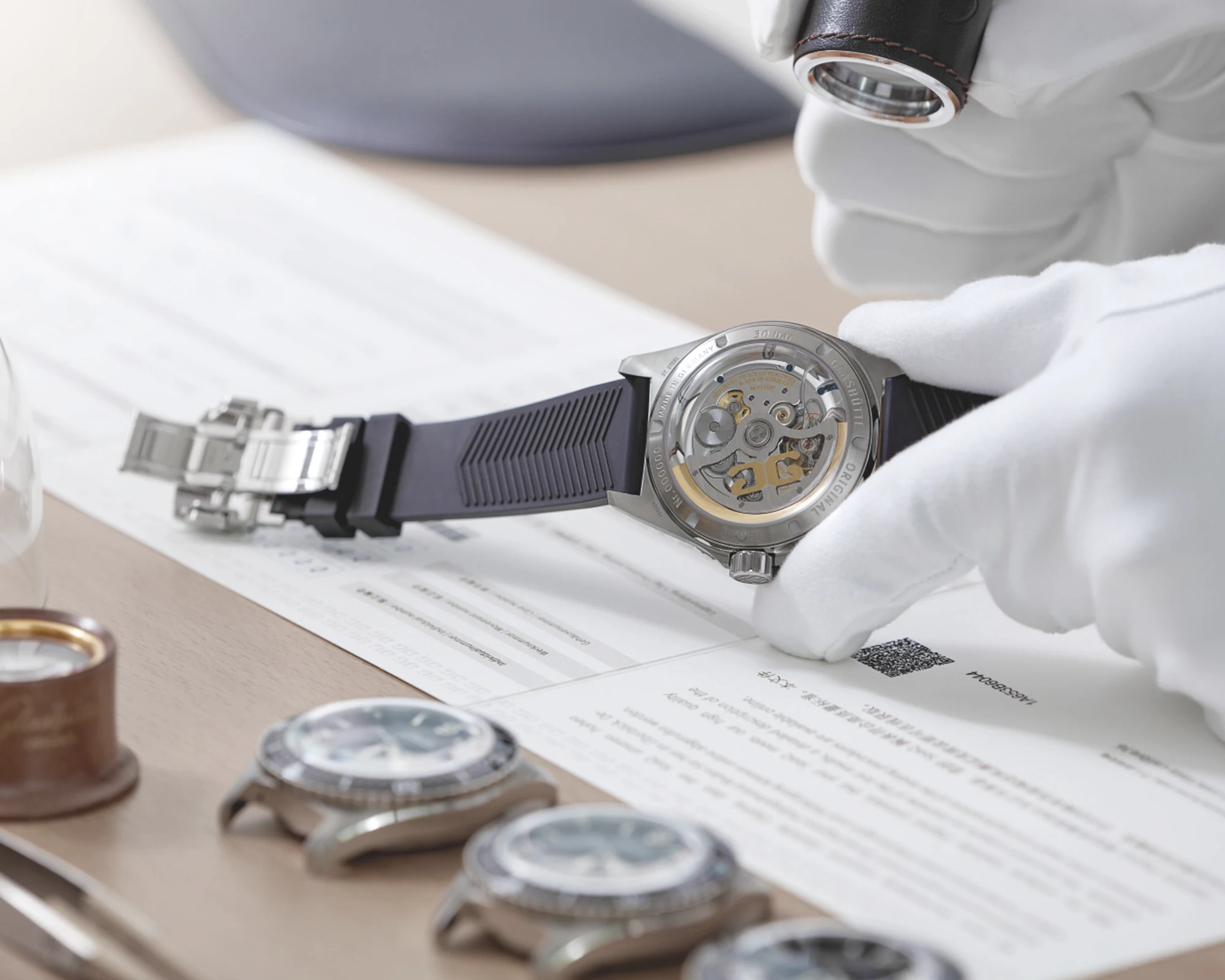
New strap colours premiering in 2024
With a wristwatch, the focus is unsurprisingly usually on the watch itself, but the strap is arguably just as important. It often determines whether a timepiece has a sporty or elegant appearance. To emphasise the SeaQ models’ versatility – whether worn with a diving suit or formal attire – Glashütte Original has launched two new straps to match the summer season and complement the existing options.

The straps with a pin buckle or folding clasp are made from a yarn that is 100 percent manufactured from recycled fishing nets. They come in a saturated green and orange. The muted shade of green is a beautiful alternative to the classic black, grey and dark blue strap colours, as it adds a subtle splash of colour to the wrist and is also easy to combine.

Those preferring a little more of an eye-catcher, should be right on trend with the orange strap. As the Milan Fashion Week predicted last year, orange makes for a bold statement this year. Both strap colours can be worn tone-in-tone with the SeaQ or combined with more contrast to the dial. Moreover, these strap colours are worldwide available for all other Glashütte Original models instead of a leather strap – both in the boutiques and at official concessionaires as well as in the Glashütte Original online boutique.
For adventures on land and at sea
With the Spezialist collection and its SeaQ models, the archetypal Spezimatic of the 1960s has evolved into a whole range of Glashütte-style diving watches that have remained true to their roots while being timeless yet contemporary since 2019. Glashütte Original has placed just as much emphasis on functionality as on refined details, which are showcased by the handmade Glashütte-style decorations on the in-house produced dial and the manufacture movements. As the thorough quality tests prove, the ‘Made in Germany’ label is not just a marketing slogan here, but carries real weight. Whether you opt for a regular SeaQ, the SeaQ Panorama Date or the SeaQ Chronograph depends on your personal preferences. However, the wide range of different material combinations and functionality levels means that there are various ways to wear and use the watch, whether with a diving suit in the sea or with a sporty-elegant look in a jacket for dinner.
